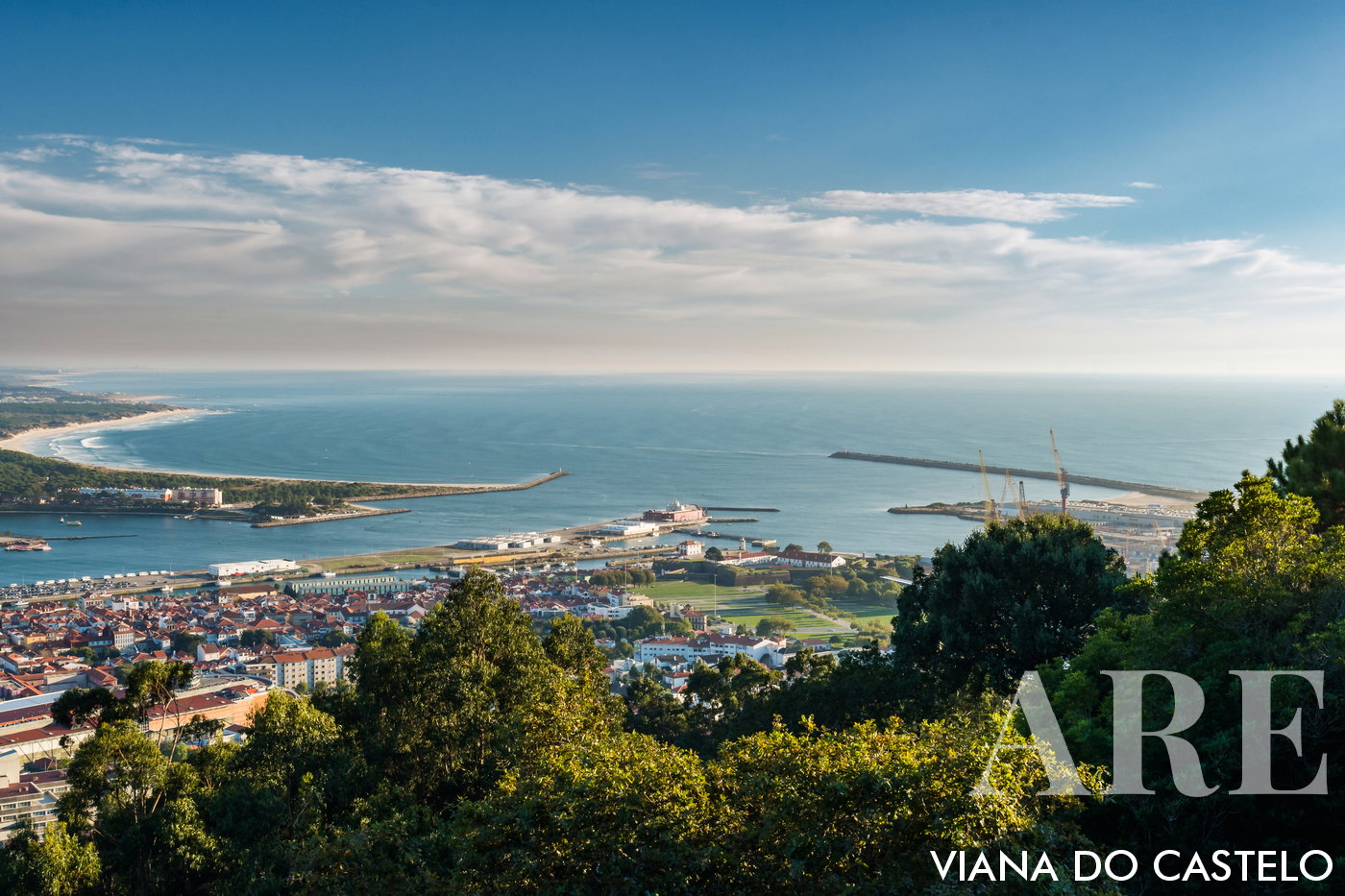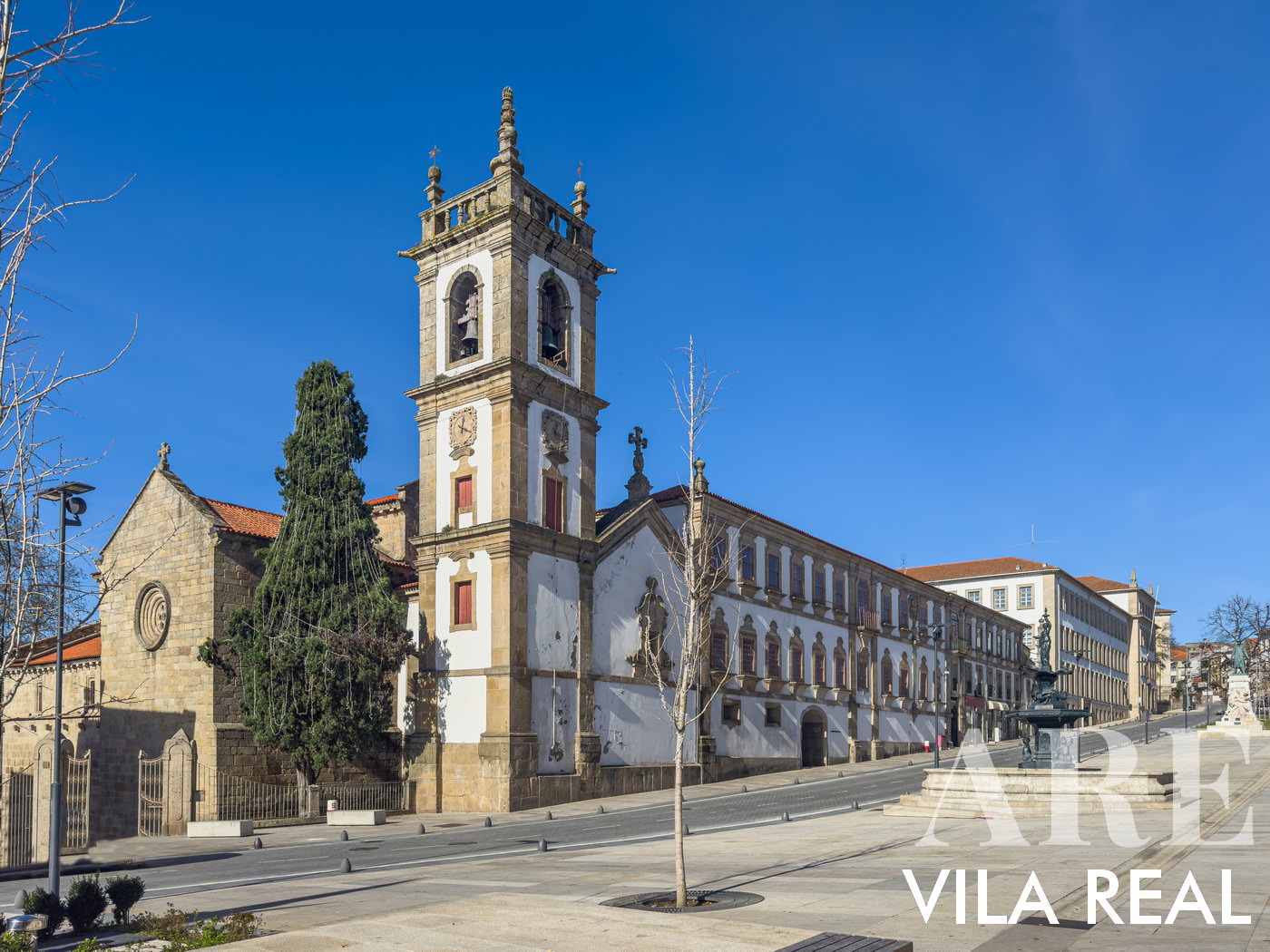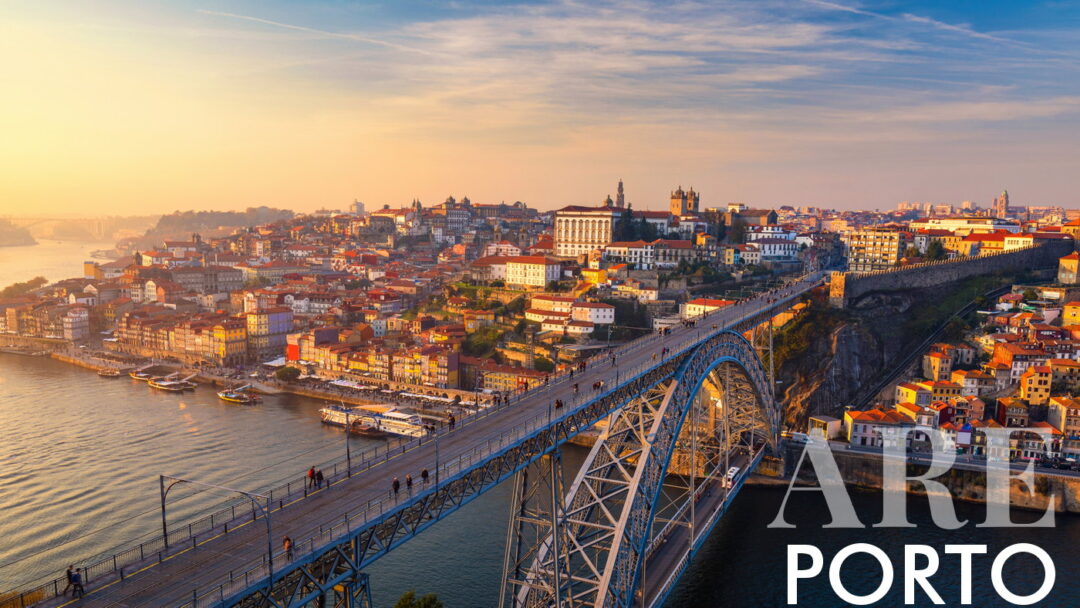
Porto, Portugal’s second-largest city, is renowned for its stunning Douro River views, iconic Luís I Bridge, famous Porto and Douro wines, and walkable, vibrant streets.
Porto is the most important city in northern Portugal, located on the right bank of the Douro River. A UNESCO-listed historic city
Porto, capital of northern Portugal
Porto is the most important city in the north of Portugal, located in the northwest of the Iberian Peninsula and on the right bank of the Douro River, with a temperate climate with average temperatures in June between 15º C and 25ºC. Autumn and winter are rigorous, rainy, and windy, with temperatures ranging from 5º C to 14º C. The northern capital received the award for Best European Destination in 2014 given by the European organization European Best Destinations.
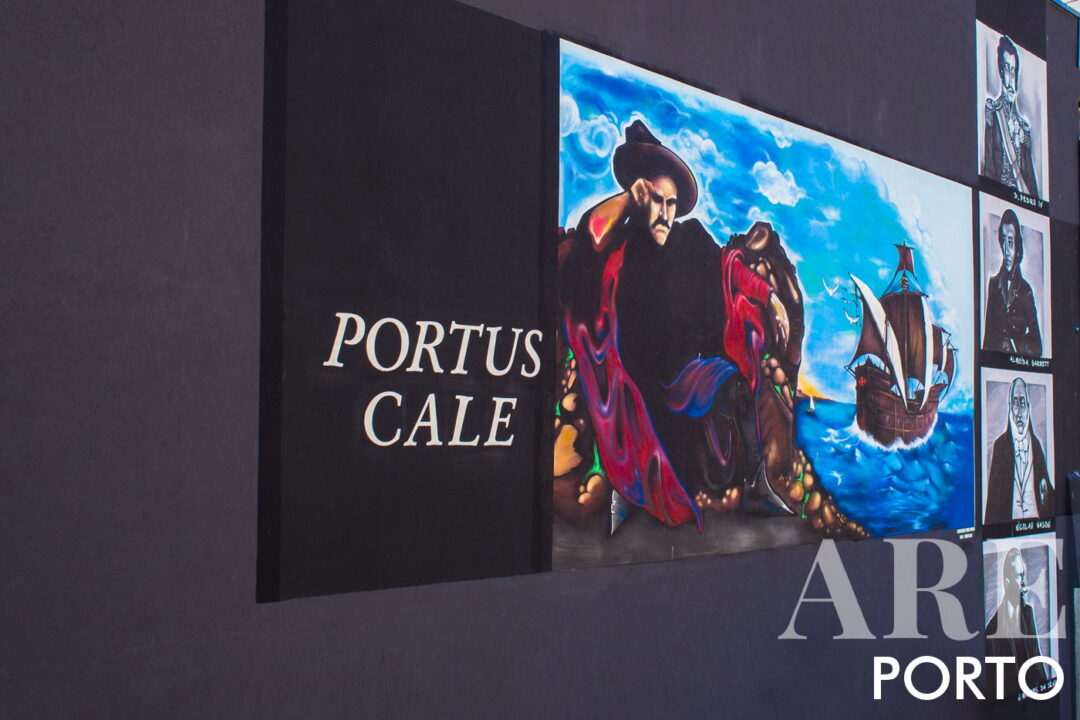
Porto, the city that gave Portugal its name through the combination of two words, Cale (currently Vila Nova de Gaia) and Portus (currently Porto)
Porto is worldwide known for its wine, for architecture, for being Cultural Heritage of Humanity by UNESCO since 1996, for its gastronomy and for hospitality of its people. It is the city that gave the name of Portugal through the combination of two words, Cale (now Vila Nova de Gaia) and Portus (now Porto). People born in Porto are known as “tripeiros” because in 1415 the population of this city offered all the meat available to the troops that were going to invade Ceuta in Morocco, leaving only the guts to eat. With them they created a unique dish in the country: Tripas à Moda do Porto. Porto is also called “Antiga, Mui Nobre, Semper Leal e Invicta” due to the courage of its people, for never having been occupied by foreign powers and never having a master to govern it. Important figures in the history of Portugal were born or lived in Porto, such as Infante D Henrique, the main person responsible for the Portuguese Discoveries, or figures of world importance such as the writer JK Rowling. The British writer was inspired by Porto and the Lello bookshop, in particular, to create the fictional character Harry Potter and the Hogwarts School of Witchcraft and Wizardry.
Attractions to visit in Porto (top 10)
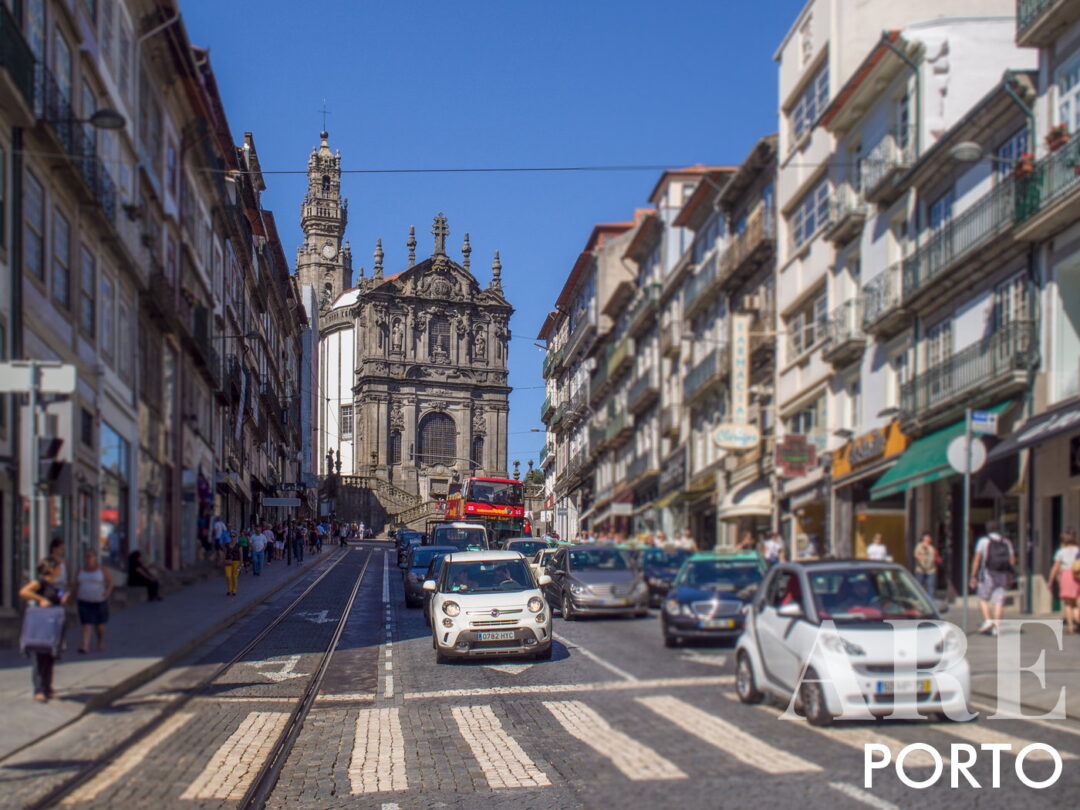
Rua dos Clérigos, with the church and Torre dos Clérigos on the horizon
1. Clérigos Church and Tower: The Clérigos Church and Tower is the hallmark of Porto, located at Rua de São Filipe de Nery. The Torre dos Clérigos was for many years the tallest tower in Porto and performed several functions, namely: Notice of the arrival of the boats in Ribeira and the money that came from England; Clock; It was through the bells that the death of a King or the birth of a Prince was signaled; The Meridiana was a mortar launched from the steeple of the tower to inform the city of noon time.
The Clérigos Church and Tower were built at the behest of the Irmandade dos Clérigos, created through the merger of three brotherhoods in 1707: Confraternity of Nossa Senhora da Irmandade dos Clérigos, Irmandade de São Pedro and the Congregation of São Filipe Nery. The construction project came about due to the need for the Brotherhood of Clerics to have a headquarters and a hospital that would support the poorest members. It was opened in 1763 in the Baroque style with a project by the Italian Nicolau Nasoni (1691-1773), an Italian artist born in Tuscany who arrived in Portugal in 1725 at the invitation of Frei Roque de Távora and Noronha, brother of the Deão da Sé do Porto , having lived in the city until he died in 1773. Nasoni was responsible for several projects, namely the renovation of the main chapel of the Sé do Porto, Igreja da Misericórdia, ceilings of the Palácio do Freixo, ceilings of the Sé Catedral de Lamego, Igreja do Lord of Bom Jesus de Matosinhos, Church of Santa Marinha in Vila Nova de Gaia and the Palace of Solar de Mateus in Vila Real.
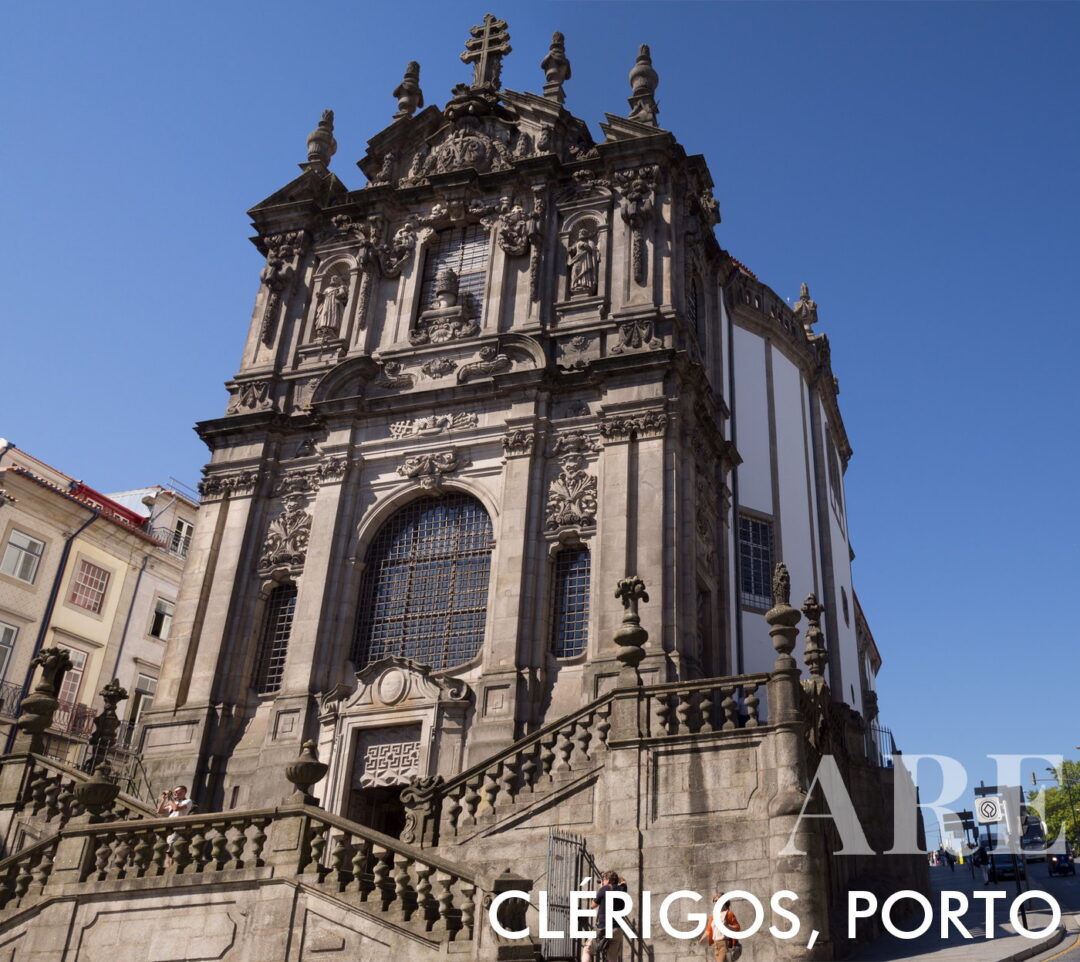
Facade of the Clérigos church
Highlights At Igreja dos Clérigos: The coat of arms of the Brotherhood of Clérigos; the chancel with a Rococo retable by Manuel dos Santos Porto; the altars of the Blessed Sacrament, of Nossa Senhora das Dores, of Santo André Avelino de São Bento; the wooden sculptures representing the co-patrons of the Brotherhood of Clerics: São Pedro ad vincula and São Filipe Nery; the 1774 Iberian pipe organ by Dom Sebastião Ciais Ferraz da Cunha; the statue representing Santo Emídio, the Patron Saint of Natural Catastrophes. This statue was offered by Lisbon to protect the northern city from earthquakes; and the polychrome marble throne where you can see the statue of the patron saint Nossa Senhora da Assunção.
At the Torre dos Clérigos: The tower was inaugurated in 1763, with a height of 75 meters, which allows to be seen from any part of the city of Porto, 225 steps and 49 bells; an iron cross; the image of São Paulo above the entrance door; and a 360º panoramic view over the city of Porto, the Atlantic Ocean, the Douro River and Vila Nova de Gaia.
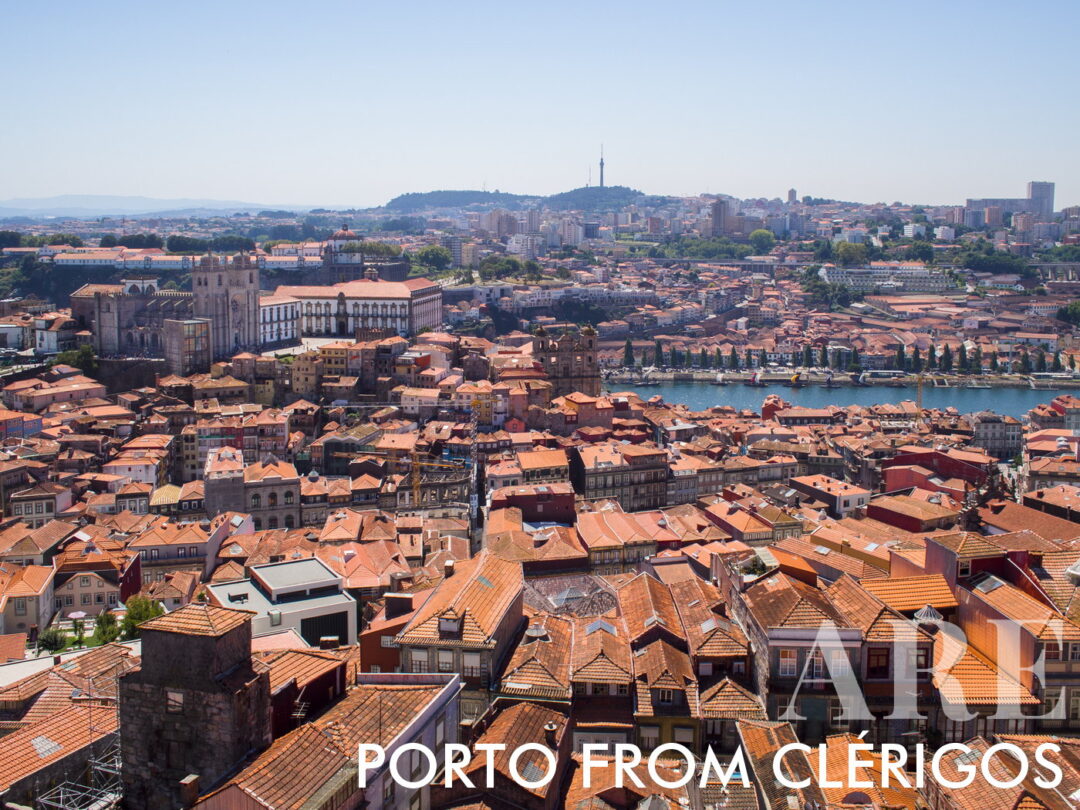
View from the clerics tower, the roofs of the buildings of Porto, the Cathedral, the church of São Lourenço, the river Douro and the south bank
At the Museu da Irmandade dos Clérigos: we can relive the daily life of the members of the Brotherhood of Clérigos and visit the Nobre room, an old Casa do Despacho. Brotherhood benefactors; the Vault room, with a highlight for the exhibition of jewelery pieces and the safe; the Nasoni room, site of the former Registry, where the Brotherhood documents were kept. Here we can observe the paper table where Nicolau Nasoni worked; the Alto choir, the space used by the Choir and members of the Brotherhood of Clerics. Here are exposed vestments (religious clothing) and the Holy Thursday Urn designed by Nicolau Nasoni; the infirmary, which operated until the end of the 19th century and houses the ~ Corpus Christus Collection , donated by António Cipriano Miranda. This exhibition is organized in three groups: Núcleo da Paixão; Journey of Forms; and Images of Christ; and the Núcleo da Paixão room, where we can observe the Steps of the Passion of Christ, namely: Predestination, Judgment, Path to Calvary, Calvary and Resurrection.
2. São Francisco Church: The São Francisco Church is one of the most important churches in the city of Porto, located at Rua de São Francisco. The church has a physical structure in Gothic style and the interior decoration in Baroque style, is one of the most exuberant churches in the country due to the more than 300 kg in gilded woodwork that were used to cover the interior of the medieval structure . The Convent of São Francisco do Porto was inaugurated in 1233 and the Church in 1264, having been successively changed between the 14th and 19th centuries. The current church was designed by Teodoro de Sousa Machado between 1795 and 1805, with the following points of interest:
- Tree of Life: the Tree of Life was rebuilt between 1718 and 1721 by Filipe da Silva and António Gomes, who were considered to be the greatest master carvers in the city of Porto This tree was built in the Retable of Nossa Senhora da Conceição and represents the family tree of the Holy Family with the Virgin Mary at the top of the tree, Jesse, father of David, in the center of the tree trunk, several kings of the tribe of Judah, Christ at the top of the tree. The Tree of Jesse represents the 14 generations that separate Jesse from Christ, including David, Solomon and the Virgin Mary. The Trees of Life, or Trees of Jesse, were built throughout Europe from the first, which was represented in the stained glass windows of the Basilica of Saint-Denis in Paris in the year 1144. In Portugal it is possible to observe Trees of Life in some places, namely the Church of São Francisco in Porto, the Church of the Convent of São Francisco in Estremoz, the Church of Santa Maria de Beja, the Church of the College of São Paulo in Braga, the Church of Caminha, the Church of Senhor do Bom Jesus in Matosinhos;
- Rosacea: it is the only structure that remains from the original construction of the 13th century. The rosette is relatively small and has the shape of a pentagram;
- Capela-Mor: highlighting the Tomb of the family of Pais Menezes, Marqueses de Abrantes and Condes de Matosinhos;
- Altarpiece of the Martyrs of Morocco: The Altarpiece of the Martyrs of Morocco was created by Manuel Pereira da Costa Noronha in 1750 to honor the sacrifice of five Franciscan priests beheaded in Morocco in the year 1220. This episode is particularly important for Portugal because the five priests were the first missionaries sent by San Francisco to North Africa, passed through Coimbra and were with Fernando de Bulhões, future Santo António, at the Santa Cruz Monastery of Coimbra before leaving for Morocco. The Five Martyrs of Morocco were Friar Vital, Priest and Preacher of the First Franciscan Order, Friar Berardo de Carbio, known for his preaching skills and native of Carbio in Italy, Friar Otto, Priest, Friar Pedro de Santo Geminiano, Deacon, native of Geminiano in Florence, Friar Adjuto and Frei Acursio, Professed Brothers. These five Franciscan priests passed through Andalusia, still a Muslim, where they were condemned for trying to convince the Islamic leader to be baptized. The Emir of Seville ordered deportation to Marrakesh, where they were received at the residence of Infante Dom Pedro, brother of Dom Afonso II. The missionaries decided to continue evangelization against the various warnings given by the Muslim authorities and by Infante Dom Pedro. The priests were eventually beheaded by order of the Almohad Caliph Yusuf al-Mustansir, known as Miramolim of Morocco. The corpses were recovered by Dom Pedro and sent to the Monastery of Santa Cruz de Coimbra, where it is still possible to observe the relics in five reliquaries. This episode in the History of the Order of São Francisco is important for Portugal due to the formation of the Portuguese Kingdom that was still in the beginning and needed political legitimation through religion; and it was the sacrifice of these five Franciscan brothers that led to Fernando de Bulhões joining the Order of São Francisco, the future Santo António.
- Chapel of São João Batista: it is the Chapel of the Carneiros family, built by João Carneiro, a former schoolmaster of the Sé de Braga in 1500. The chapel is composed of a physical structure from the 16th century and built in Manueline style, by Diogo de Castilho; with 16th century painting representing São João Batista, imported from Flanders (now Belgium), to Porto.
- Altarpiece of Martyrdom in Japan: 23 Franciscan Martyrs of Japan publicly crucified in the Japanese city of Nagasaki on February 5, 1597. The Vatican opted for canonization in 1627;
- Sepulchral Chapel of Luís Álvares de Sousa: The Sepulchral Chapel of the third Count of Baião, Luís Álvares de Sousa, was inaugurated in 1474. In this chapel, one of the oldest mural paintings in Portugal to represent the Senhora da Rosa, by António de Florentim;
- Chapel of Nossa Senhora da Soledade: built in 1765 and executed by Francisco Pereira Campanhã, it is considered the masterpiece of Rococo style in the city of Porto;
- Chapel of Nossa Senhora da Conceição: highlighting ~ Tree of Life ; the stone sculpture representing Nossa Senhora da Conceição; and the altar of Nossa Senhora da Boa Viagem;
- São Francisco Museum: a museum space where we can visit the Treasury Room, the Sessions Room and the Cemetery, located in Casa do Despacho. Casa do Despacho was inaugurated in 1749 with a project by Nicolau Nasoni with a facade with typical iron railings and the coat of arms of the Order above the entrance door, architecture by Nicolau Nasoni; the Sala do Tesouro, with a permanent exhibition on the history of the Venerable Third Order of São Francisco and its relationship with the city of Porto; and the Sala das Sessões, where oil paintings representing the institution’s benefactors are on display; canvases depicting the death of Santa Margarida de Cartona; screens depicting the Virgin and Child; the retable of Christ on the Cross in gilt carving, by José Teixeira Guimarães; the ceiling designed by José Martins Tinoco decorated with two coats of arms with the arms of the Order, by Dom José and Dona Maria Ana Vitória; the 14 armchairs dated 1748; and the golden silver Custody in Dom João V style, weighing 14 kg and a 16-pointed star decorated with precious stones;
- Catacumbal Cemetery: built after the fire that broke out in the Church and Convent of São Francisco in 1746, due to the fact that there are no public cemeteries in Porto (the first public cemetery was the Lapa Cemetery built in 1833) and with the aim of burying the benefactors and friars of the Order. This space was inspired by the Roman Catacombs and includes the tombs of all benefactors of the Order between 1749 and 1866. The main points of interest are the Altar with gilded baroque style; the Common Ossuary used since 1751, the year in which a decree was approved in which the places where the friars and benefactors were buried were defined if there was no space in the catacombs;
- Coffers-Urns: built in 1746.
3. Palácio da Bolsa: is the headquarters of the Porto Commercial Association, located at Rua Ferreira Borges. The Palácio da Bolsa is the homage of the city of Porto to Porto and English traders, to the virtues of Commerce (Imagination, Initiative, Determination, Dialogue and Prosperity) and is the place where it is possible to observe all Porto mythology. The Palácio da Bolsa began to be built after a fire that broke out in the Convent of São Francisco in 1832 on land expropriated due to the extinction of Religious Orders in 1834. The land was donated in 1841 by Dona Maria II to the first President of the Commercial Association of Porto , Ferreira Borges (1786-1838), to be the headquarters of the Porto merchants. Ferreira Borges was a Supreme Magistrate of Commerce in Porto, defender of the ideals of Political and Economic Liberalism, author of the Portuguese Commercial Code in 1833, one of the founders of the Porto Commercial Association and the Porto Court of Commerce. The Palácio da Bolsa building was designed by Joaquim da Costa Lima and built in several styles, namely Neoclassical, English Paladian, Romanticism and Neo Arabic. The main points of interest are:
- Palácio da Bolsa’s Arab Hall is the main attraction of the palace and considered by many to be the “living room of the city of Porto”. The Arab Hall took eighteen years to be built in plaster, wood and gold leaf, between 1862 and 1880 and was designed by Gustavo Adolfo Gonçalves and José Marques da Silva, in Neo Arab style. This hall has great symbolism for the palace and the city, as it represents the independence of Porto in relation to the centralism of Lisbon and highlights the importance of businessmen, entrepreneurs, traders and industrialists in the city. The decoration of the room has several characteristics, namely: the entrance door purposely off-center in relation to the room itself due to perfection only exists in Allah. This situation is common in most Muslim mosques; Arabic calligraphy on the walls and ceiling: on a magenta background with an Arabic inscription saying “Glory to Allah”; on the ceiling are the inscriptions painted on a blue background with the words “Allah will protect Sultana Dona Maria II”; and a shield with a green background with the inscription “Nobody is above Allah”; Coat of arms of the city of Porto located above the entrance to the Arab Hall, is the coat of arms approved on January 14, 1837 by Dona Maria II. The queen of Portugal approved this coat of arms as a form of recognition for the courage of the Porto population demonstrated during the Siege of Porto in the Civil War that opposed Liberals and Absolutists (1828-1834). The coat of arms of the Sala Árabe is considered to be the true coat of arms of the city of Porto by the people of Porto, represented with the Dragon on top of the coat of arms; the presence of the crown; the Arms of Portugal; and the shield to represent Nossa Senhora da Vandoma, the Patron Saint of the city of Porto;
This coat of arms is the previous one to the coat of arms currently used, being possible to be seen in other buildings and in the statutory of the city of Porto, namely in the Porto City Hall; at the Palace of Justice; at the Equestrian Statue of Dom Pedro IV located at Praça da Liberdade; at the Statue of Infante Dom Henrique in Jardim do Infante Dom Henrique; at Casa dos 24, located in the terreiro of Sé do Porto; and the Dom Pedro IV Mausoleum located in the Church of Lapa; built until 1933, the year in which the country’s Municipal Heraldry was renovated. - Pátio das Nações at the Palácio da Bolsa: is the entrance courtyard of the Palácio da Bolsa, with approximately 506 m2. The courtyard is the only remaining structure of the old São Francisco Convent and the space where the cloister was. The Pátio das Nações features the highlights of Six Pompean columns in cast iron that support the patio, the dome of iron and glass on the ceiling, designed by Tomás Soller, which illuminates the patio with natural light throughout the day. This dome, completely innovative at the time, was completed in 1881, eight years before the Eiffel Tower in Paris; the nineteen coats of arms designed by Luigi Manini to represent the 19 most important countries for Portugal at the commercial and political level; the mosaic on the patio floor, designed by Tomás Soller and inspired by the Greco-Roman mosaics that existed on the floors of houses in Pompeii. The mosaic has the representation of an electricity pole with the rays of electricity; a horn to symbolize the two nipples of a 19th century telephone and an envelope from the post office; the Cadecido, symbol of Mercury; and the representation of Mercury, the God of Commerce;
- Escadaria Nobre da Palácio da Bolsa: designed by Gustavo Adolpho Gonçalves e Sousa, with emphasis on the decorative work in granite, a unique work in Europe. The granite work lasted for many years and was led by Mestre Canteiro António Gonçalves de Barros. The main highlights are the grand staircase; the two chandeliers weighing a ton and a half by Soares dos Reis; the iron and glass skylight; the painting on the ceiling, authored by António Ramalho (1859-1916) representing “O Anjo de Portugal”, which symbolizes the connection to the Bragança Dynasty; Industry; Agriculture; and Culture; and the bust of Fontes Pereira de Melo, Prime Minister of the Kingdom, the last work by Soares dos Reis;
- Palácio da Bolsa Audience Room is the former Court Room, designed by Joel Pereira da Silva and subsequently renovated by the architect Marques da Silva. It is in this room where members of the Confraria de Vinho do Porto take office, being a symbol of the Bourgeoisie and the city of Porto. The main highlights of the Sala das Audências are the paintings by Veloso Salgado beginning in 1826 and representing various themes and personalities, namely the representation of Dom Dinis, the creator of the First Praça do Comércio or Bolsa do Porto in 1293; the representation of Infante Dom Henrique; the representation of the Vine, the Harvest and Agriculture; and the painting dedicated to the arts, with the representation of several painters, namely Afonso Domingues holding the model of the Monastery of Batalha, Domingos Sequeira, author of the Reis Magos painting, and Machado de Castro, author of the Equestrian Statue of Dom José I in the Terreiro do Paço in Lisbon;
- President’s Room at Palácio da Bolsa: with paintings painted in oil representing the Roman Period and the economic activities of Porto by Marques de Oliveira and painted in 1890; and the marble fireplace by Teixeira Lopes;
- Commercial Telegraph Room: where is the first telegraph to operate in Portugal, between 1852 and 1954. This telegraph communicated between the Palácio da Bolsa and Foz, an independent area of the city, where the Englishmen and the wealthiest businessmen in Porto. This telegraph predates the creation of the Public Telegraph Service by Fontes Pereira de Melo in 1855 with the creation of three lines of communication: Sintra and Lisbon, Porto and Lisbon and Porto and Elvas;
- Office of Homage to Gustave Eiffel: Gustave Eiffel was working at the Palácio da Bolsa between 1875 and 1877 and performed several works in the North of Portugal;
- Sala Dourada: where the Board of Directors of the Commercial Association of Porto meets every Monday. The association consists of fifteen elected and unpaid members representing fifteen sectors of activity. The highlights are the stucco ceiling decorated in detail with gold fiber; the furniture designed by Marques da Silva; and the portraits of former presidents;
- Palácio da Bolsa Library: the Library is not visitable however it has as points of interest the two 19th century Globes: one representing the earth’s surface and the other the sky; the portrait of Ferreira Borges from 1836 by José Alves Ferreira; and the ceiling painting representing Eco, the Messenger of the Universal Language by António Carneiro.
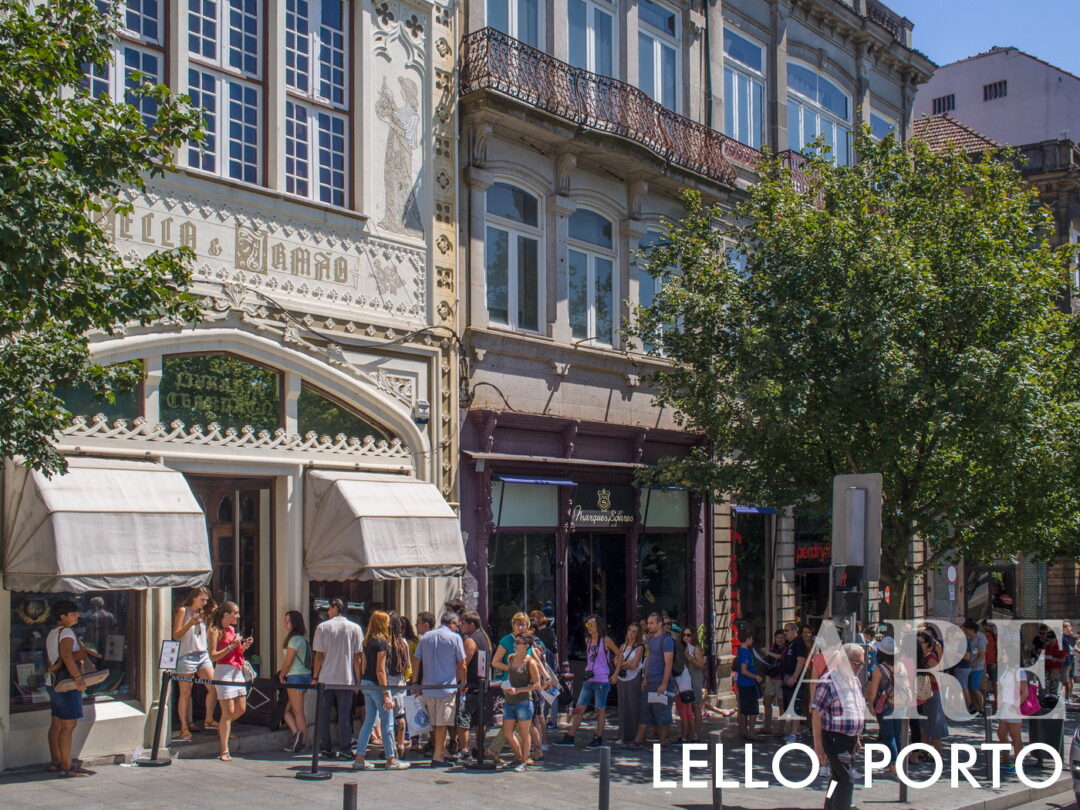
Queue at the entrance to Livraria Lello
4. Livraria Lello: Livraria Lello is one of the most beautiful bookstores in the world, located at Rua das Carmelitas. The bookstore was opened in 1906, but its origins date back to 1881 in Rua do Almada, where the first Lello Brothers bookstore was created. The bookshop was designed by Xavier Esteves (1864-1944) in Neo Gothic style on the grounds where the Convent of São José and Santa Teresa das Carmelitas Descalças were located. The main points of interest of Livraria Lello are the interior of the bookstore with low reliefs in the Aesthetic style and Art Noveau representing José Lello and António Lello; the busts representing some of the most important Portuguese writers, especially Antero de Quental, Eça de Queiroz, Tomás Ribeiro, Guerra Junqueiro, Camilo Castelo Branco and Teófilo Braga; the imposing central concrete staircase with steps painted red; the extremely decorated ceiling and dominated by a stained glass window eight meters long, 3.5 meters wide and 55 glass panels with the following Latin inscription: “Decus in Labore”, which means “Dignity at Work”, the motto of the Bookshop Lello; and the existence of rails on the floor where wagons were placed that carried the books inside the bookstore; the main façade built in Neo-Gothic style with representation of Art and Science by José Bielman.
5. São Bento Station: São Bento Station is one of the main railway stations in Porto and one of the most beautiful in the world, located at Praça Almeida Garrett, it is also one of the largest stations in the city of Porto , featuring a 60-meter-long, 20-meter-high façade, seven entrances and windows at the top of each entrance and an open front patio with over 500 square meters. São Bento Station includes one of the most popular rail routes in the country, the connection to the Douro Railway Line, namely the connection to the small and beautiful village of Pinhão, where 90 are located % of the farms responsible for the production of Port Wine. São Bento Station was opened in 1916 at the site where the Convent of São Bento de Ave Maria was demolished. The Convent was founded in the 16th century at the request of Dom Manuel I and delivered to the nuns of the São Bento Rule. The São Bento station is by Marques da Silva (1869-1947) and the tiles that decorate the station are by Jorge Colaço (1862-1842). Marques da Silva was one of the most important architects in the city of Porto and responsible for several works, especially Casa de Serralves; the National Theater of São João; the Rodrigues de Freitas High School; the Alexandre Herculano High School; the Monument dedicated to the Peninsular War at the Rotunda da Boavista, and the tiles by Jorge Colaço (1862-1842). Jorge Colaço was the author of several important projects throughout the country, namely the tile panels of the Palácio-Hotel do Buçaco, located on the main staircase and vestibule representing the Battle of Buçaco and episodes of the Discoveries in India and Africa; the Tiles of the Lost Steps of the Faculty of Medicine of Lisbon; the tiles of Casa do Alentejo in Lisbon; the Exterior of the Church of Ildefonso in Porto; the exterior of the Church of the Congregates of Porto; the Banks of Jardim do Pescador Olhanense, close to Olhão Market; the Buenos Aires Maternity Model Hospital; the Palace of President Marshal Monreal in Cuba; and Private Residences in São Paulo, Rio de Janeiro, Havana and Montevideo;
The São Bento Station has the following points of interest:
- The tile panels depicting episodes from the History of Portugal, representing The Encounter of Arcos de Valdevez, located to the left of the entrance to the station, depicts the Arcos de Valdevez Tournament, which held in 1140 between knights of Portugal and Leão. It was this tournament that allowed the independence of Portugal in 1143 due to the victory of the Portuguese knights against the Leonese knights; the Delivery of Egas Moniz, this tile panel located to the left of the station entrance, represents Egas Moniz, Dom Afonso Henriques’ aio, meeting Afonso VII de Leão and Castile in 1127 during the siege of city of Guimarães. Egas Moniz promised Afonso VII that Dom Afonso Henriques would continue to vassal him. The promise allowed the siege to be lifted, but the future Portuguese King changed his mind and ignored the promise. There are many doubts as to whether this episode really happened or not, but it appears portrayed throughout the history of Portugal and is part of the founding myths of the country; the Wedding of Dom João I and Dona Filipa de Lencastre: this tile panel, located to the right of the entrance to the station, represents the wedding of Dom João I to Dona Filipa de Lencastre in 1397 in the Porto Cathedral. This wedding was held to formalize the alliance between Portugal and England signed in 1387 and considered the oldest in the world; and the Conquest of Ceuta: this tile panel represents the Conquest of Ceuta that took place on August 2, 1415, traditionally considered as the date when the Age of Discovery began. Infante Dom Henrique is represented here, responsible for the Discovery strategy, born in Porto and son of Dom João I and Dona Filipa de Lencastre. Infante Dom Henrique organized the fleet that attacked Ceuta from the city of Porto;
- Tiled panels representing the evolution of transport over time, especially the Roman Car; the Roman Quadrigas; the Transports used during the Arab Invasions of the Iberian Peninsula; the Transports used during the Muslim Invasion of the Iberian Peninsula; the 16th century carriage parade; the Mala-Posta Representation, name given to the Post Office; and the Representation of the arrival of the first train on the Porto-Braga line, which opened in May 1875;
- Tiled panels representing economic and cultural activities, namely Commerce; Agriculture; Industry; the Fine Arts; the literature; and Music;
- Tiled panels representing the Four Seasons of the Year: Spring; the summer; the fall; and winter;
- Tiled panels with representations of religious festivities: representation of the Pilgrimage of São Torcato, a parish of Guimarães. São Torcato was a Bishop of Braga in the 8th century murdered in São Torcato, Spain, on May 15, 715 by Muslims. São Torcato was killed with 27 faithful, according to the legend, buried in the place and when it was dug up a fountain with healing water was born. The Pilgrimage of São Torcato is always held on the first weekend of July and serves as a way of thanking the good harvest of the flax in March and April; the tile panel with the Procession of Nossa Senhora dos Remédios, represents the Procession of Nossa Senhora dos Remédios in Lamego. Devotion to Nossa Senhora dos Remédios or Bom Remédio started in 1213 through the foundation of the Order of the Holy Trinity in Rome by São João da Mata and São Félix with the aim of building a Hospital to recover some Christians who had been enslaved in the North of Africa. According to the legend, Nossa Senhora dos Remédios appeared with a bag full of money that she gave to São João da Mata and São Félix, so that they could build the hospital. The pilgrimage and oldest sanctuary in Portugal are the Pilgrimage of Nossa Senhora dos Remédios in Lamego and the Shrine of Nossa Senhora dos Remédios, in the same location.
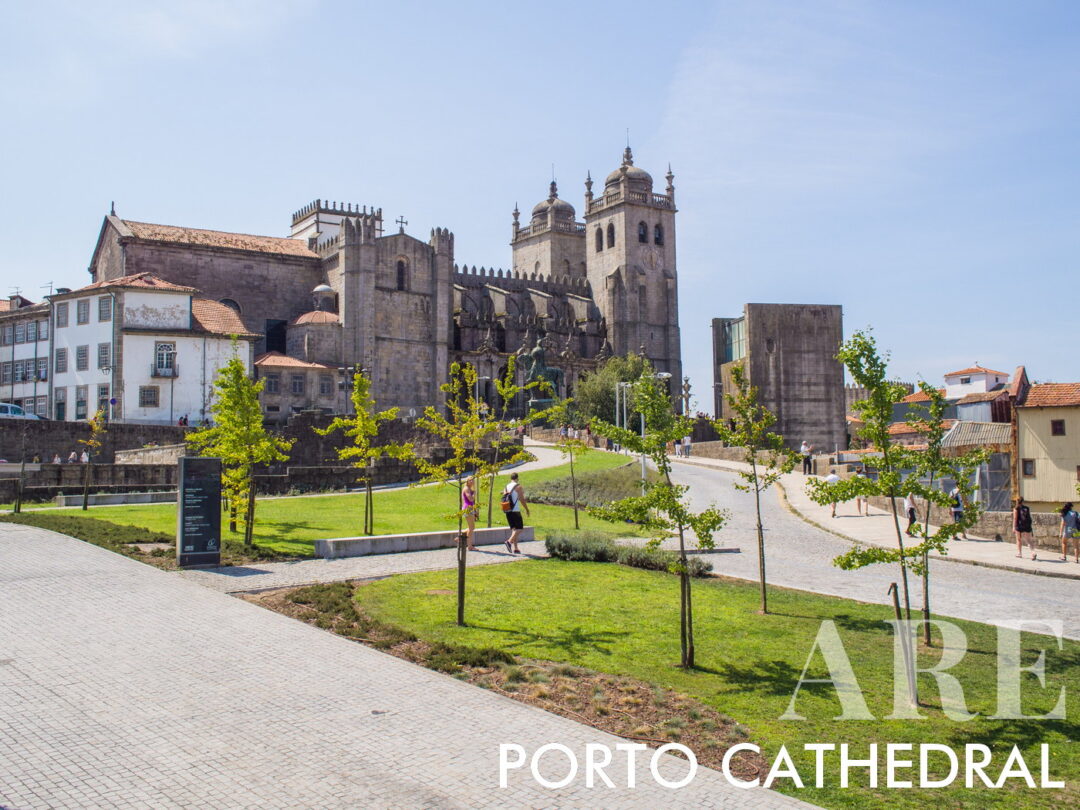
Porto Cathedral is also known as Morro da Sé or Morro da Pena Ventosa, where the city of Porto was born
6. Porto Cathedral: The Cathedral is the most important religious temple in the city of Porto, located in Terreiro da Sé, also known as Morro da Sé or Morro da Pena Ventosa, where the city of Porto Porto was born. The Cathedral was built and enlarged between the 12th and 19th centuries, which makes it possible to observe various artistic styles, namely the Romanesque, the Gothic and the Classicizer. The Cathedral of Porto was built by Dom Hugo, the first Bishop of Porto and according to the records, the first stone of the Cathedral was laid by Dona Teresa, the mother of Dom Afonso Henriques, and finished during the Reign of Dom Dinis. The points of interest of the Porto Cathedral are:
- a Main façade, highlighting the 13th century Rosette built in Romanesque style; the entrance portal built in Rococo style, opened in the 18th century; and the image to represent Nossa Senhora da Assunção, the patron saint of the Cathedral, painted in the 18th century;
- the João Gordo Chapel: opened in 1333 in the Gothic style. João Gordo was a knight of the Order of Hospitallers who served King Dom Dinis;
- the Cloister: built by Dom João I in Gothic style from 1385, with successive improvements throughout history. The main points of interest are the eight Baroque portals designed by Nicolau Nasoni and built between 1726 and 1727; and the seven Tile Panels built in the second half of the 18th century with various representations, namely the Scenes of the “Canticle of Songs”; a divine dialogue between God and the patron saint of the See; and the Representation of the “Psalms of David”;
- Escadaria Nova: opened in 1736, with access to the second floor of the cloister. The project was designed by Nicolau Nasoni;
- Lateral galilee: this galilee, or loggia, was designed specifically for the city. The loggia is a large space, decorated with columns, arches and which generally offers a wide view. This space was designed by Nicolau Nasoni and built in the Baroque style in the year 1736;
- Capela-Mor: built in 1610 in Mannerist style with a project by Frei Gonçalo de Morais. The main highlights are the Altar-Mor by Santos Pacheco and Miguel Francisco da Silva, built between 1727 and 1729 in Baroque Style; the mural paintings by Nicolau Nasoni; the Two pipe organs from the 17th and 19th centuries; and the medieval sculpture representing Nossa Senhora da Vandoma, the Patron Saint of the city of Porto;
- Organ of the Alto Choir: designed by Georg Jann, also author of the organ of the Church of Lapa;
- Chapel of Nossa Senhora do Sacramento: highlight to the silver altar inaugurated in 1632, with successive changes until the 19th century;
- Casa do Cabido: a building from the 18th century, located next to the Cathedral with religious sculptures from the 14th to the 18th centuries; and tile panels by Vital Rifarto from 1733.
7. Igreja da Lapa: it is the Church of the Venerable Brotherhood of Nossa Senhora da Lapa, located in Largo da Lapa. The Brotherhood of Nossa Senhora da Lapa was founded in 1757 by Father Angelo Sequeira, a Brazilian missionary known for his devotion to Nossa Senhora da Lapa and for his great oratory skills. The Church of Lapa was built after a mass given by Father Angelo Sequeira at the current location of the church, in which he asked Our Lady of Lapa to end a storm that had lasted for several weeks in the city of Porto, which according to the legend happened after the end of the ceremony. The Church of Lapa was inaugurated in 1755 as the Chapel of Nossa Senhora da Lapa das Confessions in Campo de Gemalde, on the old medieval road connecting Porto and Braga. The current church began to be built in 1757 and lasted for more than a hundred years, with a project by the architect José Figueiredo Seixas. It was in the Church of Lapa that Dom Pedro IV prayed practically every day while he was surrounded with approximately 7500 men by Dom Miguel’s 40,000 soldiers between 1832 and 1833; The Church built in the year Mozart was born; It is the space where the heart of Dom Pedro IV is preserved; and the site is the largest pipe organ in Portugal;
The points of interest of the Church of Lapa are:
- the Dom Pedro IV Mausoleum designed by Costa Lima and built in granite, considered the stone of Porto. The granite used in the mausoleum was taken from some of the fortifications that had been used during the Siege of Porto;
- the Bell Towers of the Church of Lapa built in the second half of the 19th century with a project by José Luís Nogueira Júnior. The west tower was completed in 1855 and the east tower in 1863;
- o Relógio built for eight days with a project by Joaquim José Marques;
- the Pipe Organ is the tallest pipe organ in Portugal, opened in 1995, with 34 tons, 14 meters high, 10 meters wide, 5 meters deep, 4307 tubes, 4 manual keyboards and a chime with 42 bells;
- Capela-Mor: highlighting the altarpiece opened in 1806, by the engraver Manuel Moreira da Silva;
- Nossa Senhora da Lapa Cemetery: it is the cemetery of the Porto elite and the oldest Romantic cemetery in the country, opened in 1833. This space was built in response to the cholera epidemic and the high number of deaths that resulted of the Siege of Porto. The cemetery is the place where personalities like Ferreira Borges are buried; Marques da Silva; Camilo Castelo Branco; Arnaldo Gama; Soares dos Passos; and João António de Freitas Fortuna.
The cemetery’s attractions are the Chapel of the banker Joaquim Pinto Leite, the first chapel built in marble in the North of Portugal; the Chapel of Visconde de Lagoaça, who was Mayor of Porto and responsible for the creation of the first public urinals or urinals; the Mausoleum of José Ferreira Borges; the Mausoleum of Bishop Elected Dom Manuel de Santa Inês, an important figure during the Siege of Porto; the Mausoleum of Colonel Pacheco, hero of the Siege of Porto; and the Mausoleum of João da Silva Ribeiro, the founder of the cemetery;
- Nucleus of Camilo Castelo Branco: Camilo Castelo Branco became a member of the Irmandade da Lapa two months before committing suicide. In this space it is possible to know the Documentation that reports the process of transferring the body of Camilo Castelo Branco to the Cemetery of Lapa; the revolver with which Camilo Castelo Branco committed suicide; and the Letters of the widow Ana Plácido with Freitas Fortuna, the businessman from Porto who owns a bookstore in Rua das Flores frequented by the Portuguese writer;
- Nossa Senhora da Lapa Hospital: it is one of the most important private health units in the city of Porto, located in Largo da Lapa. This hospital was built due to the financial support of Dona Luzia Joaquina Bruce, a benefactor of the Irmandade da Lapa. Dona Luzia Joaquina Bruce was born in Maranhão and married João António Lima, a Porto businessman who got rich in Brazil. The Lapa Hospital was built to honor João António Lima, who had died a few years before the construction of this health institution began. The tribute includes the placement of a statue representing the husband on top of the Hospital;
- Colégio da Real Irmandade de Nossa Senhora da Lapa: The Colégio da Real Irmandade de Nossa Senhora da Lapa lasted until the beginning of the 20th century, at a time when the number of children in the city of Porto drastically decreased. This school became one of the most important schools in the city of Porto.
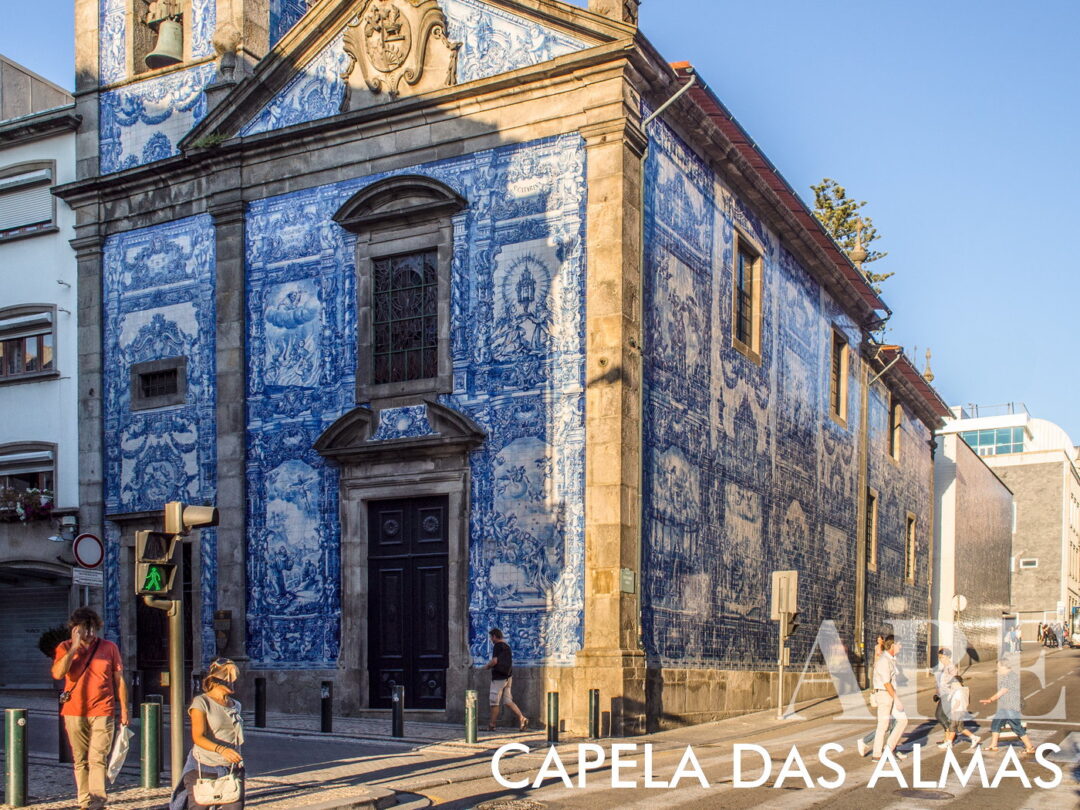
Capela das Almas, an 18th century chapel covered with 15,947 tiles by Eduardo Leite and were executed by the Viúva Lamego Ceramics Factory in Lisbon
8. Capela das Almas: it is an 18th century chapel located on Rua de Santa Catarina known for more than 15 thousand tiles that we can see on the façades. This chapel is also called Capela de Santa Catarina and was built in the first half of the 18th century. The main highlights are the facades with approximately 16 thousand tiles by Eduardo Leite from Fábrica de Cerâmica Viúva Lamego. The tiles were inaugurated in 1923 and represent scenes from the life of São Francisco de Assis and Santa Catarina; the image of Our Lady of Souls from the 18th century; and the High Altar with a panel representing the Ascension of the Lord and an image of the Risen Christ.

Bolhão Market in Porto with colorful fruits and vibrant local life
9. Bulhão Market: Bulhão Market is the most important market in Porto, located at Rua Formosa. The Bulhão Market is one of the emblematic buildings in the city of Porto, where even today it is possible to observe the women tripeiras selling fresh products and singing the famous auctions to attract customers. The Bulhão Market was opened in 1917 with a project by António Correia da Silva and owes the name “bolhão” because it was a panatanous area where there was a large water bubble, the “bolhão” as it was popularly known. The Bolhão Market is being restructured and modernized with a project by the architect Nuno Valentim, with the aim of preserving the original features of the building and adopting modern spaces, namely a Logistics Cave that will allow loading and unloading in a tunnel under the Rua Formosa and Alexandre Braga, or direct access to the Bolhão Metropolitan Station. The main points of interest are the activity of people in the market, the main facade of the building in the Beaux Arts style; the stone sculptures by Bento Cândido da Silva that represent Mercury and Flora, the gods of Commerce and Agriculture; the roof with slate tiles; the four spiers located in each of the four corners of the Market square; the central gallery where it is possible to observe a wide open space where the stalls of fresh products, flowers and plants can be found; and the second floor with a dining area.
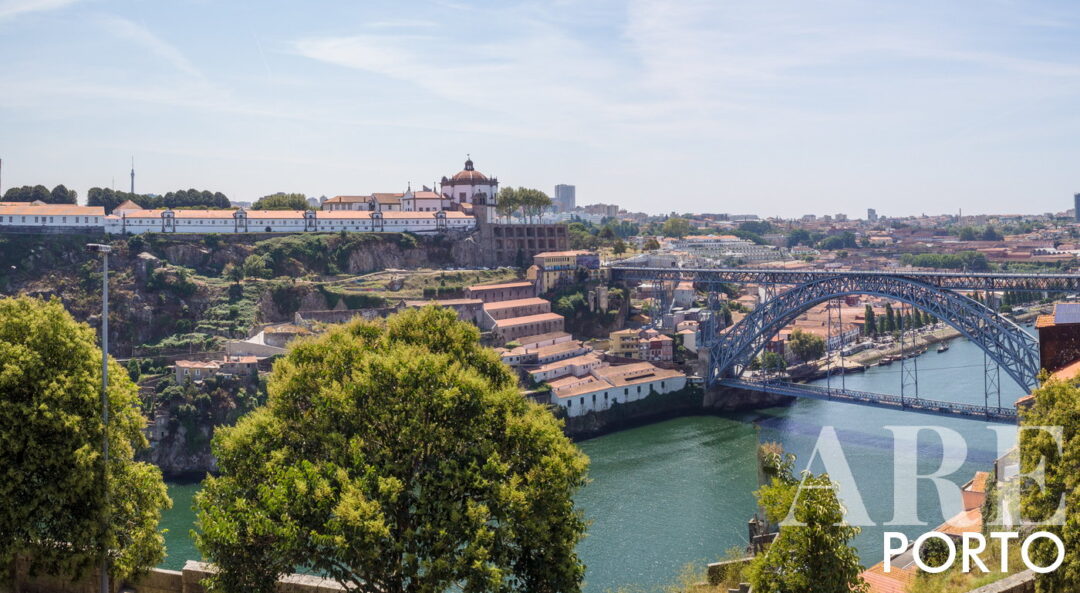
Serra do Pilar Monastery, one of the most notable buildings of European classical architecture. The church was classified as a National Monument in 1910. In 1996, the Luís I Bridge and the Historic Center of Porto became classified as Unesco World Heritage
10. Nossa Senhora do Pilar Monastery: it is a 16th century monastery, located in Largo de Aviz in Vila Nova de Gaia, built between 1537 and 1670 in this place in order to transfer the monks of the Order of Augustines Barefoot from the Monastery of Grijó, were also known as Crúzios because they had their headquarters at the Monastery of Santa Cruz de Coimbra; having the monastery in a strategic location that would allow the city of Porto to be controlled in case of conflict; allow the urban development of the city of Porto and create a support structure for the people of Porto. For many centuries, monasteries were built outside the cities or on the edge of the village to serve the poorest populations in the most varied areas, namely food and medical care;
The Monastery of Nossa Senhora do Pilar, classified UNESCO World Heritage, is so named due to the presence of an image of Our Lady of Pilar that has been in the Main Chapel since 1678. Our Lady of Pilar is the target of a great devotion in Spain because it appeared to Saint James and eight other faithful when they were seated, and disillusioned by the lack of adherence to the Christian faith, on one of the banks of the river Ebro in Zaragoza. Our Lady then appeared on a marble pillar and asked for a temple to be built at the site of the apparition. This miracle took place in the year AD 39, the year in which the Cathedral of Zaragoza began to be built. The image found in the Nossa Senhora do Pilar Monastery was transported from Zaragoza to Lisbon in 1677 and offered to the city of Porto by Prior Lisbon’s Dom Fernando Cruz, a believer in Nossa Senhora do Pilar, with the aim that this image would help the cult to spread across the north of the country. This image is the first copy of the original that is currently in the Cathedral of Zaragoza.
The Monastery of Nossa Senhora do Pilar played important roles in the History of Portugal, namely during the siege of Napoleon’s troops to the Portuguese and English troops led by Wellington, and during the Siege of Porto (8 September 1832-18 August 1833 ) that occurred during the Civil War between Liberals and Absolutists. The Serra do Pilar Monastery was designed by João de Ruão and Diogo de Castilho with the points of interest: the view over the city of Porto, Vila Nova de Gaia and the Douro River; o Cloister innovative in relation to the time, with a circular rather than a square plan. The cloister was built in the Renaissance style with 36 Ionic columns. Renaissance men considered the circular shape to be divine perfection; the Church: it was rebuilt in 1598 at the request of Prior Dom Acúrsio with emphasis on the image of Nossa Senhora do Pilar from 1678; the Altarpiece of Jesus Christ built by Francisco Correia and inaugurated in 1568; the Northern Heritage Information Center: with information on Monuments and Museums in the Northern Region and the four UNESCO World Heritage sites in Northern Portugal, namely the Historic Center of Porto; the Historic Center of Guimarães; the Douro Wine Region; the Côa Archaeological Park; and Zimbório: from where we can observe the city of Porto and the Douro River.
Other places to explore in Porto
Soares dos Reis National Museum: The Soare dos Reis National Museum is the oldest art museum in Portugal, located at Rua de Dom Manuel II, the museum was opened in 1833 with the designation of “Porto Museum of Paintings and Prints” in the building of the current Municipal Library of Porto and later transferred in 1940 to the current Palácio das Carrancas. The museum’s collection began with works and goods confiscated from the Church after the abolition of Religious Orders in 1834. In 1911 it changed its name to National Museum of António Soares dos Reis (1847-1889) in order to honor António Soares dos Reis, considered among the best Portuguese sculptors of the 19th century, author of works such as “O Desterrado”. The museum presents as points of interest: works by Soares dos Reis; paintings from the Romantic period by Francisco José de Resende, João António Correia, Miguel Angelo Lupi or Luís pereira de Meneses; Naturalist style paintings, namely Silva Porto, Columbano or José Malhoa; a collection by Henrique Pousão (1859-1884); 17th century Portuguese faience pieces; and 17th century Japanese Namban screens, also available at the Museu do Oriente in Lisbon.
Porto Botanical Garden: The Porto Botanical Garden is the first garden dedicated to the study of the flora of the city of Porto, located at Rua do Campo Alegre. The Botanical Garden was opened in 1852 in the former ~ Convento das Carmelitas ^ and transferred in 1951 to the current location at Quinta do Campo Alegre, the home of the grandparents of the writer Sophia Mello de Mello Breyner Andresen and a place that fascinated all lovers of botany in the city of Porto due to the great variety of plants, flowers and trees that existed there. Américo Pires de Lima (1886-1966), director of the Institute of Botany at the University of Porto, was primarily responsible for the purchase and adaptation of Quinta do Campo Alegre in the current Botanical Garden since 1951. The main highlights are: Casa Andresen; the Roseiral; the greenhouses; the Jardim dos Catos; and Jardim dos Jotas.
Casa do Infante: it is a museum located at Rua da Alfândega in the heart of the historic center, it was the former Alfândega Régia and place where Infante Dom Henrique was born. The Casa do Infante or Alfândega Régia e Casa da Moeda was built from 1325 with the aim of being the home of the Almoxarife da Alfândega do Porto. According to tradition, it was common for Dom João I and Dona Filipa de Lencastre to sleep in the houses of the storekeepers in villages where there were no royal palaces. On March 4, 1394, Infante Dom Henrique was born in this space near Ribeira do Porto.
The building has performed several functions throughout history, namely Casa do Almoxarife do Porto, Alfândega, Casa da Moeda and Municipal Historic Archive of Porto. The Casa do Infante’s points of interest are the Interpretative Center “The Infante Dom Henrique and the New Worlds”, where themes of the History of the main events of the Portuguese Discoveries are reported; and the Roman Findings of the 4th and 5th centuries.
Paço Episcopal: it is a museum, the official residence of the Bishop of Porto and the Diocese of Porto, located in Terreiro da Sé. The Paço Episcopal was rebuilt in 1737 with a project by Nicolau Nasoni in style Baroque at the desire of Bishop Dom Rafael Mendonça (1717-1793). The Episcopal Palace has performed several functions throughout the history of Portugal, namely: the Wedding of Dom João I with Dona Filipa de Lencastre in 1386; the visit of Francisco de Borja in 1560; the holding of meetings of the Board of the Supreme Kingdom Government in 1808 to decide what measures to take against Junot, General de Napoleão Bonaparte; it was an important place of defense during the Siege of Porto; it was the first Public Library in Porto; and it was Paços do Concelho between 1916 and 1956 while the Avenida dos Aliados building was being built;
The points of interest in the Paço Epíscopal building are: the view over the city of Porto; the garden; the main facade of the building built in the Baroque style with 24 windows with wrought iron balconies built in the Baroque style and the coat of arms of Bishop Dom Rafael de Mendonça; the noble staircase built in granite; the chapel built in the 19th century; the portraits of several Bishops of Porto distributed throughout the space of the Paço Episcopal; the Sala dos Espelhos with two large mirrors built in Baroque style and a rug offered by the Porto City Council in 2010; the Audience Hall, still used today by the Bishop of Porto Dom António Francisco dos Santos; and the Throne Room, where the Bishop of Porto takes office.
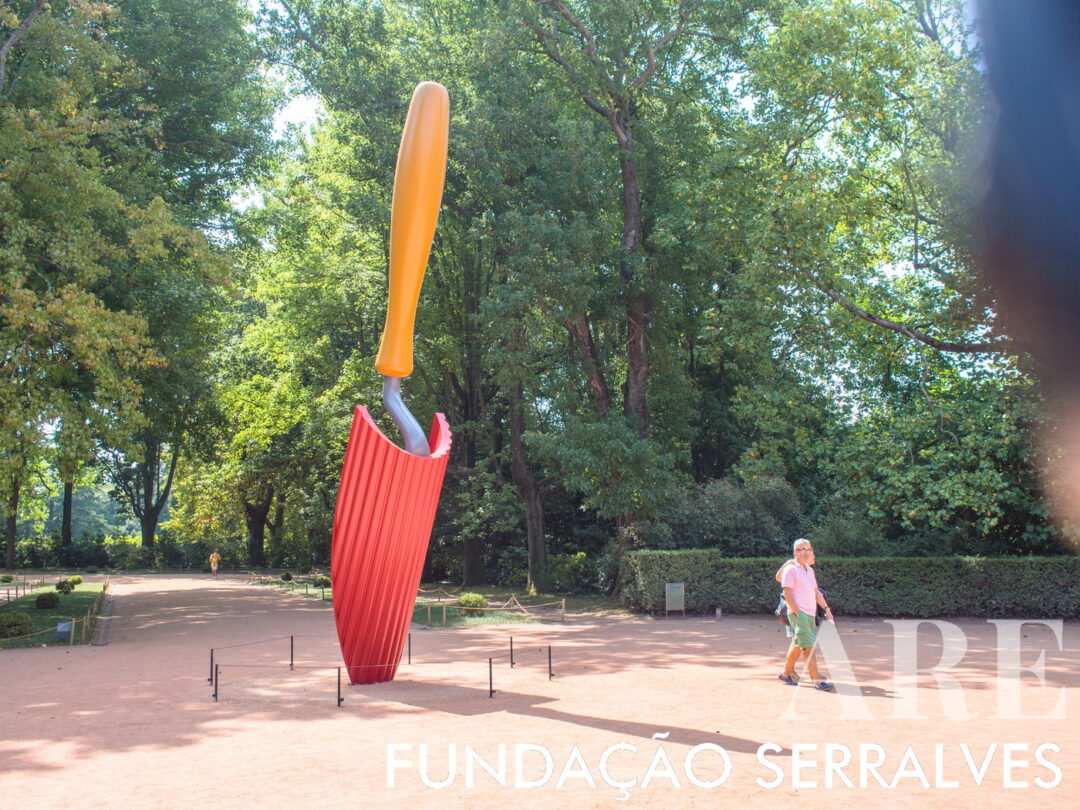
Serralves Foundation is the most important cultural activity center in the city of Porto
Fundação Serralves: Fundação Serralves is the most important center of cultural activity in the city of Porto, located at Rua Dom João de Castro. The Serralves Foundation was legally created in 1989 and the Museum of Contemporary Art was built between 1991 and 1999 with a project by Álvaro Siza Vieira, being visited every year by more than 500 thousand visitors for various cultural activities, namely Serralves em Festa and Serralves in Autumn. The foundation consists of several institutions, namely:

Contemporary art museum of the Serralves Foundation with several temporary exhibitions every three months, which interact with the Serralves Park and the Serralves House
- Museum of Contemporary Art, located in the North of Quinta de Serralves, opened in 1999 with a project by Álvaro Siza Vieira, it is one of the most important contemporary art museums in Portugal. The museum offers three temporary exhibitions simultaneously every three months, which interact with Parque de Serralves and Casa de Serralves, an Art Deco building in Portugal. The museum presents as points of interest: the 14 exhibition rooms; the Educational Service Room; the library; and the Auditorium.

Casa Serralves is the most important example of Art Deco in Portugal, built between 1925 and 1944 with a project by Charles Siclis and José Marques da Silva
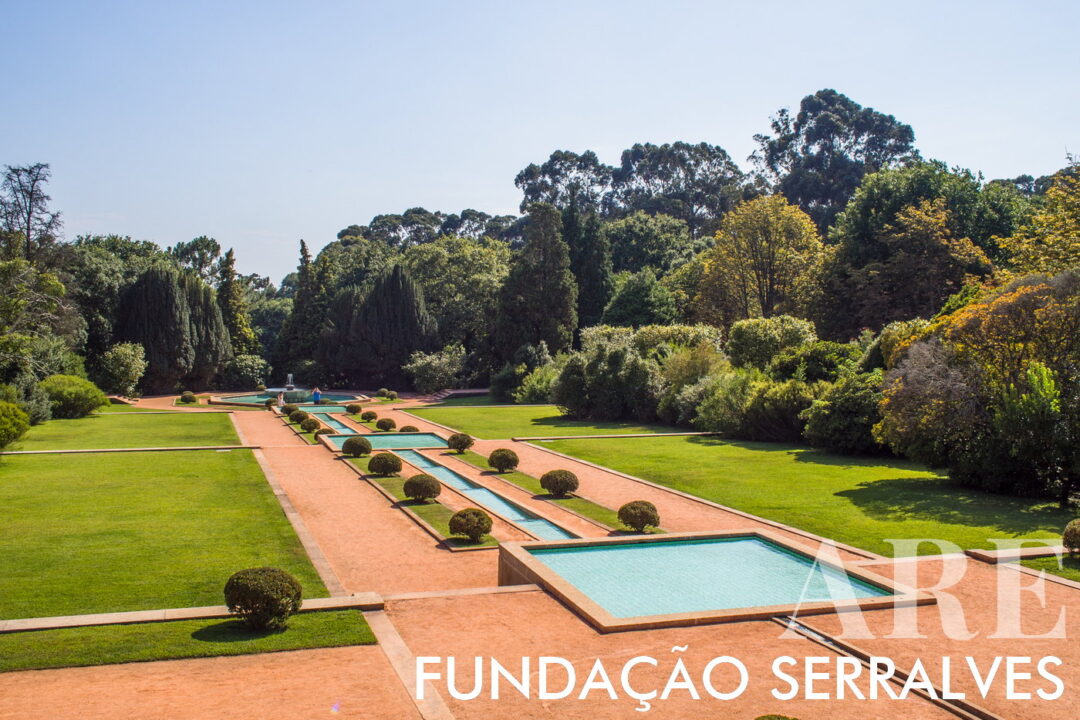
The garden at Casa Serralves, a lawn area with cascading water spread and a fountain, surrounded by Serralves Park,
- Casa de Serralves: the Casa Serralves building is the most important example of Art Deco in Portugal, built between 1925 and 1944 with a project by Charles Siclis (1889-1944) and José Marques da Silva for to serve as the residence of Carlos Alberto Cabral, entrepreneur of the Textile Industry, according to Conde de Vizela (1895-1968). The Casa de Serralves building was acquired by the Portuguese State in 1987 with the aim of creating a museum of contemporary art. The main highlights are: the Chapel built in 1882 and walled inside the building; the interior of the building, with emphasis on the circular bathroom, accessible through several rooms with a large window, bathtub carved directly in marble and decoration of the walls with marble; and the Suites with sliding partition;
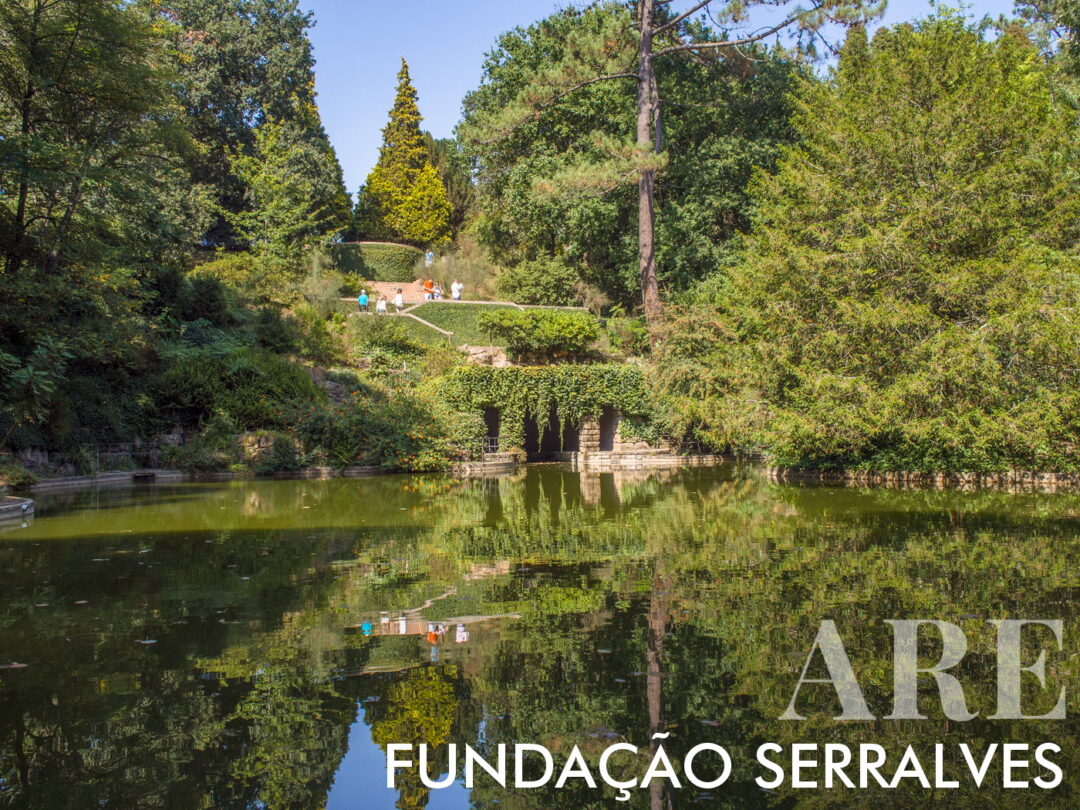
Serralves Park with approximately eighteen hectares of gardens and landscaped spaces
- Parque de Serralves: Parque de Serralves has approximately eighteen hectares of gardens and landscaped spaces with a project by Jacques Gréber. The Serralves Park is one of the Foundation’s main attractions due to: the Treetop Walk, a recyclable wooden walkway approximately 260 meters long, suspended between 1.5 and 15 meters high. The project was opened in 2019 with a project by Carlos Castanheira; the Quinta do Mata Sete lake built in a Romantic style; the Miradouro do Lago, built in Art Deco and in the Romantic style; the Cool Summer Zone, with Parterre, a lake with water games designed by Marques da Silva in 1927, located at the top of the park, opposite the old dining room at Casa Serralves; the tennis court; the Pergola; the Geometric Rose Garden;
Fauna and flora: The park has several animal species, trees, flowers and plants, namely: Dwarf bats: it is considered one of the smallest mammals in all of Europe; the Blackbirds; Red-breasted Piscos; the Salamandra de Pintas Amarelas; and the Green Frog;
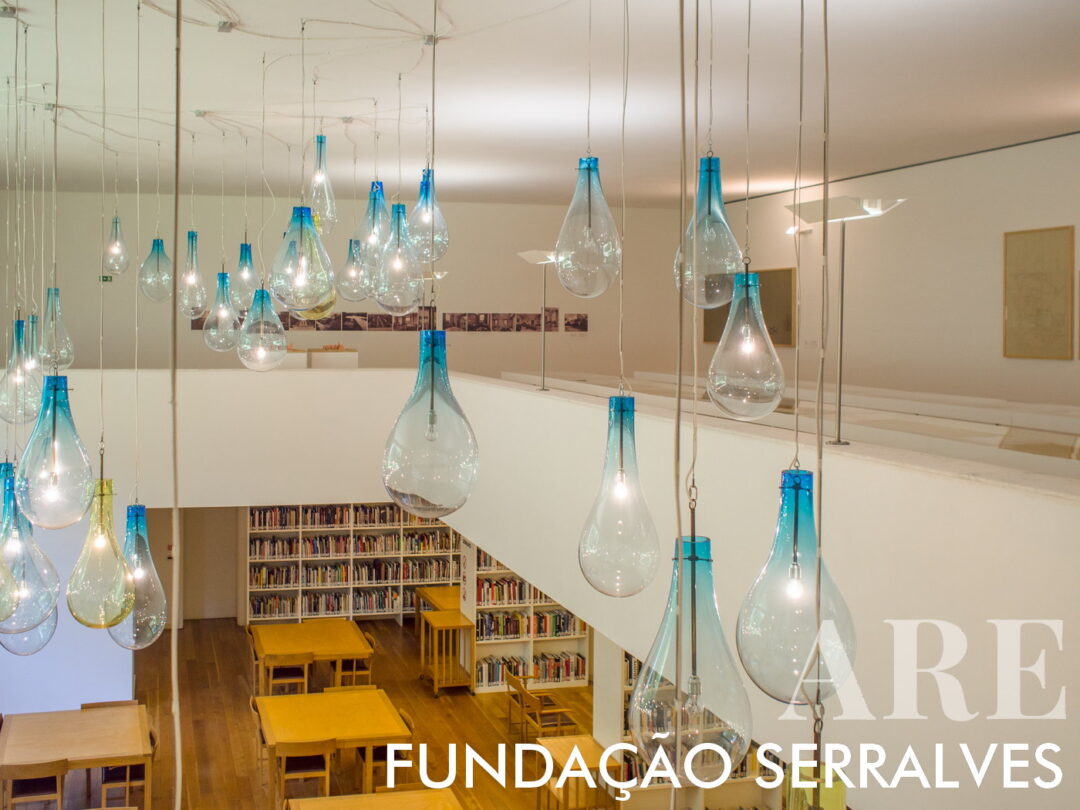
Serralves Library, with reading space with natural light and views of the garden
- Serralves Library;
- Casa do Cinema.
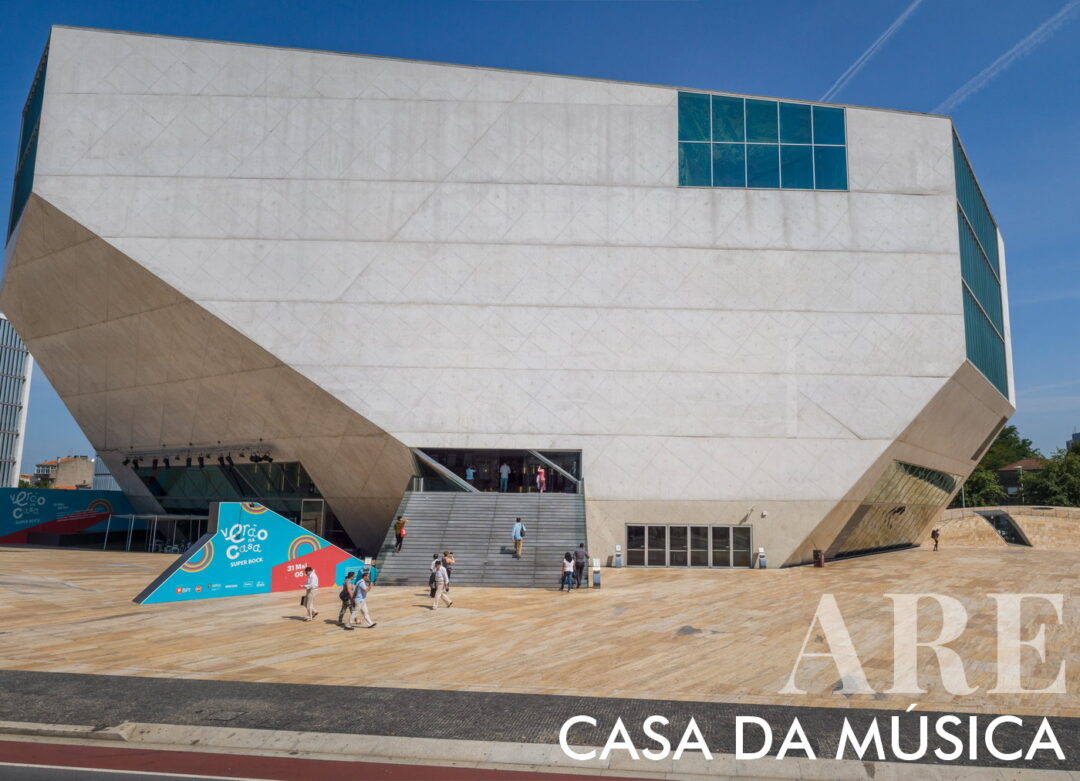
Casa da Música is the main concert hall in Porto, located in a modern architecture building on Avenida da Boavista.
Casa da Música: Casa da Música is the main concert hall in Porto, located on Avenida da Boavista, created after the nomination of the city of Porto and Amsterdam as European Capitals of Culture. The Casa da Música building was designed by the Dutch architect Rem Koolhaas, it was built in reinforced concrete with walls of 40 cm and inclined at 48 degrees in some points of the structure. The construction was divided into 85 consecutive phases due to the construction complexity. The highlights of Casa da Música are:
the Sala Suggia, the ex libris of Casa da Música, is the Grand Auditorium and was thus designated to honor the cellist of Italian origin Suggia;
the Room 2, the second auditorium of Casa da Música with a capacity of 300 seats and 650 seats;
the Cibermúsica, the space where the Educational Service of Casa da Música is located;
the VIP Room, considered the visiting room of Casa da Música, stands out due to: the tile panels representing Portuguese and Dutch potters, painters and potters between the 16th and 18th centuries; the view over the city of Porto; and the Casa da Música restaurant, where we can enjoy a meal with live music.
Fort of São João Baptista da Foz: Fort of São João Batista da Foz is a defensive structure, located in Foz do Rio Douro. The first construction was a church built in 1527 at the request of Dom Miguel da Silva (1480-1556), Bishop of Viseu and Ambassador of Dom Manuel I to Pope Leo X (1475-1521) and with a project by the Italian Francesco of Cremona. The fortress began to be built in 1570 with the demolition of the majority of the church, leaving only the chancel that was used as a fortress chapel. The fortress had several construction phases, namely:
- Project by Simão de Ruão in 1570;
- Guerra da Restauração (1640-1668) with the participation of the Chief Engineer of the Kingdom Charles Lassart. In 1655 it was considered the second most important fortress in Portugal, after the São Julião Fortress;
- Reinaldo Oudinot project opened in 1798.
Fort of São Francisco Xavier: The Fort of São Francisco Xavier is a military structure, located at Praça João Gonçalves Zarco, the fortress started to be built in 1561 with a project by Lassart. The points of interest are: the entrance portal with the royal shield, with access to the main square; the Casa do Governador, built with a project by Carvalhais Negreiros; and the Museum of the Command Association.
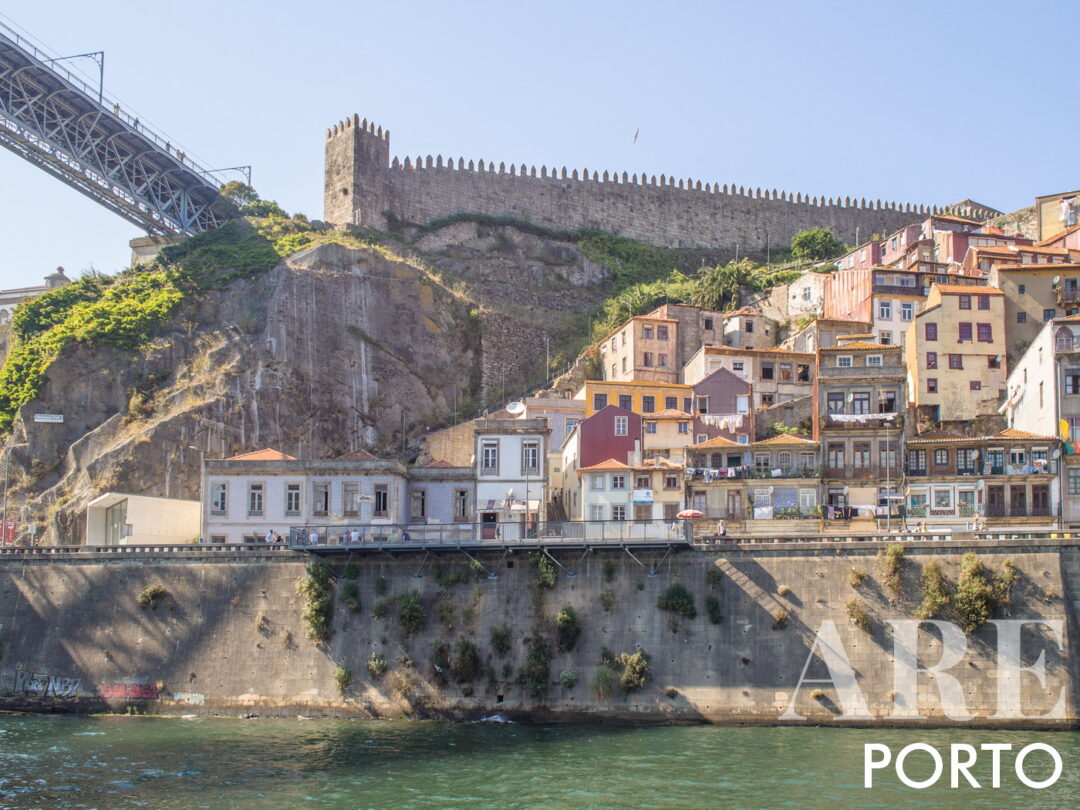
Guindais Funicular with the Fernandina da Sé Wall and the Dom Luís I Bridge
Funicular dos Guindais: The Funicular dos Guindais is an elevator connecting the Ribeira area to Batalha, located at Rua da Ribeira Negra. The funicular runs along a 281 meter course on the Guindais escarpment, between Ribeira and the Fernandina Wall. The funicular was inaugurated in 1891 and restored in 2004 with a project by Raoul Mesnier de Ponsard, author of other elevators built in the country, namely the Elevador do Bom Jesus de Braga, the Funicular da Nazaré, the Elevador de Santa Justa and Elevador da Bica in Lisbon. The points of interest of the Guindais Funicular are: the view over the Ribeira area, the Dom Luís I Bridge and the Caves Vinicolas de Gaia; and the proximity of Ribeira, Muralha Fernandina and Ponte Dom Luís I.
Romantic Museum: The Romantic Museum is where King Carlos Alberto of Sardinia lived, located at Rua de Entre-Quintas. The museum is housed in Quinta da Macieirinha or Sacramento, an 18th century building built on a property that integrates the Gardens of the Crystal Palace and Gardens of the Casa Taft. The museum was renovated during 2017 and re-opened in 2018 with a project by architect Camilo Rebelo and set designer Tito Celestino. The main highlights of the Romantic Museum are: 18th and 19th century clothing; and the gardens.
Interactive Museum and Theme Park World of Discoveries: is an interactive museum space and theme park located at Rua de Miragaia where we can get to know the History of Portuguese Discoveries interactively. The museum was opened in 2014 with the following thematic areas:
- On Board;
- Attempts and Inventions;
- Worlds of the World;
- Deck of the Ship;
- Naval Shipyard;
- Departure from Porto;
- Lisbon;
- North Africa;
- Conquest of Ceuta;
- Dark Sea;
- Cabo das Tormentas;
- Black Africa;
- Tropical florests;
- India;
- Timor and China;
- Macau;
- Japan;
- Brazil;
- Known World Maps;
- Travel from Pêro da Covilhã.
Ferreira Borges Market: the Ferreira Borges Market is a cultural site and the headquarters of Hard Club, located at Rua da Bolsa. The market was opened in 1888 to replace the Mercado da Ribeira and was thus designated to honor Ferreira Borges, the founder of the Porto Commercial Association and great promoter of the Palácio da Bolsa. The market is one of the hallmarks of Porto, it was designed by João Carlos Macedo who chose to create a platform to level the land, used wrought iron and glass throughout the building. The Ferreira Borges Market has performed various functions throughout history, namely fruit and vegetable market, military barracks or community kitchen for the city’s poorest population. The main points of interest are: a restaurant and concert halls; the structure of the building in wrought iron and glass; and the proximity of the Palácio da Bolsa, the São Francisco Church, Rua das Flores and Ribeira.
Parque da Cidade: Parque da Cidade is the largest urban park in Portugal, located on the Interior da Circunvalação road, the park was opened in 1991 with a project by Sidónio Pardal in a place with approximately 83 hectares, which offers routes of ten kilometers in length. The attractions of Parque da Cidade are: the holding of a Biological Market on Saturdays; Bird watching; the Water Pavilion; the Sea Life Center; the Queimódromo; o Sand volleyball court; the shared Bike Path; and the Environmental Education Center.
Medieval Tower: the Medieval Tower is the location of the Porto Tourism Office, located on the Calçada Dom Pedro Pitões. The Medieval Tower-House was discovered during the excavations carried out during the 1940s at Terreiro da Sé and which completely changed the urban environment of this square. As a result of the works carried out, the Casa-Torre and the Pelourinho were rebuilt, located in the middle of Monte da Ventosa, between the Porto Cathedral and the Episcopal Palace. The current Casa-Torre was rebuilt with a project by Rogério de Azevedo.
Casa da Câmara: Casa da Câmara is a tower that reproduces the old medieval headquarters of the Porto City Council, located in Terreiro da Sé. Casa da Câmara or Casa dos 24 was rebuilt in 2002 with a project of Fernando Távora. Casa dos 24 was so named because it included representations of the main 24 offices in the city of Porto. The Casa dos 24 functioned in this tower next to the medieval city wall between 1450 and 1800, however it was totally destroyed in 1875 in a fire that broke out in the premises. The Porto City Hall subsequently operated in the Paço Episcopal until the inauguration of the Paços do Concelho on Avenida dos Aliados.
Feitoria Inglesa: Feitoria Inglesa is the headquarters of the British Association of Porto, located at Rua da Cordoaria Velha de Lordelo. Feitoria Inglesa was built between 1785 and 1790 with a project by John Whitehead, English Consul in Porto. Feitoria Inglesa is one of the symbols of the English presence in the city and currently has 12 members and 7 Associated Houses, it aims to promote Port Wine, especially Vintage Port, and Wednesday lunches continue to be known among the Port Wine entrepreneurs. The main highlights are from Feitoria Inglesa are: the main facade with seven arches; the library; the main staircase; the Ballroom; and the kitchen.
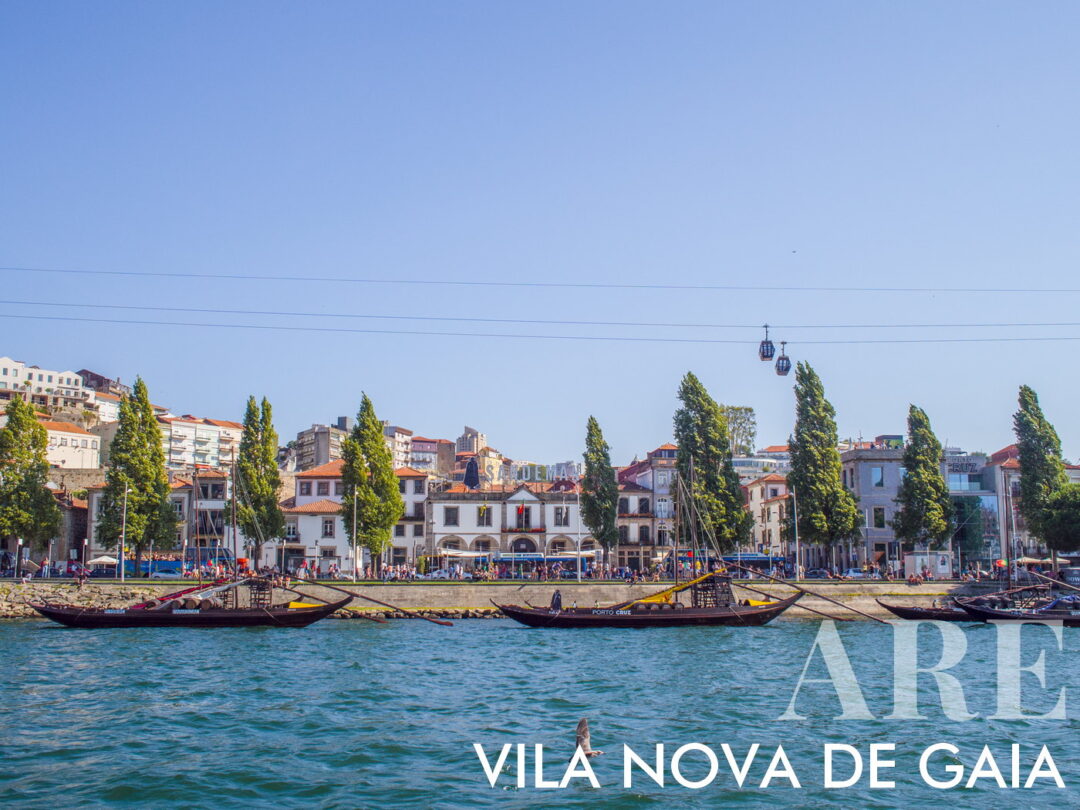
Vila Nova de Gaia, with the cellars on the coast of the Douro River, the cable car and the Rabelo boats, the typical Portuguese vessel on the Douro River that traditionally transported the Port Douro kites from Alto Douro. Currently, tourist companies are available for tourist trips with city visitors
Teleférico de Gaia: Teleférico de Gaia is a cable car from where we can observe the Douro River, Vila Nova de Gaia and the city of Porto, located in Calçada da Serra. The cable car was opened in 2011 and covers a distance of 600 meters, with a maximum of 63 meters in height, with a connection between the Dom Luís Bridge and the Caves of Gaia. The main points of interest are from this cable car: the view of the city of Porto, Caves de Gaia and Nossa Senhora do Pilar; and the viewpoint of Nossa Senhora do Pilar.
Palácio de Cristal: The Palácio de Cristal was opened at Rua de Dom Manuel II in 1865 to host the International Exhibition of Porto, which was attended by over 4300 exhibitors from 25 countries, it is a building in the city of Porto where since then there have been countless cultural and musical activities. The Crystal Palace was inspired by London’s Crystal Palace and started to be used as the exhibition site, namely the Louças das Caldas Exhibition in 1901, the Automobile Exhibition in 1926, the 1930 Industrial Exhibition or the Porto Colonial Exhibition in 1934 The palace was destroyed in 1952 to build the current Sports Pavilion with the aim of hosting the World Roller Hockey Championship, in which Portugal was the winner. The pavilion had several names, namely Palácio de Cristal, Pavilhão dos Desportos and Super Bock Arena: Pavilhão Rosa Mota. The Crystal Palace’s points of interest are the Almeida Garrett Municipal Library; the Acoustic Shell; the Alberto da Sardinia Chapel; the Environmental Education Center; the Children’s Park; and the Gardens, with Avenida das Tílias and Plátanos; the woods; and the Emil David Garden.
Palácio da Batalha: the Palácio da Batalha is currently the site of the NH Collection Porto Batalha hotel, located at Praça da Batalha. The palace was built in the 18th century to be the residence of José Anastácio Guedes da Silva Fonseca, the owner of Quinta da Aveleda known for the production of green wine. The palace has performed several functions throughout history, namely private residence, hospital during the Siege of Porto, Post Office, Telegraph and Hotel.
Palácio do Freixo: Palácio do Freixo is a hotel belonging to the Pestana Hotels group, located on Estrada Nacional 108 in front of the Douro River. The Pestana Palácio do Freixo – Pousada & National Monument – was built by Dom Jerónimo de Távora and Noronha for a private residence. It was changed over time from the initial Baroque style project by Nicolau Nasoni, with the restoration in 2000 and 2003 with a project by Fernando Távora, known for the renovation of the Soares dos Reis National Museum and for being one of the main professors of Álvaro Siza Vieira, or by David Sinclair between 2007 and 2009. The main highlights are: the Gardens by Nicolau Nasoni built in the 18th century; the Sala dos Espelhos, with emphasis on stucco and frescoes; the Palatium Restaurant, with Porto cuisine and paintings from 1850; and Bar Nasoni, highlighted by the presence of Júlio Resende’s paintings and the windows from which we can observe the Douro River.
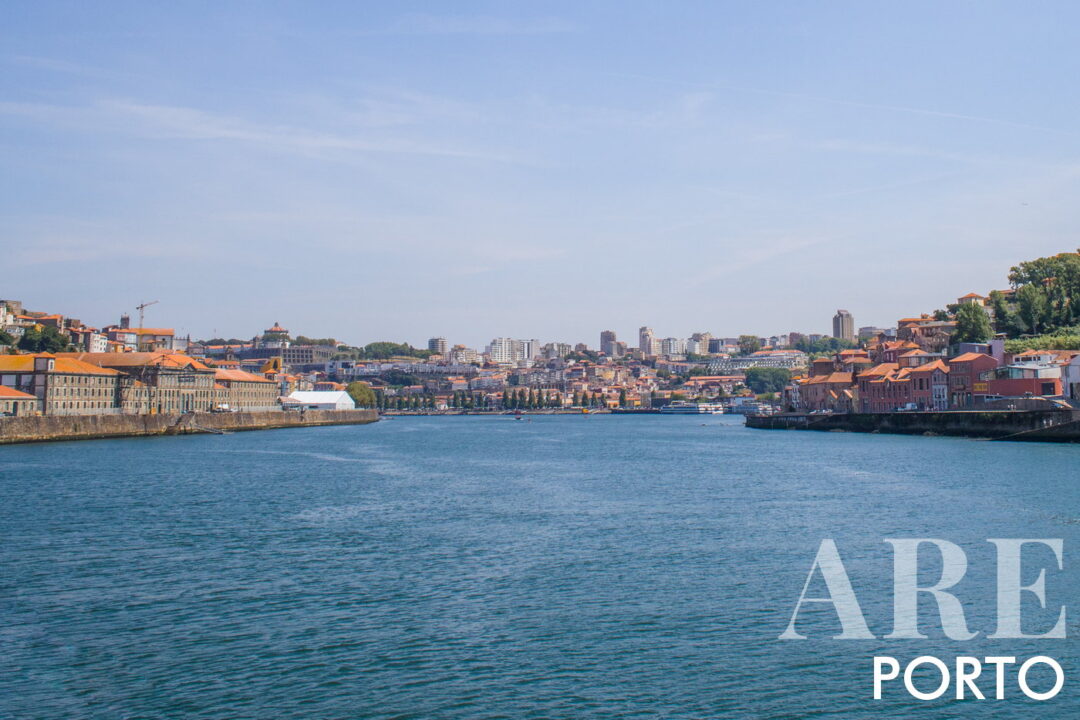
Miragaia neighborhood on the left of the image, with the Alfândega do Porto building on the coast of the avenue. On the right side of the photo, south of the Douro River we can see Vila Nova de Gaia…
Miragaia: Miragaia is a typical Porto neighborhood, located near Foz do Porto, we find the “Tripeiros”, the inhabitants with a typical Porto culture, where we find the typical colorful houses with the wrought iron balconies built at the water level, built throughout history. The neighborhood was outside the medieval walls and this is where the Jews and Armenians lived. This Porto neighborhood is also known for the intensity with which it celebrates São João and for the busy nightlife. The main highlights of Miragaia are: the Palácio das Sereias; the World of Discoveries Interactive Museum and Theme Park; the tram that connects the Palácio da Bolsa and Foz; the Bolsa do Pescado Building, now Hotel Vincci do Porto; the Electric Car Museum; the Marginal with a bike path along the Douro River; Rua Senhora da Boa Morte, where you can see the colorful houses of this neighborhood and enjoy a clear view of the Douro River; the Santa Catarina viewpoint; the Chapel of Santa Catarina; the Garden of Cálem; the Lordelo do Ouro; the Sobreiras Landfill; the Bairro da Cantareira; and the São Miguel-o-Anjo Lighthouse.
The Churches of Porto
Church of Santo António dos Congregados: the Church of Santo António dos Congregados is a 17th century church, located at Praça Almeida Garrett, started as a chapel built as the headquarters of the Confraria de Santo António de Lisboa in Porto. The church was inaugurated in 1703 and used as a military material warehouse and hospital during the Siege of Porto. The main highlights are: the main facade, with tiles by Jorge Colaço and the stained glass windows by Albert Leone, were opened in 1920; and the Main Chapel, rebuilt in the 19th century, with mural paintings by Aécio Lima.
Church of Santa Clara: the Church of Santa Clara is a 15th century female church and convent, located in Largo Primeiro de Dezembro. The Church of Santa Clara is known as the “Church of the Gold” due to the large amount of gilded wood in the interior. The highlights of the Church of Santa Clara are: the Renaissance style portal; and the gilded carving of the interior of the church considered an ex libris of the 18th century Porto School of Engravers.
Nossa Senhora da Vitória Monastery and Church: the Nossa Senhora da Vitória Monastery and Church is a religious building from the 16th century, located at Rua de São Bento da Vitória. This church is located in the old Judiaria do Porto, the old neighborhood inhabited by Jews during the Middle Ages, located outside the Cerca Fernandina completed in the 14th century. This area is currently part of the Historic Center of Porto and includes several attractions, including the Church and Torre dos Clérigos, Miradouro de Nossa Senhora da Vitória or Livraria Lello. The Monastery began to be built in 1598 and the church in 1604, having ended in 1690, with an initial project by Diogo Marques Lucas. The building has performed several functions throughout history, namely Hospital Militar during the French Invasions, Military Tribunal and headquarters of the Military Telegraphs until 1874, when it was almost completely destroyed by fire. The building was restored to its current appearance between 1984 and 1990 and from 2001, with the event “Porto European Capital of Culture”, it gained new life with the establishment of the headquarters of the National Theater of São João and through the creation of a Center Documentation dedicated to performing arts students and researchers. The highlights of the Monastery and Church of Nossa Senhora da Vitória are: the Retable of the Main Chapel, considered one of the most important works of the National Baroque or Joanine style. The altarpiece was built between 1716 and 1725 with a project by Gabriel Rodrigues; the altarpieces of the transepts built between 1725 and 1728 by José da Fonseca Lima and José Martins Tinoco; the painting of Nossa Senhora da Vitória by Soares dos Reis; the Alto Choir, with the work in gilt carved by Marceliano de Araújo and Gabriel Rodrigues between 1716 and 1719, in Rococo style that represent the “Passos da Vida de São Bento”; and the Main Cloister built between 1608 and 1728 built with three arches, which is very rare in this type of architecture in Portugal.
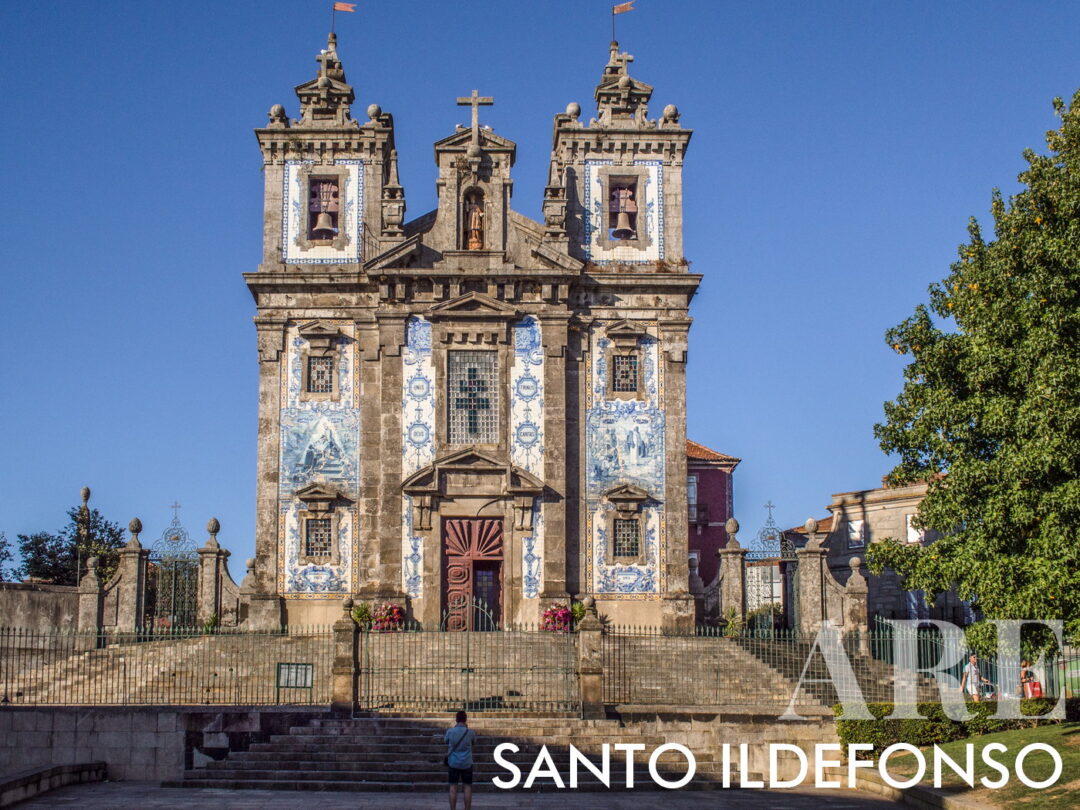
Church of Santo Ildefonso, with a facade with more than 11 thousand tiles representing scenes from the life of Santo Ildefonso and passages from the New Testament, written by Jorge Colaço
Church of Santo Ildefonso: the Church of Santo Ildefonso is an 18th century church, located in Praça da Batalha, started to be built in 1709, was completed in 1739 in the Baroque style and was dedicated to Santo Ildefonso (606 -667), Bishop of Toledo. The highlights of the Church of Santo Ildefonso are: the main facade with more than 11 thousand tiles representing scenes from the life of Santo Ildefonso and passages from the New Testament by Jorge Colaço; the statues representing São Francisco Xavier, Nossa Senhora da Boa Morte, Nossa Senhora de Fátima, Nossa Senhora da Conceição and Santo António; the screens representing “Santo Sacríficio” and “Triunfo Eucarístico” by Domingos Teixeira Barreto; the Alto Choir with emphasis on the pipe organ by Manuel de Sá Couto opened in 1811; the Museu de Arte Sacra, with various pieces of a religious character, namely the silver liturgical implements, the objects in gilded wood and the Books of Hours.
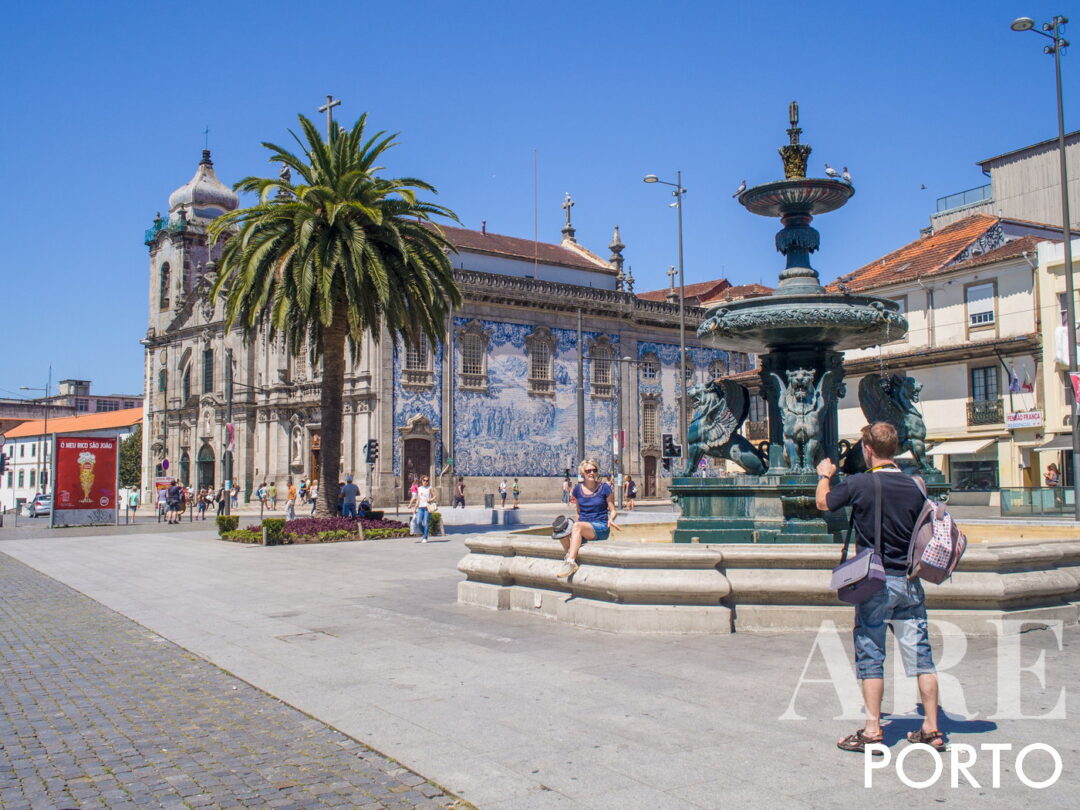
Gomes Teixeira Square, with the source of the Lions and the Igreja do Carmo, the Igreja dos Carmelitas Descalços and the Casa Escondida, considered the narrowest house in the city of Porto
Igreja do Carmo: Igreja do Carmo is an 18th century church and Headquarters of the National Republican Guard in the city of Porto, located at Rua do Carmo. The Carmo Church, officially designated as Church of the Venerable Third Order of Nossa Senhora do Carmo, began to be built in 1756 in Baroque and Rococo style and was completed in 1680 with an initial project by José de Figueiredo Seixas, born in Viseu and a student of Nicolau Nasoni. The Carmo Church was built to be the headquarters of the Third Order of Carmo in Porto, and opened in 1736 with only twelve members. The Order of Carmo was already established in Portugal, namely in Lisbon, Setúbal, Faro and Viseu. The Orders can be divided into three categories: the First Order: it is the order for men (friars and monks); the Second Order: it is the order dedicated to women (nuns and nuns); and the Third Order: it is an order dedicated to lay people, people who do not want to abandon their daily lives, but who identify with a certain religious order. The Third Orders appeared in 1212 when St. Francis began to integrate people who did not want the rigidity of monastic life, but at the same time intended to evolve spiritually. After this first situation, this example was followed by the Dominicans in 1406, Augustines in 1409 and Carmelites in the year 1452.
The main points of interest are:
- Main façade, with the central niche glazed with the image of Santa Ana, the patron saint of the Church; the Order’s coat of arms on the eardrum; the Sculptures of the Four Evangelists, Mateus, Marcos Lucas and João .. The statues were inaugurated in 1765 and are at the top of the Church; the Niches with images of the Prophets Elijah and Elisha carved in Italy, located on each side of the main entrance to the church; the Varandim by Nicolau Nasoni;
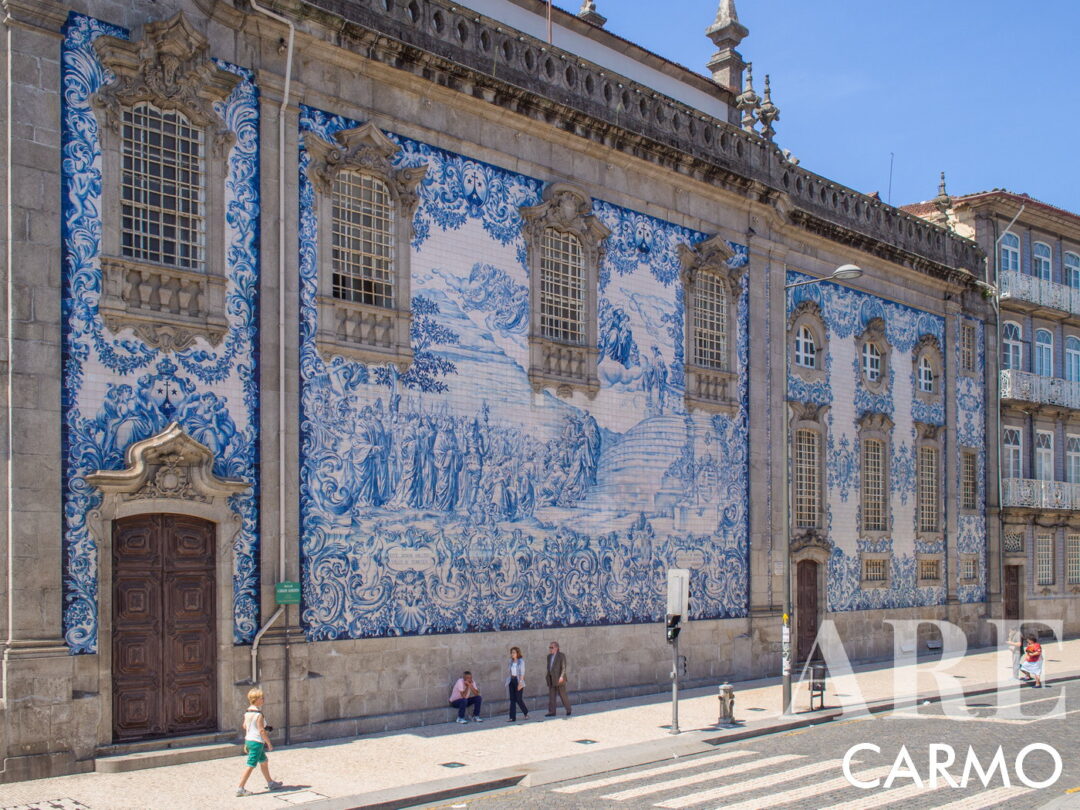
Side facade of the Carmo Church in Porto, with themes from episodes of Catholicism depicted in tile painting
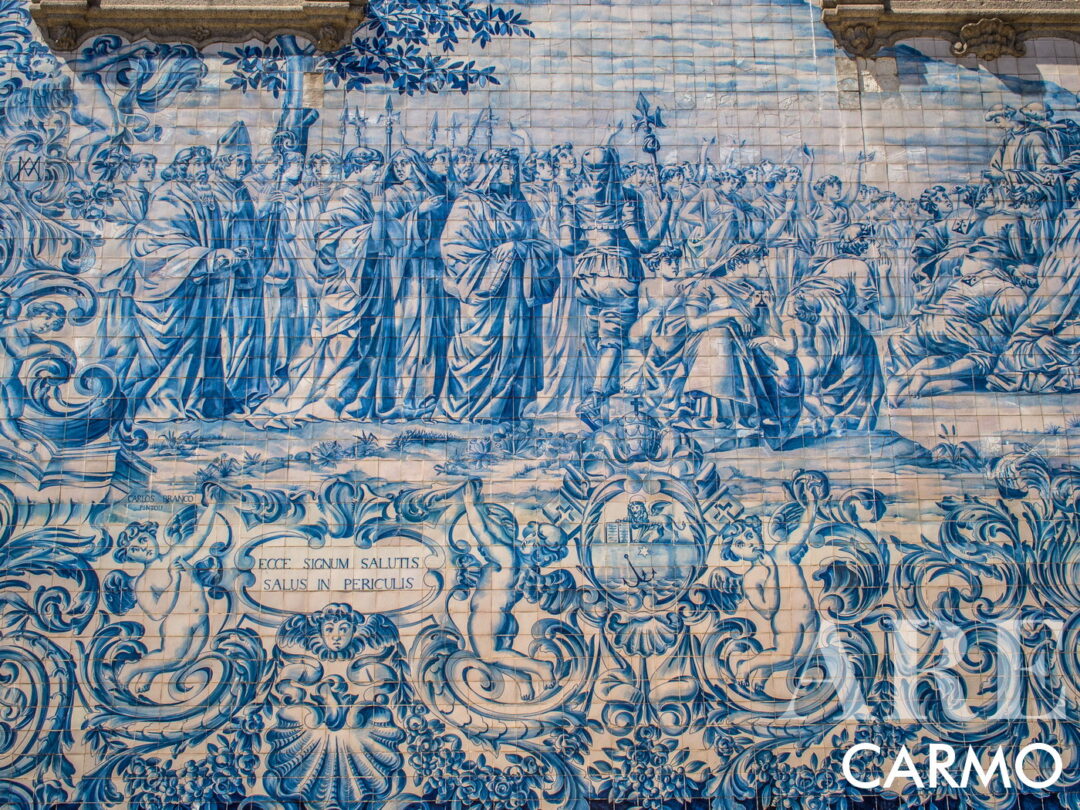
Tile panel of the Carmo church with scenes depicting the foundation of the Carmelite Order and Mount Carmel.
- Lateral façade with a panel of white and blue tiles, placed on the façade between 1907 and 1912 by Silvestre Silvestri, an Italian professor at Escola Industrial Infante Dom Henrique, and executed by Carlos Branco. The panels featured several episodes of Catholicism, namely, the Apparition of the Virgin to São Simão Stock, an English Carmelite friar who lived in the 13th century; the imposition of the scapular, a piece of cloth placed over the shoulders of Christ, on Mount Carmel; the shields of two Popes; and the Shields of the Bishop of Porto Dom António Barroso.
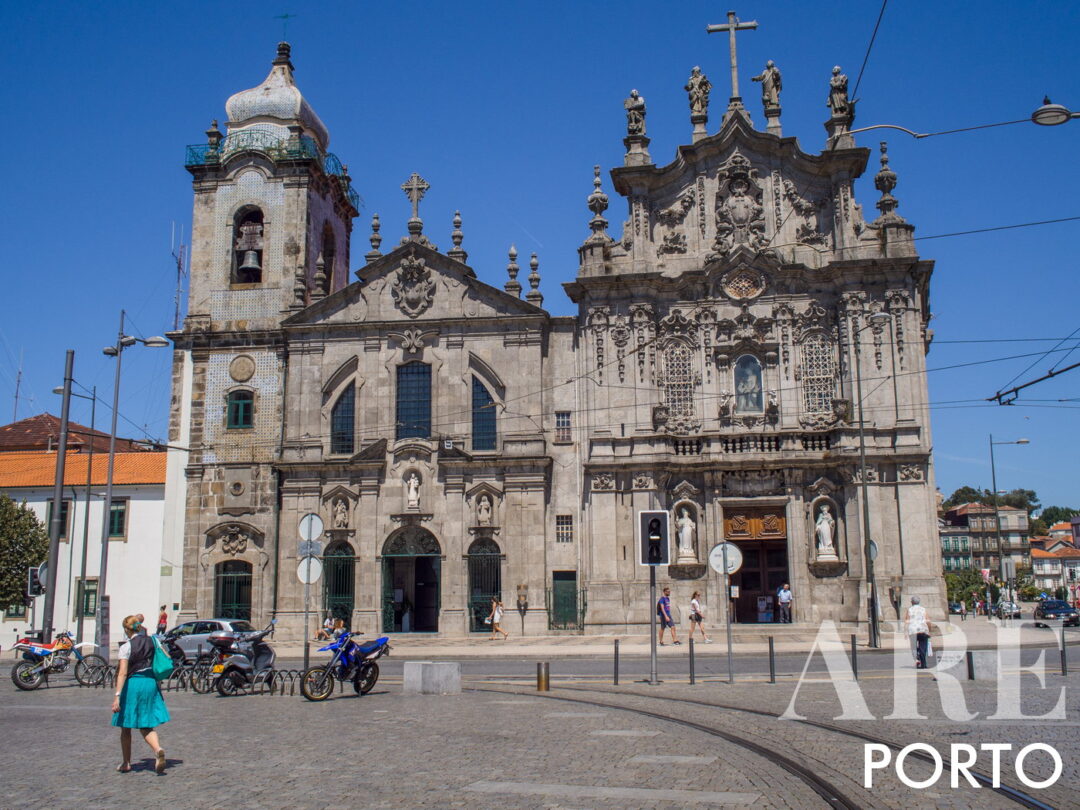
Igreja do Carmo on the right, the church of the bare Carmelites on the left and Casa Escondida, considered the narrowest house in Porto, located between the two churches, we can identify it by the entrance door and the green railing, and the two windows on the facade
- Casa Escondida: considered the narrowest house in the city of Porto, it is found in the middle of the two churches: the Igreja do Carmo and Igreja das Carmelitas. The house was built in 1756 and was frequented by doctors, chaplains, monks or restoration artists. The house has three floors, each with a division, namely bedroom, living room and kitchen. The main highlights of Casa Escondida do Porto are: the Room, with a small space where dispatches were made by the Sacristan of Porto and chaplains; and the Living Room, used as a place for secret meetings during important periods in the History of Portugal, namely during the French Invasions of 1809, during the Siege of Porto in 1832-33, and after the implantation of the Republic in 1910;
- Side chapels: are the six chapels that represent the Steps of the Passion of Christ. The chapels were opened in 1771: Jesus no Horto; Jesus Attached to the Column; The Arrested Lord; Lord of the Steps; “Ecce Homo”; Jesus Crowned with Thorns;
- Capela-Mor: the Capela-Mor was inaugurated in 1773 with a project by Francisco Pereira Campanhã where we can observe: the Image of the Crucified Lord; the Image of Santa Ana; the Image of Nossa Senhora do Carmo; the Ceiling with a painting representing the Resurrection of Christ; the Catacombs, built in 1845 with an available space for 140 tombs. The catacombs were used until 1869, when the Order of Carmo bought a fraction of the Agramonte Cemetery and became the largest private cemetery in the city of Porto with approximately two thousand graves. The catacombs were turned into vaults after the tombs were transferred to the Agramonte Cemetery.
Igreja dos Carmelitas: Igreja das Carmelitas is a 17th century church, located in Rua do Carmo, built between 1619 and 1680 in Baroque style, belonged to the Convento dos Carmelitas Descalços. The Order of the Discalced Carmelites is part of the Order of Carmel, was created in 1593 by Santa Teresa de Ávila and São João da Cruz. The church has the following highlights: Main façade with images of São José, Santa Teresa of Nossa Senhora do Carmo; the Main Chapel with the gilded altarpiece by Joaquim Teixeira de Guimarães and executed by José Teixeira Guimarães; the Chapel dedicated to Nossa Senhora do Carmo, inaugurated in 1639 with a project by Jerónimo da Mota Teixeira; the Chapel dedicated to Nossa Senhora das Dores from 1637 executed and planned by Manuel Tavares; and the 18th century pipe organ.
Museum and Church of Misericórdia do Porto: the Museum and Church of Misericórdia do Porto is a space where the History of the Santa Casa da Misericórdia do Porto is disseminated, located on Rua das Flores. This place tells the story of the Santa Casa in the city of Porto between the 16th century and 2013, having been built on an iconic street in the city, originally called Santa Catarina das Flores street, built in the 16th century by King Dom Manuel with the goal to establish the connection between the Female Monastery of São Bento de Ave Maria and the Male Convent of São Domingos. The Santa Casa da Misericórdia was created by Queen Dona Leonor, widow of Dom João II, in 1498 with the designation of Confraria de Nossa Senhora da Misericórdiia in Lisbon. Misericórdia was inaugurated in Porto the following year with the aim of providing aid to the poorest in society due to the black plague, hunger and war that existed throughout Europe. The Museum and Church of Misericórdia do Porto is known for its 14 Works, namely:
- Body Works: Feed those who are hungry; Give water to those who are thirsty; Dress the nudes; Give pilgrims lodging; Assist the sick; Visiting prisoners; Bury the dead;
- Spiritual Works: Give good advice; Teach the ignorant; Correct those who make mistakes; Forgive injuries; To suffer with patience the weaknesses of our neighbor; Pray to God for the living and dead;
The points of interest of the Museum and Church of Misericórdia do Porto are: the Church of Misericórdia, inaugurated in 1550 and blessed by the Bishop of Porto Dom Rodrigo Pinheiro in 1559. The church was rebuilt in the 18th century with a project by by Nicolau Nasoni and presents the following points of interest: the Paintings by Diogo Teixeira and executed in 1591 and 1592 to represent “A Anunciação”, “A Visitação” and “A Adração dos Pastores”; the Misericórdia do Porto, “History and Action”: here we highlight the history of several figures linked to the Santa Casa da Misericórdia do Porto, namely: Dom Francisco de Noronha e Menezes; José Rodrigues d’Araújo Porto; Dom Lopo de Almeida; António Monteiro dos Santos; Manuel José Pereira de Lima; José António dos Santos; Manuel António Monteiro dos Santos;
“Painting and Sculpture”, with emphasis on: Sagrada Família; Our Lady of Mercy; Adoration of the Magi; and Holy Thursday Urn;
“Ourivesaria e Paramentaria”, with emphasis on: Cristo Morto; and Reliquary Head of São João Batista;
Church of São Martinho da Cedofeita: the Church of Cedofeita is considered the oldest church in the city of Porto, located in Largo do Priorado. The first church was built approximately 1500 years ago during the Sueva occupation and there are two legends that explain the construction, namely:
- Promise that King Suevo Teodomiro made to São Martinho due to the cure of his son’s illness;
- The church was built in record time, becoming popularly known as “Cito Facta”, which means “Feito Credo”. This expression gave rise to the word Cedofeita;
The Church of São Martinho da Cedofeita was remodeled throughout history, namely in 1923, with several points of interest: the 9th century Portal; the tympanum of the North portal; the Inscription on a tombstone; and the 11th century chancel.
São Lourenço Church and College: the São Lourenço Church is a 16th century church, located in Largo do Colégio, built in several phases: between 1577 and 1622; and the main façade between 1690 and 1709 in the Mannerist and Baroque-Jesuit style with an initial project by Afonso Álvares. The church is known by the people of Porto as “Igreja dos Grilos” due to the presence of the Barefoot Friars of Santo Agostinho, who had come from Spain to Lisbon, where they settled in Sítio do Grilo and started to be designated by the people as “friars-grilos” . in association with the Convento dos Grilos in Lisbon. The church was administered by several institutions, namely:
- Jesuits: from 1577 until the expulsion decreed by the Marquis of Pombal in 1759;
- University of Coimbra: between 1759 and 1780;
- Barefoot Friars of Saint Augustine between 1780 and 1832;
- Occupation of the building during the Siege of Porto (1832-33) by the Academic Battalion, supporter of Dom Pedro;
- Major Seminary of Nossa Senhora da Conceição: role that it has performed since 1834;
The main points of interest are:
- the São Lourenço Church, with the connecting bridge between the two bell towers that allows you to observe the city of Porto and Vila Nova de Gaia; the two bell towers, the Capela-Mor, with a neoclassical altarpiece with a painting representing “Jesus Christ Igniting the Heart of Saint Augustine” by João Batista Ribeiro; the sepulchral Ark of Frei Luís Álvares de Távora, one of the biggest financiers of the construction of the church; the image of the deacon São Lourenço, patron saint of the church; Saint Helena, mother of Saint Augustine; the image of Saint Augustine; the image of Santo Inácio de Loyola, founder of the Companhia de Jesus; the chapel of Nossa Senhora da Purificação, with the altarpiece built between 1729 and 1733 by the carvers Francisco Pereira de Castro and António Pereira and the gilder Pedro da Silva Lisboa; the Altar of the Heart of Jesus with a panel by Marques de Oliveira in 1882; the Reliquary Altar, built in Baroque style with 14 shrines-reliquaries of several saints, namely one of the Eleven Thousand Virgins, Santa Úrsula, Santa Luzia, São Sisto Papa e Mártir; the Choir Alto, with an Iberian organ from the 17th century;
- Museum of Sacred Art and Archeology, created by the Auxiliary Bishop of Porto Dom Domingos Pinho de Brandão (1972-1988) in the late 1950s and stands out for the Room dedicated to Archeology with pieces from everyday life from the Iron Age to the 1st century AD; the reproduction of a Roman house with the existence of an “impluvium”, that is, a lake that was common in the courtyard of Roman residences and that served as a water reservoir; the Corridor of Confessions, with sacred art that includes the Old Testament and the lives of the saints; the Irene Vilar Room, dedicated to this sculptor, with Bust of São Nuno de Santa Maria, the private numismatic collection by Irene Vilar. The Corridor of Confessions, also known as Corredor das Lousas, with a collection of sacred art, organized from the Old Testament to the life of the Saints; the Dom Domingos Pinho de Brandão Room (1920-1988), dedicated to the life and work of the founder of the museum with emphasis on four paintings from the late 16th and early 17th centuries that were part of the private collection of Dom Domingos Brandão; documentation and photographs related to the foundation of the museum; and the books written by Dom Domingos Pinho Brandão dedicated to Epigraphy and gilt.
Parish Church of Nosso Senhor do Bonfim: the Church of Bonfim is a 19th century church, located on Monte do Bonfim street, it was built between 1874 and 1894 with a project by José Luís Nogueira Júnior and António Sardine in neoclassical style. The church is part of the parish of Bonfim, known essentially for two particularities: it was the industrial hub of Porto between the 19th century and the first half of the 20th century; and the industrial population lived on the “islands”.
The Parish Church of Nosso Senhor do Bonfim is dedicated to Santa Clara, Senhor do Bonfim and Boa Morte, with points of interest: Main façade with high relief representing the ram, symbol of the innocence of Jesus Christ; the image to represent the Faith; and the two 42-meter high bell towers. And the Main Chapel, built in a neoclassical style with emphasis on the painting to represent “O Calvário de Cristo” by Júlio Costa.
Church of the Holy Trinity: the Church of the Holy Trinity is a 19th century church, also one of the largest churches in the city of Porto, located at Rua da Trindade, it was built in Neoclassical and Baroque style with a project by the author Carlos Amarante (1748-1815), responsible for several works in the country, namely the Templo das Taipas, the well-known and now extinct Ponte das Barcas in Porto, the Rectory building of the University of Porto, the Brejoeira Palace in Monção, the reconstruction of the Fortress of Valença or the Church of Bom Jesus de Braga. The Third Order of the Most Holy Trinity was created in 1755 by Bull of Pope Benedict XIV and was responsible for the administration of several religious buildings in Porto until the construction of the Church of Trindade, namely Chapel of Senhora da Batalha and Church of Senhor do Calvário. This temple stands out from other Porto churches due to the quality of the work in gilded wood, the perfection of the marble and the grandiosity of the building. The main attractions of the Church of the Holy Trinity are: the main façade with the mechanical clock in the center of the façade, between the two bell towers; the images representing São João da Malha and São Félix de Valois, the founders of the Order of the Holy Trinity. The Main Chapel, designed by Marques da Silva with emphasis on the gilded altarpiece representing the Holy Trinity; the canvas representing “O Baptism of Christ” by José de Brito. In the lateral altarpieces: the Sacred Heart of.Maria; Our Lady of Sorrows; Santa Teresinha; the São José; the Sacred Heart of Jesus. and the Tomb of Carlos Amarante.
São Nicolau Parish Church: the São Nicolau Parish Church is an 18th century church, located on Rua do Infante Dom Henrique. The first version of the church was built in 1671 and the current version was rebuilt between 1758 and 1762 after a serious fire. Saint Nicholas (270-342) lived during the height of persecution of Christians in the Roman Empire, however he managed to be elected Bishop of Mira, in Turkey. He was one of the main figures in the Council of Trent (1545-1563). Saint Nicholas is patron saint of Russia, Greece and Norway, Patron of night watchmen in Armenia and children in Bari. The Saint is always represented in the statues and paintings with three children coming out of a salt flute and with a bag of coins, with two legends associated with these symbols:
- Three children are said to have been murdered by a butcher, who salted them on a salt silo in Miral. After a few years, St. Nicholas visited the butcher and discovered the children who were still salty and, according to the legend, resurrected them;
- In Mira there was a widower who had three daughters who were close to getting married. The man had no money for the dowry and so he decided that the only way to get the money would be prostitution. São Nicolau knew what was going on and to prevent this from happening, he decided to go up to the roof of the house where they lived and placed three bags of silver coins in the chimney, which fall in the socks, which were drying by the fireplace.
The Parish Church of São Nicolau was rebuilt in Baroque and Rococo style in a project by Frei Manuel de Jesus Maria, with emphasis on: the main façade with tiles from the second half of the 19th century; the image of São Nicolau in a glass niche above the entrance portal; the Main Chapel built in Rococo style with a gilded altarpiece by Frei Manuel Jesus Monteiro; painting representing the “Adoration of the Blessed Sacrament” by João Gama Stroberle; and image of Saint Nicholas. In the Sacristy with the jewelery pieces by Domingos Sousa Coelho. The Altar of Nossa Senhora da Conceição; and the Altar of Santo Elói with the image of Santo Elói (588-660) from the Confraria dos Ourives. Santo Elói (588-660) was born on December 1 and played several roles throughout his life, namely Goldsmith Official of Kings Clotário II (584-629) and Dagoberto I (606-639), Bishop of Noyon and Tournai and executed several works as goldsmiths, namely reliquaries for Saint Germain de Paris or Saint Martin. Santo Elói is the patron saint of goldsmiths and is always represented with the goldsmiths hammer. The statue is located here in São Nicolau Parish Church because it was the meeting point of the Confraria dos Ourives.
Church of São Pedro de Miragaia: the Church of São Pedro de Miragaia is an 18th century church, located in Largo de São Pedro de Miragaia, it was rebuilt from 1740 due to the growth of the Miragaia neighborhood. Miragaia started out as a fishing neighborhood built outside the walls of the city of Porto, with a large population growth from the 18th century. This neighborhood is known for the houses decorated with tiles and balconies built with wrought iron and the regular occurrence of flooding in the Douro River due to the construction of houses on the same level as the river.
The Church of São Pedro de Miragaia stands out for its main façade with tiles from the 19th century; the chancel opened in 1724 with a project by António Gomes and Caetano da Silva Pinto. The gilding of the chapel was completed in 1730 by Francisco Barbosa Monteiro; the Chapel of the Holy Spirit where we can see a triptych by the Flemish painter Berend Van Orley (1492-1542) representing “The Triptych of the Holy Spirit” or “Triptych of Pentecost” “Pentecost”, “Saint John the Baptist and the donor” and “São Paulo”.
Church of São José das Taipas: the Church of São José das Taipas is where the oldest nativity scene in the city of Porto is located, located in Campo Mártires da Pátria. The church, administered by the Brotherhood of Souls of São José das Taipas created in 1780, was built between 1795 and 1878 in a neoclassical style with a project by Carlos Cruz Amarante. The construction site was designated as “Taipas” because this is the space where the corpses of people who contracted the black plague in the 16th century were buried, and who were trapped so as not to spread the disease to the rest of the population. The church is currently the starting point for an annual procession that honors the lives lost during the Ponte das Barcas Disaster: this procession ends in the bas-relief “Alminhas da Ponte” by Teixeira Lopes. The main points of interest of the Church of São José das Taipas are: the painting with representation of the “Disaster of the Ponte das Barcas”, a tragic event happened during the Second French Invasion on the 29th of March 1809. This bridge was built on top from ferries and made the connection between Porto and Vila Nova de Gaia and slaughtered due to the panic of people fleeing French troops; the reliquary of Santa Clara (1843-1899), founder of the Congregation of Franciscan Sisters Hospitallers of the Immaculate Conception, beatified in 2011; the reliquary of the Little Shepherds of Fátima, Francisco and Jacinta; the painting of the German school representing Our Lady of Divine Providence; the Crypt; the church tower, from where we can observe the city of Porto; and the Museological Nucleus of the Brotherhood of Souls of São José das Taipas, with emphasis on the 18th century nativity scene, by Machado de Castro, is considered the oldest nativity scene in the city of Porto.
Chapel of the Divine Heart of Jesus: The Chapel of the Divine Heart of Jesus is a religious building from the 19th century, located at Rua do Almada, close to Praça da República. The chapel is known as “Capela dos Pestanas”, it was built in Neo Gothic style between 1878 and 1890, commissioned by José Joaquim Pestana. The Chapel of Pestanas was inspired by the Chapel of Saint Chapelle in Paris with the following highlights: the main facade with and the stained glass windows of the Chapel designed in Belgium.
The beaches of Porto
Praia de Gondarém: Praia do Gondarém is a beach approximately 115 meters long, located on Avenida do Brasil. The name Gondarém means “rest in battle” and was the military’s resting place. The beach, also known as Praia da Conceição, has several highlights, namely: Blue Flag Award and Golden Beach; it is a beach frequented by children; sought for the practice of sport fishing; there are Bars and restaurants nearby;
Praia dos Ingleses: Praia dos Ingleses is a beach approximately 86 meters long, located at Rua Coronel Raúl Peres. Praia dos Ingleses has the following points of interest: rocks over 570 million years old; belongs to Praia da Foz;
Homem do Leme Beach: Homem do Leme Beach is a beach approximately 374 meters long, it was the first beach in Porto to receive the Blue Flag, located on Avenida de Montevideu. The beach is named for two main reasons: to honor the fishermen; presence of the statue “O Homem do Leme” by Américo Gomes and inaugurated in 1934;
The beach has the following attractions: Blue Flag award, Golden beach and Beach Accessible to all; Viewpoint of Praia do Homem do Leme; Jardim do Homem do Leme.
Castelo do Queijo Beach: Castelo do Queijo Beach is where the Castelo do Queijo is located, located at Praça João Gonçalves Zarco. The beach is so named because of the presence of the castle and because there is a rock that looks like a cheese. The main highlights are: the Queijo Castle or São Francisco Xavier do Queijo Fort; the monument dedicated to Dom João VI; and the Gardens of Avenida de Montevideu.
The Bridges of Porto
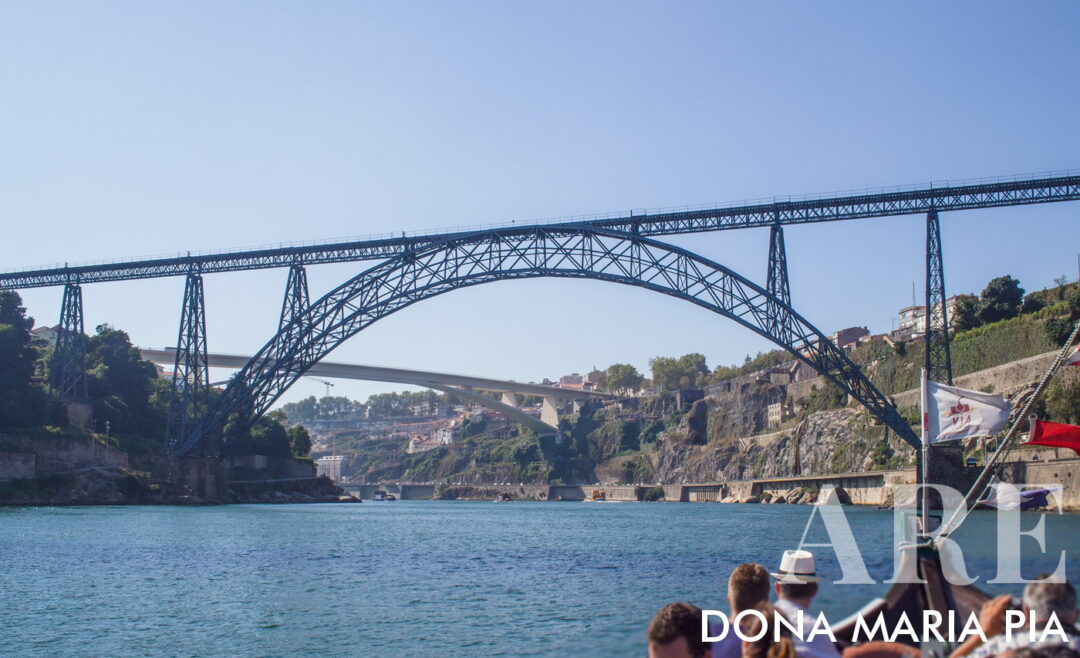
Dona Maria Pia Bridge, the oldest bridge in Porto with connection between Porto and Vila Nova de Gaia, inaugurated on November 4, 1877
Ponte D Maria Pia: Ponte Dona Maria Pia is the oldest bridge in Porto that connects Porto and Vila Nova de Gaia. The bridge symbolizes the advance of the city of Porto in the architecture of iron, considered the earliest city in Europe in the use of this material in civil construction. The bridge, considered a cutting edge work at the time, was built between 1876 and 1877 with a project by Théodore Seyrig, an engineer at Gustavo Eiffel’s company and approximately 150 workers worked on it, 1600000 kg of iron were used. The bridge was inaugurated on November 4, 1877, with the presence of Dom Luís I and Dona Maria Pia. The bridge was used for rail transport, connected to Lisbon, until the inauguration of the São João bridge in 1991. The bridge has some curiosities:
- The railway board is 354 meters long, 4.5 meters wide and 61 meters above the water level of the Douro River;
- The bridge starts the appearance of the train in Porto;
- When it was inaugurated, the Ponte D Maria Pia had the largest iron arch in the world with 160 meters span, that is, the two springs of the arch, and 42.60 meters of arrow;
- The first train to cross the bridge had 24 carriages and carried approximately 1200 passengers;
- The first person to cross the bridge was a woman: Dona Adelaide Lopes, wife of Pedro Inácio Lopes, Chief Engineer of the Royal Company of the Portuguese Railways;
- Dona Maria Pia Bridge is the only Portuguese monument on the list of the American Society of Engineering.
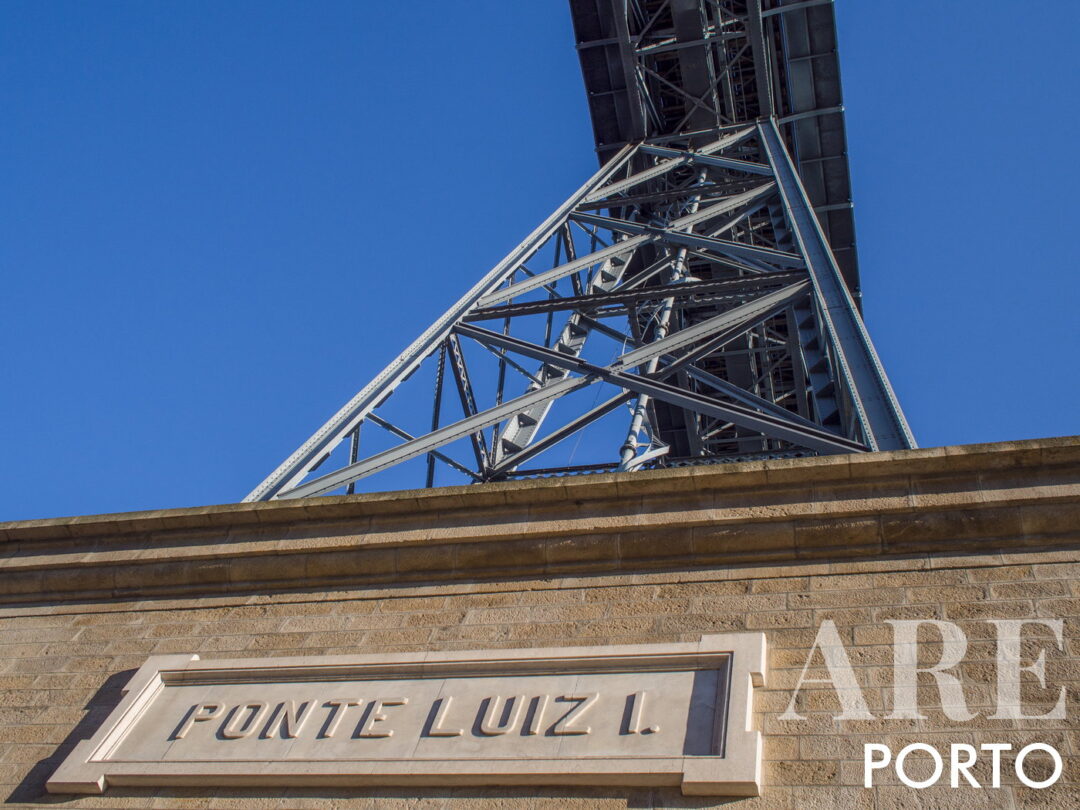
Pillar of the Luís I Bridge
Dom Luís I Bridge: the Luís I Bridge is the bridge that connects the Morro da Sé in Porto and the Serra de Nossa Senhora do Pilar in Vila Nova de Gaia and between the Ribeira in Porto and the Caves of Port Wine in Vila Nova de Gaia. The bridge was built between 1881 and 1887 with a project by Théodore Seyrig, author of the Dona Maria Pia Bridge on behalf of Gustave Eiffel’s company, on behalf of Société Willebroeck of Brussels, a third company. The bridge had two openings with the first opening of the upper deck of the bridge in 1886 and the second opening in 1887 with the launch of the lower deck. The Ponte Dom Luís I bridge presents several curiosities, namely:
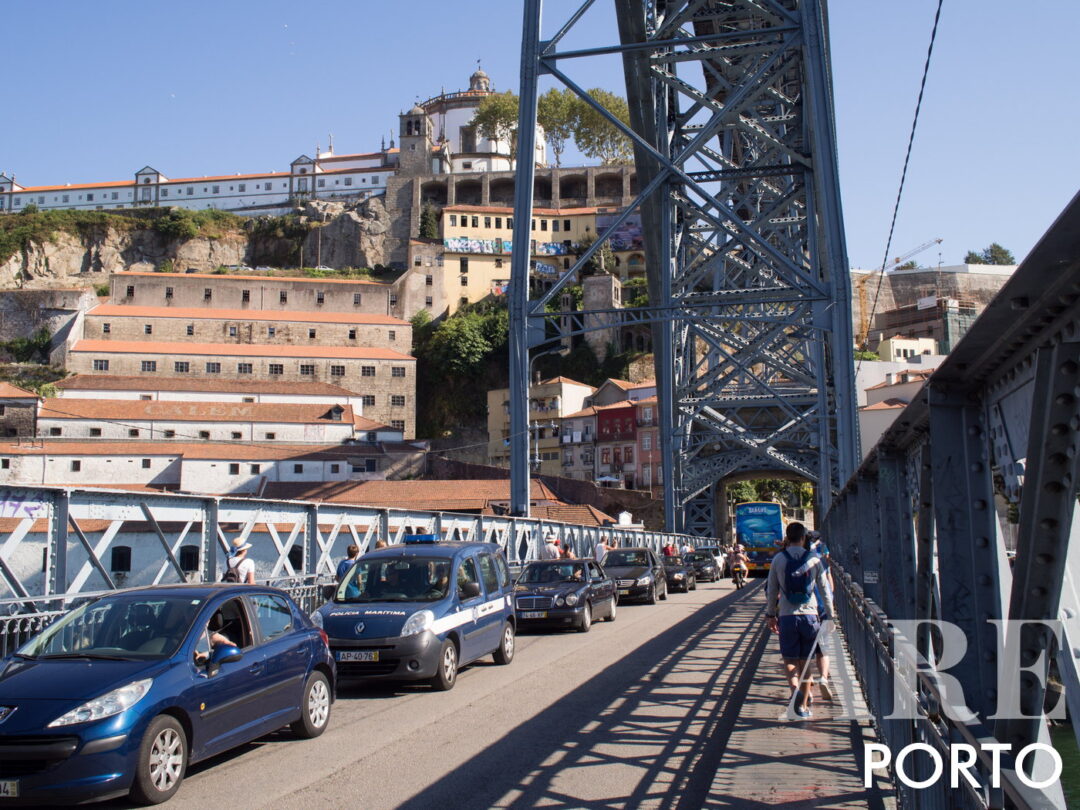
Pedestrian and road crossing of the Luís I bridge
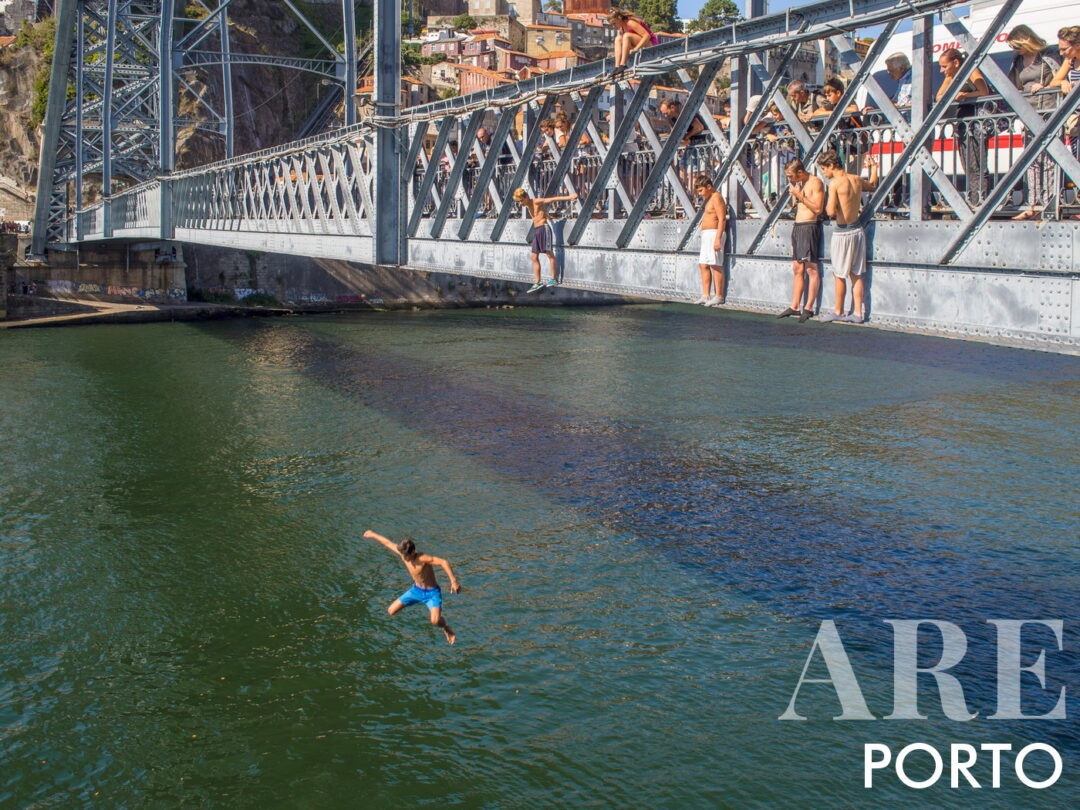
Teenagers jumping from Dom Luís I Bridge to the river, under the observation of tourists
- The bridge had a toll on the upper deck between 1886 and 1944;
- The upper deck is 392 meters long;
- The lower deck is 174 meters long;
- The upper tray integrates one of the Porto Metro Lines, with connection between the Cathedral, Jardim do Morro and Avenida da República in Vila Nova de Gaia;
- The upper deck can be crossed on foot, making the connection between the Cathedral of Porto and the Serra de Nossa Senhora do Pilar in Vila Nova de Gaia;
- The lower tray is used for the passage of motor vehicles and people. Connects the Ribeira in Porto and the Port Wine Cellars in Vila Nova de Gaia.
Ponte da Arrábida: the Ponte da Arrábida is the first large bridge designed over the Douro River built by the Portuguese. The Arrábida Bridge was inaugurated in 1963 with a project by the engineer Edgar Cardoso, known as “Engenheiro das Pontes” author of several works in the country, namely:
- 1968 Mosteirô Bridge over the Douro River;
- Ponte da Foz on the Sousa River, on the right bank of the Douro River in 1948 and was Edgar Cardoso’s first major work;
- São João Bridge;
The highlights of the Ponte da Arrábida are that in 1963 the Ponte da Arrabida was a bridge with the span of the largest reinforced concrete arch in the world: 270 meters; the bow has a total weight of 2200 tons; and as of 2016 the arch of the bridge has become the only arch that can be visited in Europe.
Ponte de São João: Ponte São João is a railway bridge, connecting the city of Porto and Vila Nova de Gaia. The São João Bridge was inaugurated on June 24, 1991, São João Day with a project by Edgar Cardoso. The bridge was built with the aim of replacing the Dona Maria Pia Bridge so that a more modern rail link between the two cities in the Douro was possible. The São João Bridge has as points of interest: three arches, two 125 meters long and the central arch 250 meters; and the existence of a laboratory at the base of the bridge where projects were made on a full scale.
Ponte do Freixo: Ponte do Freixo is a road bridge connecting Porto and Vila Nova de Gaia. Ponte do Freixo was opened in 1995 with a project by Professor António Reis. The bridge was built with the objective of clearing the intense traffic that existed at Ponte da Arrábida and at Ponte Dom Luís I. It has beams 18 meters wide; the bridge deck has four lanes in each direction; the bridge has eight spans; approximately 100 thousand vehicles pass daily on the bridge.
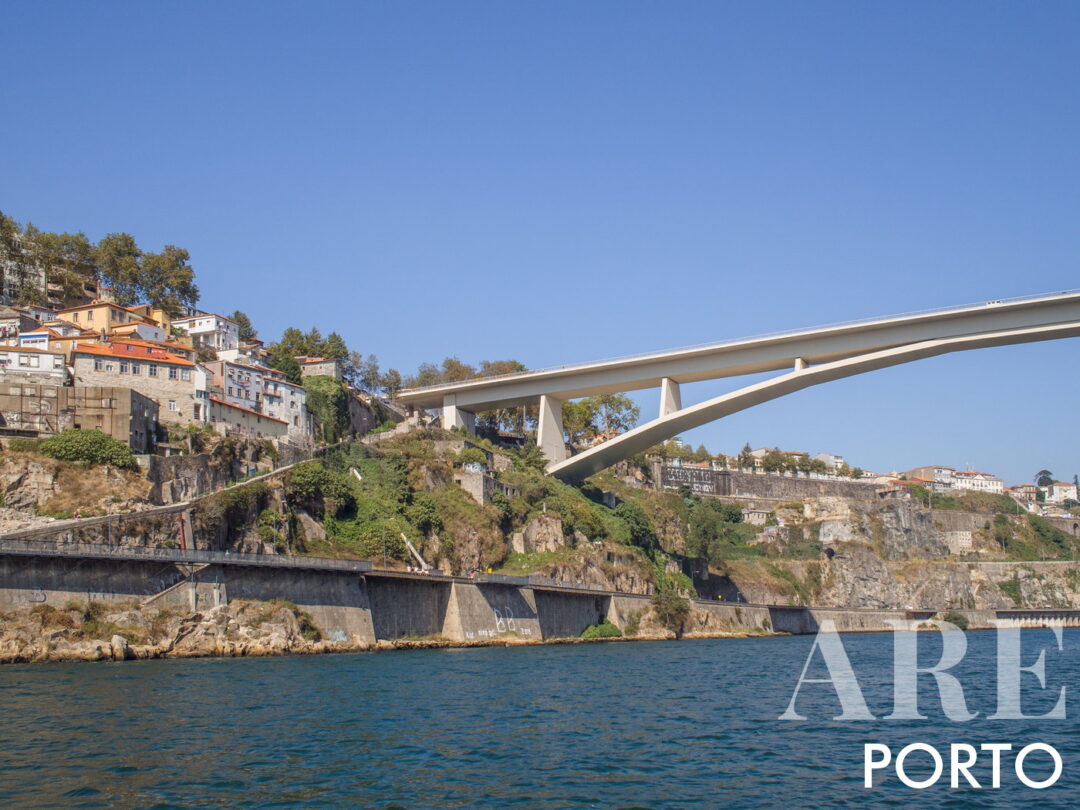
Ponte Infante Dom Henrique, commonly known as Ponte do Infante, is a road bridge connecting Vila Nova de Gaia to Porto
Ponte do Infante Dom Henrique: Ponte do Infante Dom Henrique is a road bridge connecting Vila Nova de Gaia and Porto. The bridge was inaugurated in 2003 with a project by António Adão da Fonseca and Francisco Milianes Mato. This bridge connects the area of Fontainhas, in Porto, and Serra do Pilar in Vila Nova de Gaia. The Ponte do Infante Dom Henrique has a concrete arch 280 meters high, being considered the fourth largest span in the world at the time of the inauguration; and the bridge deck is 371 meters long and 20 meters wide.
Historic Cafes of Porto
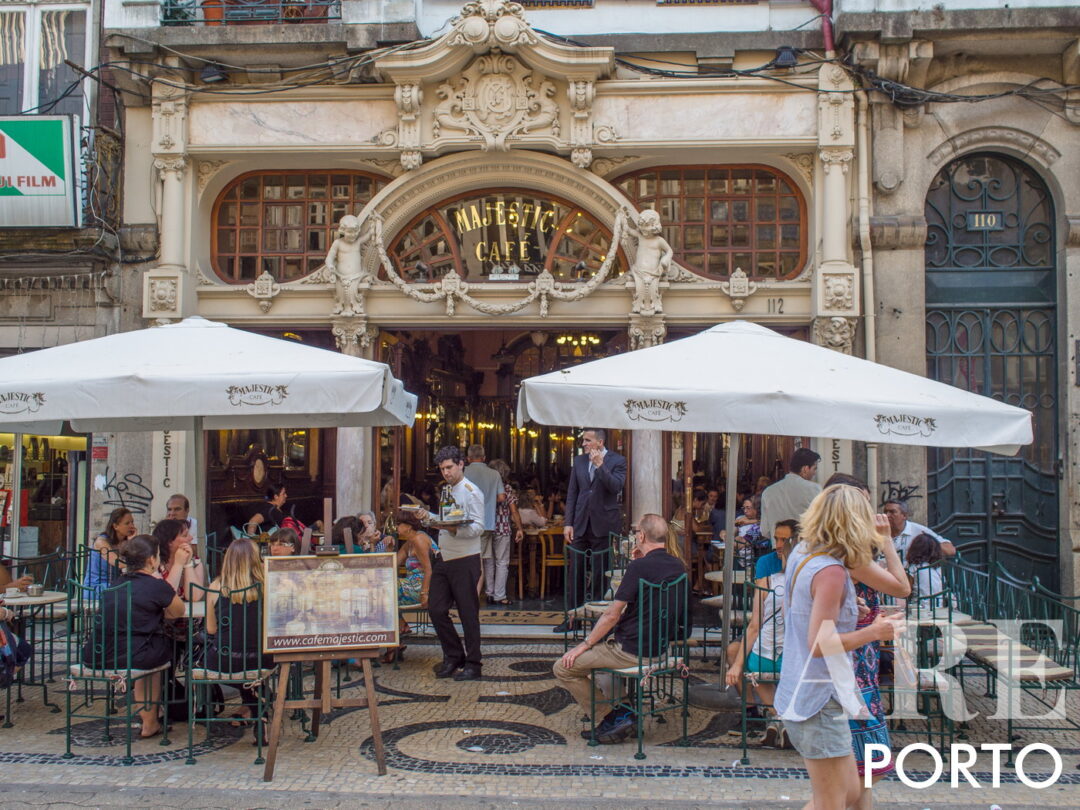
Café Majestic, a historic cafe located on Rua de Santa Catarina, one of the attractions of the city of Porto, has been frequented by several important figures throughout history
Café Majestic: Café Majestic is a historic cafe located on Santa Catarina Street. The Majestic was inaugurated in 1921 under the name Elite and immediately became an attraction in the city, it was frequented by several important figures throughout history, namely Gago Coutinho, Beatriz Costa, José Régio, Teixeira de Pascoaes or Leonardo Coimbra. Café Majestic experienced its heyday between 1921 and the 1960s through numerous conferences and conferences, a period in which it fell into decay until the reopening in 1994. In this cafe you can feel the rhythm and life of the Belle Époque Port from the 1920s, through the marble decoration, the furniture, the mirrors that surround the main room, the detailed decoration of the ceiling stucco, the chandeliers hanging from the ceiling and the presence of a pianist regularly performing live. Café Majestic was designed by João Queiroz in the Art Nouveau style, with an atmosphere surrounded by Belle Époque furniture; mirrors over 90 years old; an interior courtyard opened in 1925 with a project by Pedro Mendes da Silva; several gastronomic specialties, namely Chá das Cinco; French toast; nuts; pine nuts; Majestic breakfast.
Café Guarany: Café Guarany is one of the oldest cafes in Porto, located on Avenida dos Aliados. Café Guarany was opened in 1933 with a project by Rogério de Azevedo, it became known as the “Café dos Músicos” because it was the first café in the city of Porto to have a permanent mini orchestra and for being the only café in Portugal which provided cooling hot air in winter and cold air in summer. The cafe is named for honoring the tribe of Indians who lived in Paraguay, Paraná (Brazil) and Uruguay and for having been opened by two Brazilian businessmen. Guarany was renovated in 2003, and stands out for the exhibition of the screens “Os Senhores da Amazónia” by Graça Morais; and a bas-relief in marble representing an Indian, by Henrique Moreira and opened in 1933.
Café A Brasileira: Café A Brasileira is an emblematic cafe in the city of Porto, located at Rua Sá da Bandeira, opened in 1903 with a project by Francisco de Oliveira Ferreira and the restaurant area was opened to the public in 1938. Brasileira was used as a “battlefield” between supporters of the Salazar regime and opponents, with a curiosity: left-wing politicians sat at tables located on the right side of the cafe and politicians from on the left were the tables on the left of the space: Café a Brasileira was renovated and transformed into a hotel and restaurant for the Pestana Group, despite maintaining a room where the historic café still exists, with an iron parasol and a main facade glass; the interior decoration with marble and chandeliers; engraved leather furniture; sculptures by Henrique Moreira; the mirror by Max Ingram; and the alabaster designed by Vimioso.
Confeitaria do Bolhão: Confeitaria do Bolhão is the oldest confectionery in Porto, located on Rua Formosa in front of Mercado do Bolhão, opened in 1896 and purchased by current owners in 1998, who remodeled the space according to the original design. Confeitaria do Bolhão has several gastronomic specialties, namely more than 50 bread specialties; the Bolhão Tigelinha; Bolo-Rei, at Christmas time, is cooked according to a 19th century recipe; and the main façade is decorated with marble and the storefront with the manufactured sweets.
Café Imperial: Café Imperial is the space where McDonald’s is currently located, located on Avenida dos Aliados. Café Imperial was opened in 1936 with a project by Ernesto Korrodi and Ernesto Camilo, it became one of the most luxurious cafes in the city of Porto until 1995, when McDonald’s was opened. The building was classified as the most beautiful in the world. The café was the scene of several events, namely, it was a place of refuge for those resistant to the Salazar dictatorship when they ran along Avenida dos Aliados to escape the political police; Café Imperial had a space that was called “Sacristy”. There are two legends that are told about this space: it was called the Sacristy because it is close to the Sacristy of the Church of the Congregates, and it would be the place chosen by many priests to have lunch, especially on Monday, a day off. Café Imperial features a main entrance with a bronze statue representing an eagle by Henrique Moreira; the stained glass above the Art Deco service desk by Ricardo Leone; a bas-relief by Henrique Moreira; and the four huge chandeliers on the ceiling.
Porto Theaters
Teatro Sá da Bandeira: Teatro Sá da Bandeira is the oldest theater in Porto, located at Rua Sá da Bandeira. The theater was inaugurated in 1855 with the construction of a large wooden tent to allow the representation of plays by the Companhia Equestre de João Catalão, it became popularly known as “Teatro Circo”. The original structure of the theater grew over the years until the new structure in 1876, which coincides with the opening of Rua Sá da Bandeira. The Teatro Sá da Bandeira was the stage for several plays by national and international actors, namely Sarah Bernhardt (1844-1923 (: she acted at Sá da Bandeira in 1895 and was considered the greatest actress of the time; Laura Alves, Vasco Santana or Ruy de Carvalho among the national actors, the first cinema presentations in the city of Porto, with Sá da Bandeira being the first animatographer in Porto in 1897. Aurélio Paz dos Reis (1862-1931) made the first projections of Portuguese cinema and exhibited them in this space, and it was the first showroom in the city of Porto with electric artificial lighting.
Teatro Carlos Alberto: Teatro Carlos Alberto is a theater in the city of Porto, located at Rua das Oliveiras. The Carlos Alberto Theater was built by Manuel da Silva Neves and was thus designed to honor Carlos Alberto, King of Sardinia who died in exile in Porto in 1849. The theater was opened in 1897 with the aim of providing theater shows for the more disadvantaged. Teatro Carlos Alberto was purchased by the Porto City Council in 1993 and was renovated to Porto Capital of Culture in 2001 with a project by Nuno Lacerda Lopes.
National Theater of São João (1908): The National Theater of São João is one of the most important theaters in the city of Porto, located at Praça da Batalha. The National Theater of São João was opened in 1910 with a project by Marques da Silva. The Teatro de São João was built to replace the old Teatro do Príncipe, which burned down in 1908. The Teatro do Príncipe was inaugurated on May 13, 1798, the birthday of Príncipe Dom João, future King Dom João VI and was more later renamed as Real Teatro de São João. The Teatro de São João has some curiosities, namely, it was built with some of the stones of the old Teatro do Príncipe; the Teatro do Príncipe, the predecessor of the National Theater of São João, was built with some stones from the Fernandina Wall;
The main highlights are the painting of the vaulted ceiling of the Show Room by Acácio Lima; and sculptures by Henrique Moreira;
Teatro Municipal Rivoli (1913): Teatro Municipal Rivoli is one of the two municipal theaters in the city of Porto, located at Rua do Bonjardim. Teatro Rivoli was opened in 1913 under the name National Theater, changed its name in 1932 to Teatro Rivoli. The theater reached its peak during the 1940s and 1950s with the management of Dona Maria Borges, wife of one of the owners of the former bank Borges e Irmão. After this golden period, the theater changed ownership until in 1992 it was purchased by the Porto City Council, which temporarily closed it to be remodeled with a project by Pedro Ramalho and reopened in 1997. The main highlights of Teatro Municipal Rivoli they are: the main façade with a bas-relief representing the Theater and the Performing Arts by Henrique Moreira; the Manuel de Oliveira auditorium; the Café Concert; and the restaurant.
Coliseu do Porto: The Coliseu do Porto is the largest concert hall in the country, located on Rua de Passos Manuel. The Coliseum was opened in 1941 in the Modernist style and involved the participation of several architects, namely:
- Cassiano Branco (1897-1970): Cassiano Branco was one of the most important architects in the country during the 1930s and 1940s and was the author of several projects such as the Edifício Cine-Teatro Éden and Avenidas Novas in Lisbon, by Portugal dos Pequenitos in Coimbra and the Benguela Railway Station in Angola;
- José Porto: author of several works such as Casa de Manoel de Oliveira in Porto, Hotel Bergère in Paris, remodeling of the Grande Hotel da Batalha hotels and the Hotel Sul Americano in Porto or the Emporium Building on Sá da Bandeira street also in Porto;
- Yan Wills: author of the Olympic Stadium in Amsterdam;
- Júlio de Brito: Júlio de Brito was the author of some works, namely the Teatro Rivoli and the building of the Junta de Freguesia da Cedofeita;
- Charles Siclis (1889-1942): French architect responsible for some works in Portugal, namely Casa de Serralves.
The main points of interest of the Coliseu do Porto are: the main façade designed by José Porto (1883-1965); the Main room with a capacity for three thousand seats; the Coliseu Grande Bar; and Room Two.
Campo Alegre Theater: the Campo Alegre Theater is one of the two municipal theaters in the city of Porto, located at Rua das Estrelas. The Campo Alegre Theater emerged as part of a group of buildings built in the Boavista area after the inauguration of the Arrábida Bridge in 1963, namely the Museum of Contemporary Art of the Serralves Foundation, the Casa da Música, the University of Campo Alegre Planetário do Porto. The theater is the headquarters of a historic Theater Company in Porto, Seiva Trupe. The Campo Alegre Theater has an Auditorium; Café Teatro; Studio Room; and Cine-Estúdio.
Caves of Gaia, Porto
Burmester: Burmester Caves are one of the oldest Port wine cellars, located in Largo Dom Luís I. Burmester was created in 1750 by Henry Burmester and John Nash and started growing from 1880 when Johann Wilhelm Burmester bought several businesses, namely a company that produced bottles, and two ships to transport Port Wine to Vila Nova de Gaia. Johann Wilhelm Burmester ended up dying in a shipwreck on the Cadouços beach in Foz do Porto in 1885, passing on the company’s management to his sons. Burmester produces wine at Quinta do Arnozelo, located on the left bank of the Douro River, between São João da Pesqueira and Vila Nova de Foz Côa, on a farm with approximately 100 hectares and located at 300 meters altitude. The main varieties of the Burmester Caves are Touriga Nacional, with approximately 50% of production; Touriga Franca; Tinta Roriz; and Tinto Cão.
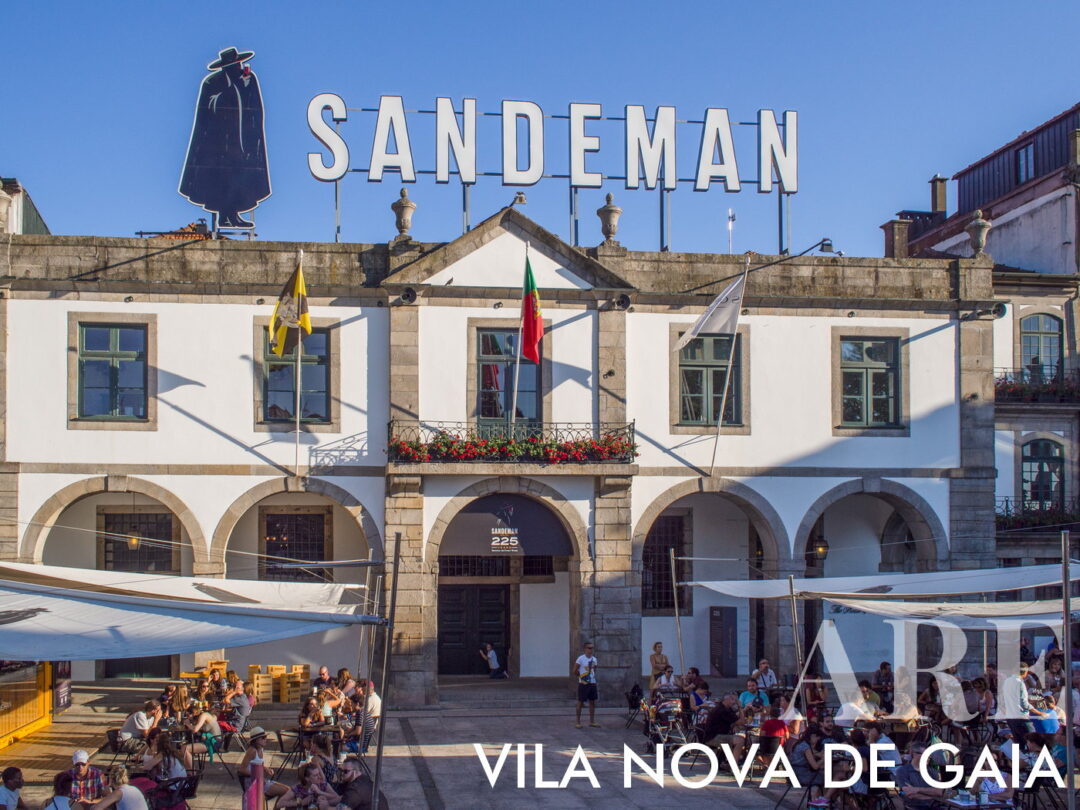
Sandeman Cellars created in 1790 by Scotsman George Sandeman, was the first Port Wine production company to register the first barrel in 1805
Sandeman: Sandeman Caves are a Port Wine production company, located at Largo Miguel Bombarda. The Sandeman Caves were created in 1790 on the initiative of Scotsman George Sandeman and were the first Port Wine production company to register the first barrel in 1805. Sandeman is especially known for the brand’s logo, which represents a man dressed in black with a large wide-brimmed hat and a cape. The main highlights of the Sandeman Caves are the headquarters building built in granite and located in the historic center of Porto; Quinta do Seixo, located in the municipality of Tabuaço, in the heart of the UNESCO World Heritage region; and The George restaurant.
Espaço Porto Cruz: Espaço Porto Cruz is a place where you can taste Port Wine and observe the historical evolution of Port Wine, located at Largo Miguel Bombarda. The main highlights of Espaço Porto Cruz are Quinta de Ventozelo; the Gran Cruz House Hotel; the Porto Cruz Wine Boutique; the Porto Cruz Restaurant; and the 360 Terrace.
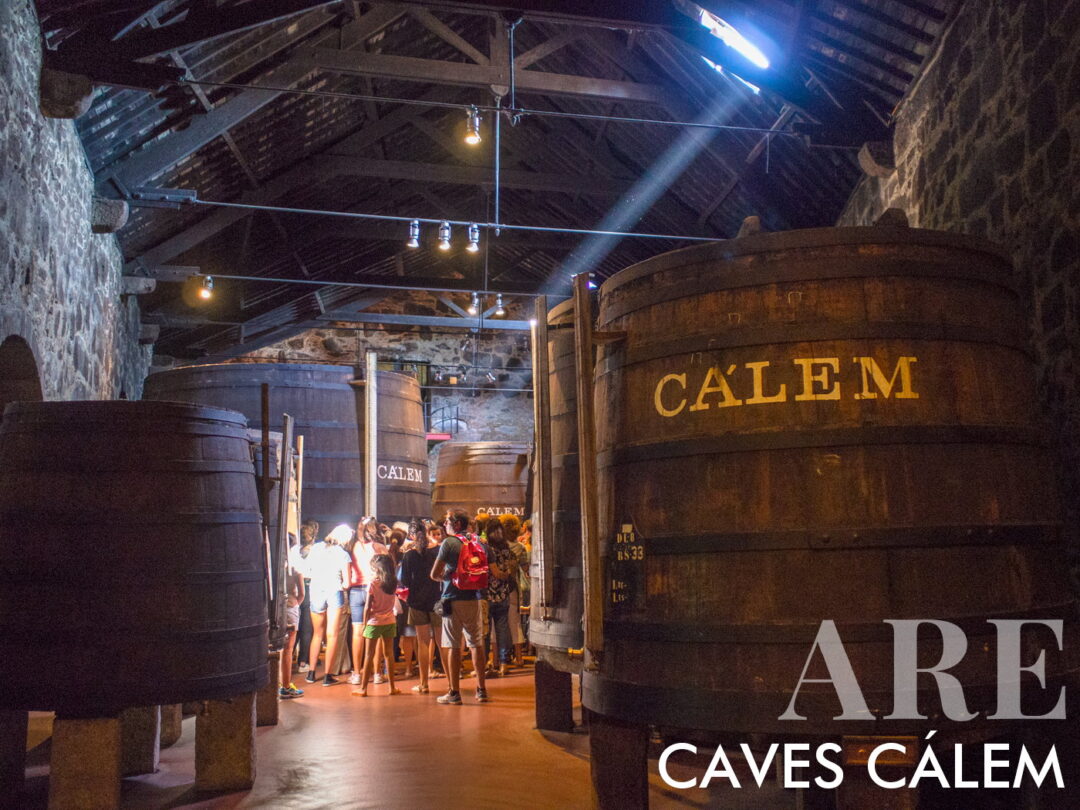
Visit to the CÁLEM Port wine cellars, with traditional wine silos built in natural wood
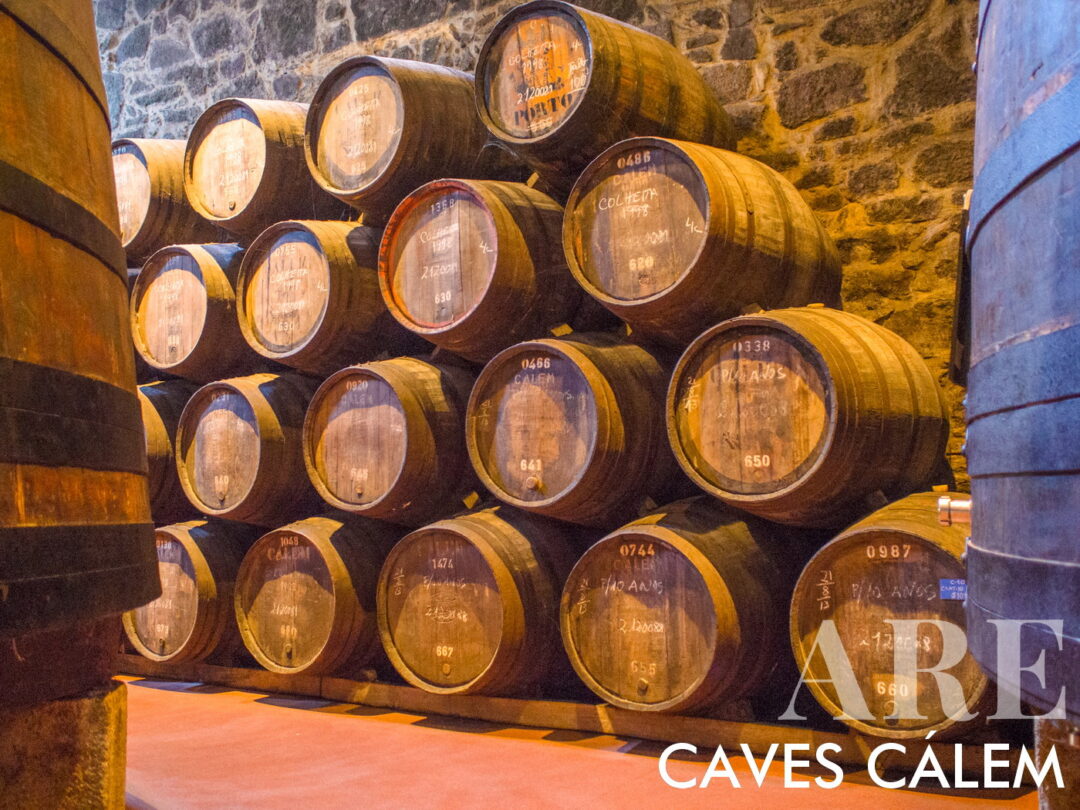
Wine barrels stored with the 1998 harvest in the CÁLEM cellars in Vila Nova de Gaia
Cálem: Cálem Caves are the owner of the number one Port Wine brand in Portugal, located on Avenida de Diogo Leite. The Cálem Caves were founded in 1859 by António Alves Calem with the objective of exporting wine to Brazil, which constituted a new route at the time. The attractions of the Cálem Caves are the Museum; the Cellars; and the store.
Adriano Ramos Pinto: Adriano Ramos Pinto located on Avenida Ramos Pinto in Porto, is one of the most important Port wine companies in Brazil, where it holds more than half of the market for this type of wine. The company was founded by Adriano Ramos Pinto in 1880 and immediately stood out for its different strategy and innovation regarding Port Wine, namely, in the creation of labels for specific niches such as the Armed Forces of Brazil, with a label created with the inscription “Army and Navy”; for the Clergy, with the label “Port Wine for Prelates”; and for the female audience, with the label “Porto Fonte” and “Porto Brasil”.
Creation of medicinal wines, namely Febrífugo Port Wine; and Porto Quinado.
Adriano Ramos Pinto was one of the first cellars to use Portuguese grape varieties in the production of wine, and to mix grapes from different regions and altitudes.
The main highlights of the Adriano Ramos Pinto cellars are: Quinta da Ervamoira; Quinta do Bom Retiro; Quinta da Urtiga; Quinta de Bons Ares; and the Ramos Pinto Museum.
Ferreira Caves: Ferreira Caves are one of the most important Caves in the history of Port Wine, located on Avenida de Ramos Pinto. The cellars were created in 1751 and had a great growth with Dona Antónia Adelaide Ferreira (1811-1896), known as “A Ferreirinha”, who was respected and admired by everyone due to her great generosity and entrepreneurial spirit. “A Ferreirinha” took on this role after her husband’s death on a boat trip in Régua, where, according to the legend, she was drowned because her pockets were full of gold coins. Dona Antónia managed to survive the disaster due to the size of the skirt she had worn and which functioned as a buoy. The main points of interest of Ferreira Caves are: the Garrafeira Vintage, with Vintage wine, the only Port wine that can age in bottle. This cellar has been offering wines since 1815, 1820, 1834, 1847 and thousands of bottles left as an inheritance by “Ferreirinha”; and the Ferreira Caves building, an old convent that stands out for its size and for its wooden decoration inside.
The Viewpoints of Porto
Serra do Pilar viewpoint: the Serra do Pilar viewpoint is a viewpoint in Vila Nova de Gaia, located in Largo Aviz. The Serra do Pilar viewpoint is also called Jardim do Morro and, despite being in Vila Nova de Gaia, it is the viewpoint from where we can enjoy the best panoramic view over the city of Porto. The points of interest of the Serra do Pilar viewpoint are the view over the city of Porto, the Douro river and Vila Nova de Gaia; the Monastery and Church of Nossa Senhora do Pilar; the Dom Luís I Bridge; and the Cable Car.
Miradouro da Sé Catedral: Miradouro da Sé Catedral is one of the most popular viewpoints in the city, located in Terreiro da Sé. The main points of interest at Miradouro da Sé Catedral are the panoramic view over Ribeira, Vila Nova Gaia and the city of Porto; the Cathedral of Porto; and the Episcopal Palace.
Nossa Senhora da Vitória viewpoint: Nossa Senhora da Vitória viewpoint is a more hidden viewpoint of the city, located at São Bento da Vitória street. The viewpoint is in the heart of Bairro do Olival, an old Jewish quarter, overlooking Vila Nova de Gaia, part of Porto and Ponte Dom Luís; the Church of Nossa Senhora da Vitória; and the labyrinthine streets of the old Jewish quarter.
Bandeirinha da Saúde viewpoint: The Bandeirinha da Saúde viewpoint is a popular viewpoint for Porto residents, located on Rua da Bandeirinha. This viewpoint is so named because of the introduction of the so-called “health flag”, introduced by Filipe I. The flag was hoisted after the health examination was carried out to determine who had and who did not have the Black Death. The flag was hung on the granite tower executed by Bastião Fernandes. Here we can glimpse the panoramic view over the Arrábida Bridge, the Customs, the Crystal Palace and the Douro River; the Fonte das Virtudes and the steps of the Jardim das Virtudes that will lead to Miragaia.
Miradouro das Fontainhas: Miradouro das Fontainhas is a little-known viewpoint in Porto, located at Gomes Freire Street. The viewpoint is a privileged place in the city due to the view over four of Porto’s six bridges: Ponte Luís I, Ponte do Infante, Ponte Dona Maria and Ponte de São João; the panoramic view over the Douro River and the Monastery of Nossa Senhora do Pilar; and for being a privileged place to watch the fireworks on the night of São João on the 24th of June.
The city of Porto can be divided into four main areas:
Historic Center: classified as World Heritage by UNESCO in 1996 is the oldest area in the city. This part of the city has narrow streets built along the Douro River, buildings from two to three floors with commerce, handicrafts and typical Porto cuisine. It has a confusing and gloomy aspect but attractive and special to anyone who wants something different and unique. The historic center of Porto must be visited on foot, although it is possible to do it by segway, tuk tuk, bus, minibus or boat. This part of the city includes the Sé district, the highest area of Porto, a neighborhood that has not changed since the Middle Ages, Barredo, and Ribeira, a riverside area.
Baixa da Cidade: this area includes Praça da Liberdade, Avenida dos Aliados, Rua de Santa Catarina, Rua Sá da Bandeira and the Galearias de Paris area. Praça da Liberdade is where the Porto City Hall building and the statue of D. Pedro IV are located. Avenida dos Aliados is the main avenue in Porto. Its name is a tribute to the countries that constituted the Allies of the First World War of 1914-1918. Along this avenue there is a large concentration of banks, offices, terraces and cafes. The main highlight of this avenue is the Water Mirror. Rua de Santa Catarina is 1500 meters long and is the busiest and most commercial street in Porto, with part of it cut off by car traffic. The Rua de Santa Catarina has clothing stores, souvenirs, shoe stores, jewelry and other products. All of these stores have some characteristics: on the floor there is the Portuguese sidewalk. In this street there is a shopping center with a unique characteristic, since it is the only shopping center in Portugal that was designed as a way to recreate the Ribeira do Porto area. Each restaurant in the food area of the Via Catarina shopping center represents a restaurant that exists in Ribeira. Writers and poets such as António Nobre, Arnaldo Gama, Camilo Castelo Branco and Guerra Junqueiro lived on Rua de Santa Catarina. Next to Rua de Santa Catarina is Rua de Sá Bandeira with another of Porto’s ex-libris: Mercado do Bolhão, famous for the auctions of women typically from Porto selling fish and fresh produce. On Rua Sá da Bandeira there is the Teatro Sá da Bandeira, one of the most important in the city, and the Teatro Rivoli, a landmark in the modern magazine theater. On this street there is also a cafe symbol of the city: the café A Brasileira. Here you can also find typical Porto houses. On Rua Sá da Bandeira, there is the Mercado do Bolhão, built in 1850. This market specializes in cod, Port wine, cheeses, sausages and regional bread. Baixa da Cidade is complete with Rua dos Clérigos, which includes the Galerias de Paris known for its nightlife, a place similar to Bairro Alto de Lisboa, the University of Sciences of Porto, the Museum of Photography, the Hospital de Santo António, the Third Order and Livraria Lello.
Avenida da Boavista: 6 km long, it is the largest avenue in the city. Built in 1917, it is the real economic center of Porto, where the main offices of companies in the country are located. This avenue is surrounded by shops, houses and hotels. In Avenida da Boavista there are several events, namely the Circuito da Boavista. This is where structures such as the Serralves Foundation, Casa da Música, the city’s main green space, Parque da Cidade, are located. At the end of this avenue is the area where the francesinha was created: there was a house near the Boavista roundabout that created this Porto delicacy.
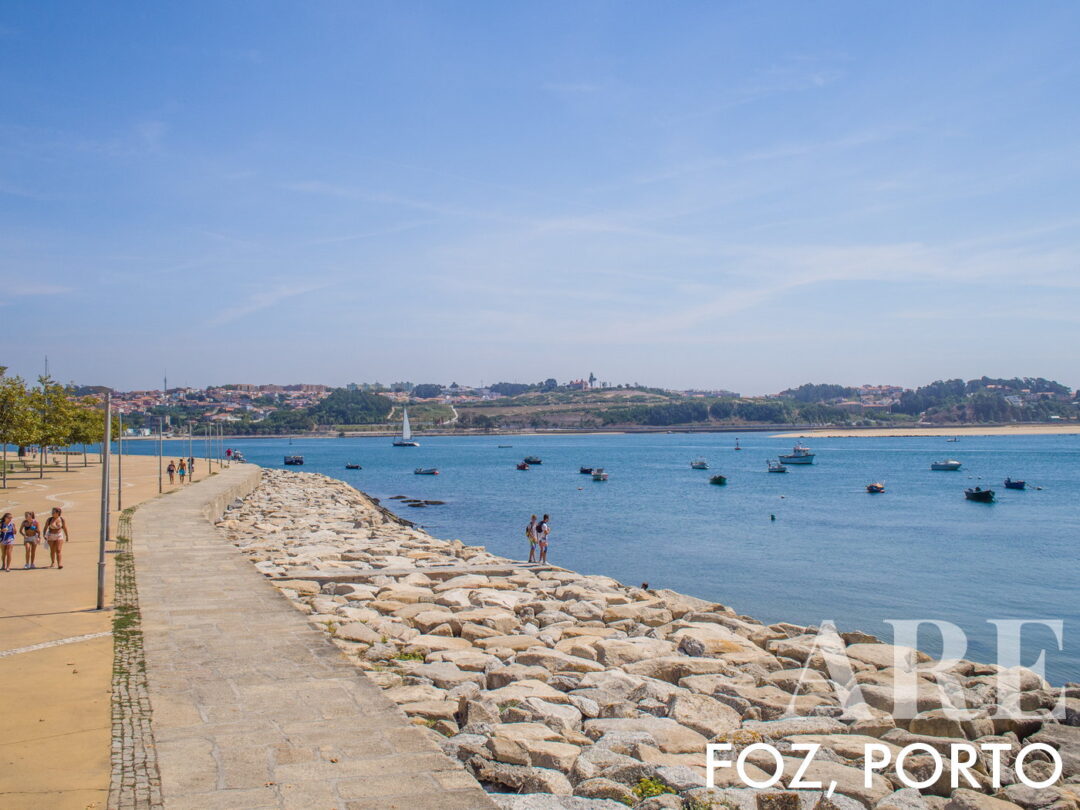
Jardim do Passeio Alegre, next to Foz do Douro
Foz do Porto: Foz do Porto is one of the richest and most beautiful places in the city. In Foz it is possible to walk, run or ride a bicycle on a wall built in the 1930s. In this area of Porto, the main attractions are Praia do Molhe, Praia da Luz, Praia do Homem do Leme and Castelo do Queijo .
Main Streets and Squares of Porto
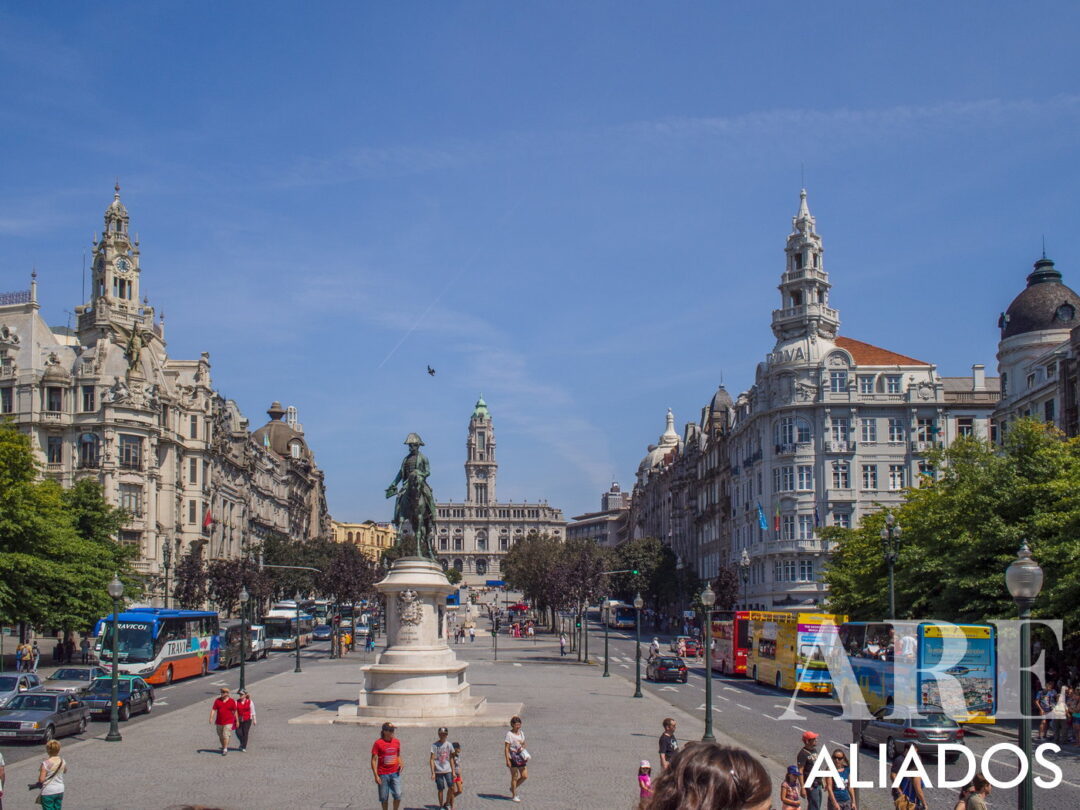
Avenida dos Aliados, the main avenue of Porto, local to the Porto City Hall building; the Cardosas Palace; the Statue of Porto; the Almeida Garrett Statue; the Equestrian Statue of Dom Pedro IV; and the former headquarters of Café Imperial.
Avenida dos Aliados: Avenida dos Aliados is the most important avenue in Porto, considered the “visiting room of Porto” and the heart of the city. This avenue was designed in two distinct phases: In 1916 with a project by the English urban planner Barry Parker (1867-1947) and Porto architect Marques da Silva in the place where the old Bairro do Laranjal existed; and the renovation of the avenue to Porto, European Capital of Culture 2001 with projects by Siza Vieira and Souto Moura.
The avenue was inspired by the French Boulevard of Flemish origin that was in fashion throughout Europe during the first half of the 20th century. Avenida dos Aliados is the place of excellence for civic life in the city of Porto, where the most important parties and events in the city are held, namely the New Year’s Eve, São João Festivities, Queima das Fitas or the victories of Futebol Clube do Porto, the most important football club in the city. The main points of interest are the Porto City Hall Building; the Cardosas Palace; the Statue of Porto, a statue that represents a Roman warrior, designated as Porto. This monument was at the top of the Monteiro Moreira Palace, which existed in the current Praça da Liberdade and was the space where the Porto City Hall functioned until it was destroyed in 1916, the year when the construction of Avenida dos Aliados began; the Almeida Garrett Statue; the Equestrian Statue of Dom Pedro IV; and the former headquarters of Café Imperial, now Mcdonald’s.
Praça da Liberdade: it is the old Praça Nova, or Praça Dom Pedro, which changed its name after the implantation of the Republic in 1910. The main highlights are the Palácio das Cardosas, purchased by Manuel Cardoso dos Santos, left to wife and daughters and is therefore known as Palácio das Cardosas; and the Equestrian Statue of Dom Pedro IV;
Praça Dom João I: it was built at the same time as Avenida dos Aliados, thus designated to honor Dom João I, a King who was important to the city’s history. The highlights of Praça Dom João I are the Atlantic Palace; the Rivoli Municipal Theater; the Realto Building, designated as the “skyscraper of Porto” because for years it was the tallest building in the country. The building was inaugurated in 1944 with a project by Rogèrio de Azevedo; and the Corcéis, two statues by João Fragoso, representing a man dominating a wild horse.
Praça Dona Filipa de Lencastre: designed by Barry Parker, it was part of the construction plan for Avenida dos Aliados. The main points of interest are the Edifício do Comércio do Porto, considered one of the first modernist projects in Portugal, having been built between 1928 and 1932, the building was designed by Rogério de Azevedo; the Hotel Infante Sagres, built by Delfim Ferreira, an industrialist from Riba de Ave, was decisive for the economic development of the north of the country. The hotel was designed by Rogério de Azevedo and started to be built in 1945, being the first luxury hotel in the city of Porto. The highlights of the are the sculptures of Barata Feyo; paintings by Abel Moura and Artur da Fonseca; and Leone stained glass.
Terreiro da Sé: is the birthplace of the city of Porto, the original nucleus of the city. Terreiro da Sé was designed and altered in 1939 with a project by Arménio Losa and executed to celebrate the three hundred years of independence from Portugal (1640-1940), celebrated throughout the country, namely: in Guimarães with the reconstruction of the Palace the Duke and the Castle; in Braga; Vila Viçosa; and in Lisbon, with the reconstruction of São Jorge Castle.
The medieval city of Porto lasted until 1940, being common to have streets glued to the Cathedral. The street in front of the Cathedral was one of the widest streets, with approximately nine meters wide, it was the place where the market was held during the Middle Ages. Currently, we can observe on the south tower pillar the official measures that were used by merchants for the installation of stalls on the market during the Middle Ages. The main points of interest at Terreiro do Sé are: the Porto Cathedral; the Episcopal Palace; Casa do Cabido; and the panoramic view over Porto and Vila Nova de Gaia.
Avenida da Boavista: Avenida da Boavista is the largest avenue in Porto, approximately 5.5 km long. Boavista is named after the presence of Quinta da Boavista, known as Quinta de Santo Ovídeo and the “Boa Vista” that was obtained from there. This avenue is also known as Quinta de Santo Ovídeo, due to being in Campo de Santo Ovídeo, current Praça da República, and in Monte de Germalde, where the Church of Lapa is located. Avenida da Boavista begins at the Military Hospital of Porto and ends at Praça de Gonçalves Zarco, next to Foz do Douro. This avenue started to be built in 1850 and became the economic and cultural center of the city of Porto. The main attractions of Avenida da Boavista are: the Dona Maria Pia Children’s Hospital; the Dom Pedro V Military Hospital, the first military hospital built from scratch in Portugal, opened in 1962; the William Graham Urbanization, so named due to the presence of the old Textile Factory, one of the largest in the city, known by the Porto people as “A Fábrica dos Ingleses”; the Doctor António Cupertino de Miranda Foundation; the Museum of Paper Money; the Casa da Música; the City Park; and the Serralves Foundation.
Praça de Mouzinho de Albuquerque / Rotunda da Boavista: so designated since 1903 to honor Mouzinho de Albuquerque (1855-1902), Governor of Mozambique. The Praça de Mouzinho de Albuquerque is commonly called by the people of Porto as “Rotunda da Boavista”, with two important infrastructures for the city, namely, the first train station in Porto, the Porto Railway Station, built in 1875. Currently we can observe the ruins of this building; and the Real Coliseu Portuense, a bullring that was not very successful with the population, between 1889 and 1895;
Boavista was also the scene of important political and sporting events, namely the Boavista Auto Racing, Formula 1 races between 1951 and 1960. The main highlights are the Monument dedicated to the Peninsular War, designed to be inaugurated during the centenary of the French Invasions in 1909, however, it was not opened until later with the intervention of sculptors Alves de Sousa, Henrique Moreira and Sousa Caldas; and the Brasília Shopping Center, the first shopping center in Porto, opened in 1977.
Rua das Flores: Rua das Flores is one of the busiest streets in the city of Porto, located in downtown Porto. This street was called Santa Catarina das Flores street and was built by Dom Manuel I on land in the Cabido do Porto, that is, the city clergy. Due to this particularity, it is still possible to see the coat of arms in several buildings and palaces where the Bishops and Clerics of Porto lived.
Rua de Cedofeita: named after the Church of São Martinho da Cedofeita, built in 559. The street stands out due to the typical houses of the 18th century and the presence of the Church of Cedofeita, considered the oldest church in the Port.
Rua das Carmelitas: Rua das Carmelitas is named after the old Convent of São José and Santa Teresa das Carmelitas Descalças in the 18th century. The highlights are the Jardim das Oliveiras, the place where the Mercado do Anjo was held in the 19th century; and Livraria Lello.
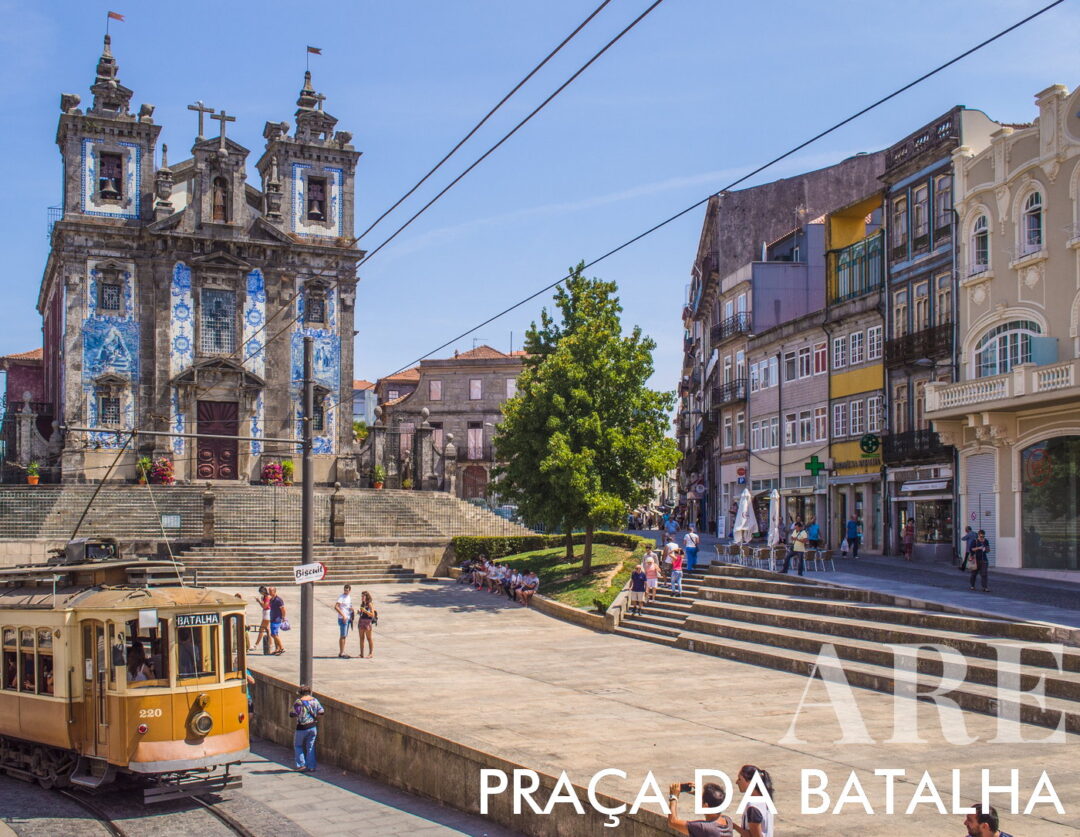
Batalha Square with the Church of Santo Ildefonso, and the typical tram of Porto
Praça da Batalha: it is so named because it was the site of a bloody battle between the Muslim army led by Almançor and the people of Porto in the 10th century. The people of Porto were defeated and this caused the city to be devastated. The highlights are the Church of Santo Ildefonso; and the Statue of Dom Pedro V, in honor of Dom Pedro V who declared Porto as “The most industrial Portuguese city”.
— 38IMAGE
Ribeira: Ribeira emerged during the Middle Ages, a place of intense maritime trade. Nowadays it is a tourist area where it is possible to taste the famous Porto cuisine, namely Francesinha or Tripas à Porto style, and a place of nightlife that is much sought after by the inhabitants and visitors. The main highlights of the Ribeira area are the Escadas do Barredo, a street hidden behind the Ribeira wall. This neighborhood is a grand staircase inhabited by fishermen, fish sellers and bourgeois fishermen. The main highlights are the houses built practically overlapping, the humility and genuineness of the inhabitants, the various cafes and bars that exist in each corner; the Dom Luís I Bridge; the “Ribeira Negra”, a tile panel by Júlio Resende (1917-2011). Júlio Resende painted an engraving 40 meters long and 3 meters wide in 1984 that we can visit at the Museum of Transport and Telecommunications of the Alfândega do Porto. Júlio Resende adapted this 40-meter canvas on the ceramic panel found in the Ribeira neighborhood and where we can observe the daily lives of the people of Ribeira during the 1980s.
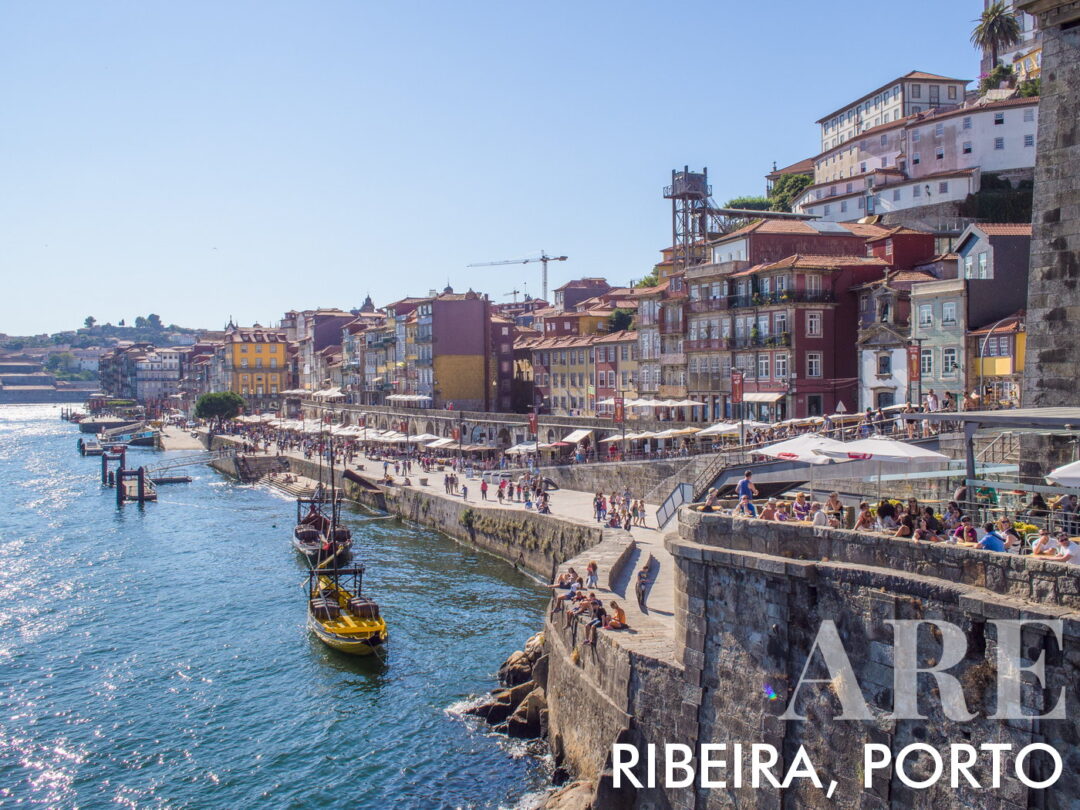
View of Ribeira do Porto, riverfront restaurants, bars and terraces with visitors, and traditional buildings facing the river. One of Porto’s great attractions
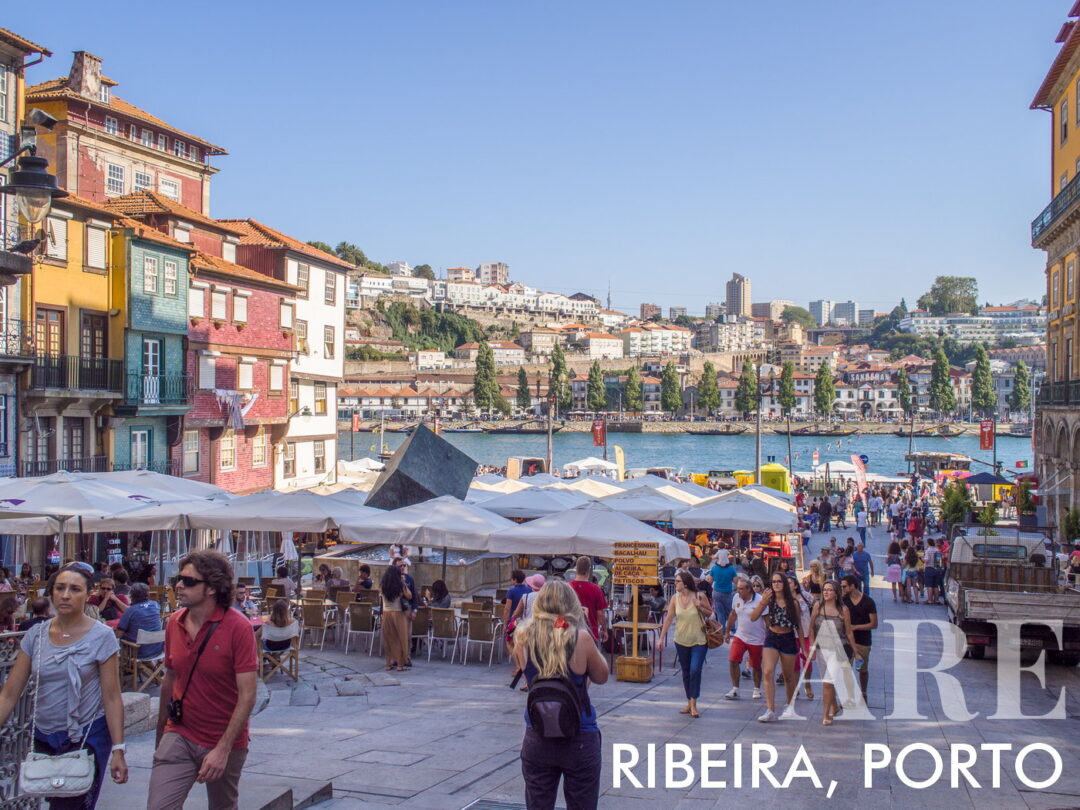
Praça da Ribeira, on the coast of Porto, with terraces and restaurants, overlooking Vila Nova de Gaia and the Douro river. Praça da Ribeira, popularly known as “Praça do Cubo”
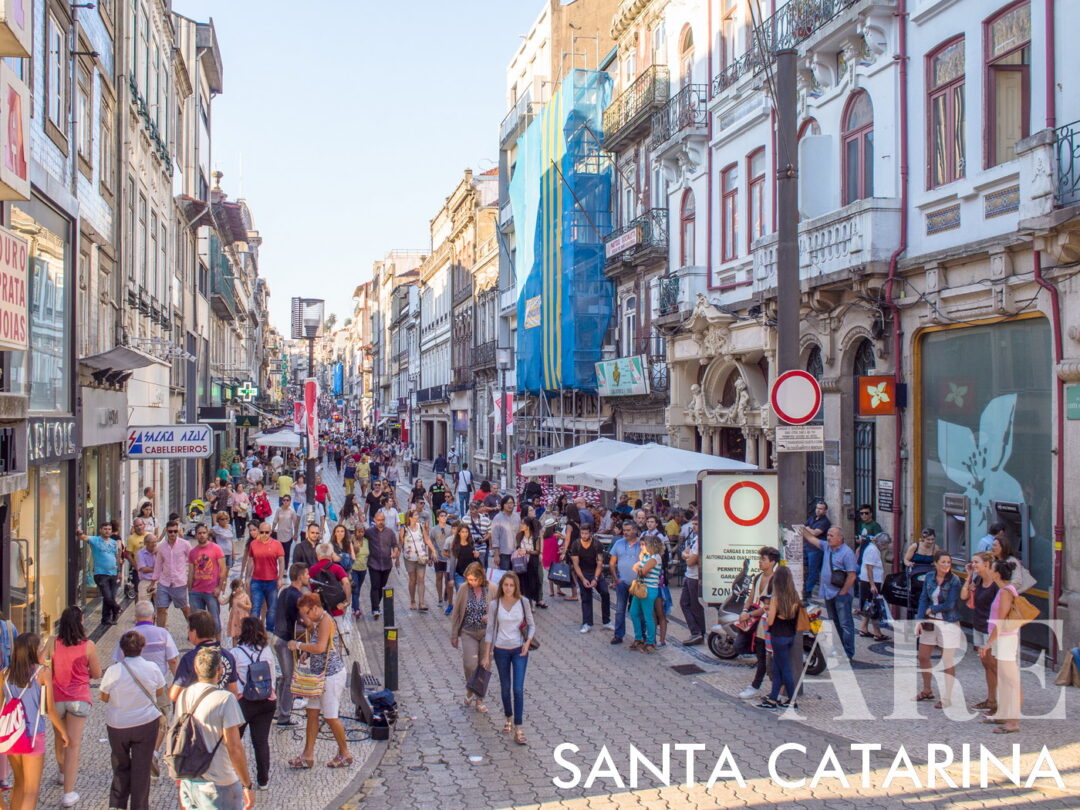
Rua de Santa Catarina, an open-air shopping street, is one of the most noble and busy streets in Porto
Rua de Santa Catarina: it is the commercial area of Porto, formerly Rua da Bela Princesa, and has been renamed Santa Catarina due to two main reasons: the Dedication to Santa Catarina de Alexandria; and because it was in this area of the city that Quinta de Santa Catarina was located, a farm with a small chapel dedicated to Santa Catarina de Alexandria (287-305). Santa Catarina was born in Alexandria in a noble family and was one of the victims of the persecutions carried out by Emperor Maximian. Santa Catarina is the patron saint of students, philosophers, lawyers and is always represented on canvas or sculpture with the following symbols:
- Broken Wheel, associated with the miracle in which he undid the cog wheel, where he was going to be tortured, with the sign of the cross;
- Palma: associated with death by Faith;
- Hands: hands symbolize service to others
- Sword: means struggle, death and rebirth;
The highlights of Rua de Santa Catarina are: Capela das Almas; the Majestic Café; the Via Catarina Shopping Center; and local shops.
Praça Gonçalves Zarco: so designated to honor Gonçalves Zarco, the Portuguese navigator who discovered the island of Madeira. This square has some highlights, namely: the Forte de São Francisco Xavier, popularly known as Forte do Queijo because when it was built in the 15th century, there was a circular rock there and it was known as Rochedo do Queijo; and the Equestrian statue of Dom João VI by the sculptor Barata Feyo, a replica of the statue that Porto offered to Brazil.
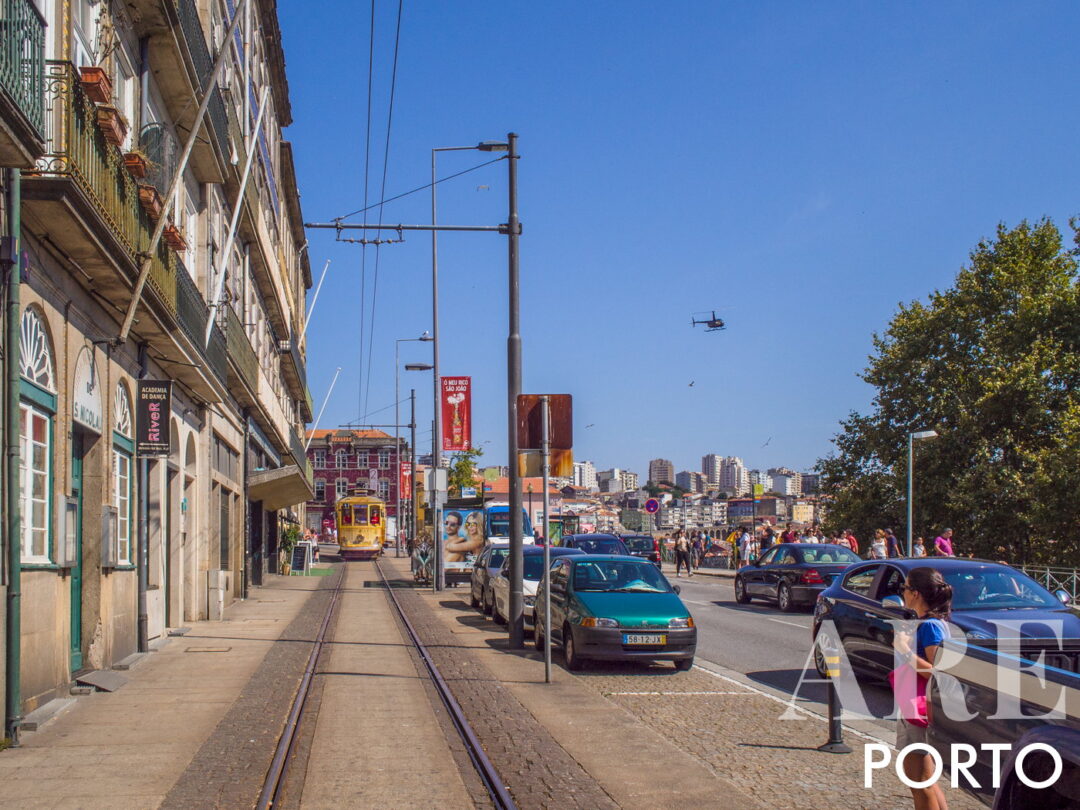
Rua da Alfândega, place of the birthplace of Dom Infante Henrique
Rua da Alfândega: Rua da Alfândega was designated as Rua da Alfândega Velha until the 14th century and was known for being the place where the birthplace of Infante Dom Henrique is located and one of the paths that leads to the Ribeira. The main highlights are Casa do Infante; and the Ribeira area.
Rua de Ferreira Borges: Rua Ferreira Borges is thus designated to honor the Porto politician Ferreira Borges. Here we can visit the following attractions: the Ferreira Borges Market; the Church of San Francisco; and the Palácio da Bolsa.
Rua dos Clérigos: it was the old street that made the connection between the Porta de Santo Elói and the Porta do Olival of the old Fernandina Wall. Rua dos Clérigos was outside the city walls, being known as Calçada da Natividade due to the existence of a small chapel that existed until 1836 dedicated to Nossa Senhora da Natividade. The main highlights of Rua dos Clérios are: the Torre and Igreja dos Clérigos; and the Bairro do Olival.
Rua de São João: named after São João Baptista, it is one of the most important streets in the city. The street was designed by João de Almada from Porto in a NeoClassic style. This street comes to life especially on the night of the 23rd to the 24th of June when the inhabitants of Porto and visitors go out to celebrate St. John’s Day.
Praça de Carlos Alberto: Praça de Carlos Alberto is a tribute to the Italian Carlos Alberto, King of Sardinia and Piemonte who sought exile in Porto in 1849, the year he lost his throne. The main attractions are Rua Miguel Bombarda, where most of Porto’s Art Galleries are located; and the monument to the soldiers of the Great War (1914-1918).
Praça Almeida Garrett: this is the square dedicated to Almeida Garrett, a romantic writer born in the city of Porto. The main highlights are the São Bento Railway Station; and the Santo António dos Congregados Church;
Rua do Almada: this is the first straight street in Porto built outside the Fernandina Wall during the second half of the 18th century. The name is a tribute to the brother of the Marquis of Pombal, João de Almada and Mello.
Rua de São Bento da Vitória: located at Colina do Olival, it is one of the streets of Judiaria do Porto. It is so named because of the Church of São Bento da Vitória. The attractions are the Church of São Bento da Vitória; the São Bento da Vitória viewpoint; and the Court and Chain of Relation, where Camilo Castelo Branco was imprisoned.
Rua de Passos Manuel: street thus designated to honor Passos Manuel (1801-1862), politician and reformer of Education in Portugal. The attractions are the Coliseu do Porto; and the Ateneu Comercial.
Rua de Afonso Martins Alho: it is the smallest street in Porto, approximately 30 meters long. The street is thus named as a tribute to the Porto merchant. Afonso Martins Alho was responsible for negotiating the first trade treaty between Portugal and England. This agreement was reached during the reign of Eduardo III and included innovative clauses, namely the exchange of cod for green wine from Viana do Castelo. The expression “fine as a garlic” comes from this merchant, who was considered a brilliant negotiator.
Parties and events in Porto
Porto is a cosmopolitan and traditional city, with fairs and parties of great quantity and variety that attract all types of public, namely:
- New Year’s Eve and New Year’s concert at Avenida dos Aliados
- Fantasporto: Porto International Film Festival that takes place in February
- Camélias Exhibition: takes place from 5 to 12 March
- Orchid Exhibition: held in March
- Intercéltico Festival do Porto: Celtic music festival that takes place in March and April in the most varied concert halls in Porto since July 1985 and that attracts artists from all over the world
- Electric Cars Parade: held in May and done in collaboration with the Museu do Carro Elétrico
- Queima das Fitas: university party in which students go out in the street wearing a cape and cassock and make a parade of floats. Held in May
- FITEI: International Festival of Theater of Iberian Expression takes place in May and June
- Optimus Primavera Sound: music festival that takes place in June
- Porto Cartoon World Festival: humorous cartoon festival that attracts artists from around the world and takes place in June
- Serralves em Festa: a classical music festival that takes place on a weekend in June, continuously, 24 hours on 24 hours, from Friday to Sunday and free of charge.
- São João: takes place between 23 and 24 June and celebrates the birth of São João Batista. The feast of St. John of Porto has pre-Christian origins and was intended to celebrate fertility, agricultural crops and abundance. At this party a hammer is used to hit people on the head and a procession and a mass are held
- Jazz in the Park: jazz festival that takes place in July
- World Bike Tour: bicycle race that runs around 13 km, starting at the Arrábida bridge and ending in Matosinhos. Held in July
- Red Bull Air Race: worldwide air festival that combines high speed, low altitude and difficult maneuvers to perform. It takes place in several cities around the world, including Porto
- Circuito da Boavista: historic car race in the city of Porto that has been taking place since 1931, despite having been stopped for some years. It is internationally known and attracts renowned pilots due to the difficulty of the route on Avenida da Boavista
- International Jazz Festival: jazz festival that takes place in September
- Porto Half Marathon: a race of about 21 km starting at the Freixo bridge and ending at Jardim do Cálem, almost at the mouth of the Douro River. It takes place in September
- Portugal Fashion: fashion festival created in 1995. It is one of the biggest fashion events in the Iberian Peninsula and takes place in November
- FITU: International Festival of University Tunas. It is the oldest Academic Tuna festival in the country and attracts tunas from all over the country, from Spain, Mexico, Puerto Rico, Peru, Colombia and the Netherlands. It takes place in November
- São Silvestre Race: race that takes place every year on December 31st before New Year’s Eve. It has a route of about 10 km and starts and ends at Avenida dos Aliados
Typical Porto cuisine
Porto’s gastronomy is the result of a multicultural and ancient heritage. Porto has a huge variety of dishes, be it fish, seafood, meat, regional and convent sweets. Inserted in the oldest demarcated wine region in the world, Porto offers a wine for every situation. The most famous is Port wine. The typical dishes of this city are unique in the world:
- Anho da Festa de São João
- Broa de Milho
- Bacalhau à Gomes de Sá
- Bacalhau à D Tonho
- Bacalhau Cru Desfiado
- Bacalhau à Zé do Pipo
- Biscoito da Teixeira
- Cabrito Assado com Vinho do Porto
- Cabrito ou Anho Assado
- Caldo Verde
- Canapés à Moda do Porto
- Sausage and Cheese Puffs
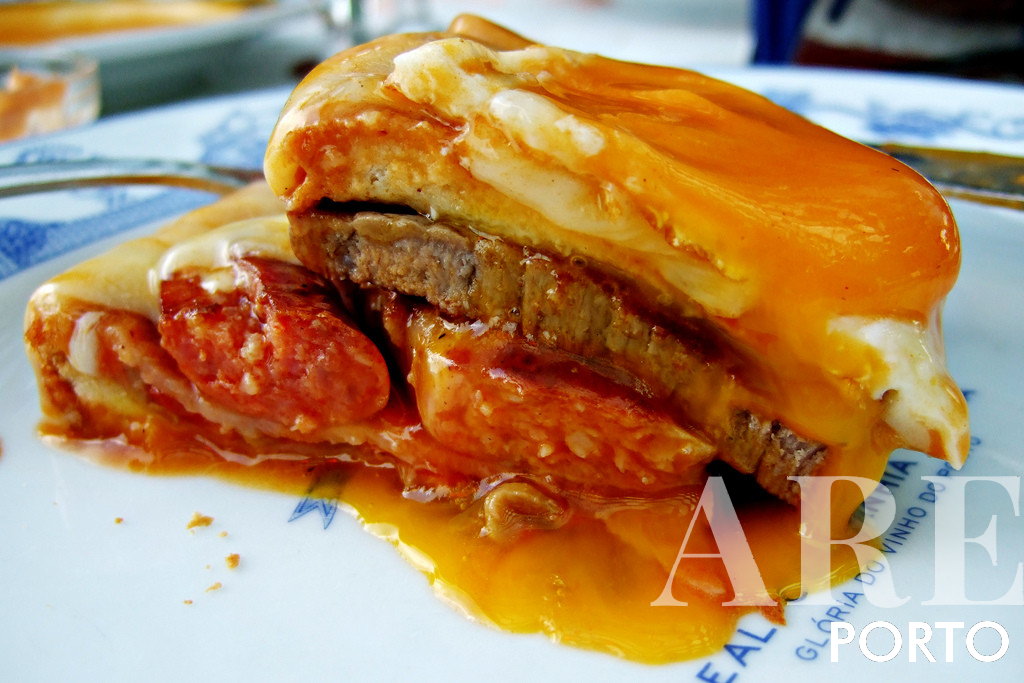
Francesinha is a Porto specialty consisting most commonly of sausage, fresh sausage, ham, cold meat and beef steak, covered with cheese and tomato-based sauce, beer and piri-piri, variation of the French croque-monsieur sandwich
- Francesinha à Moda do Porto
- Maçapão
- Pão-de-ló
- Papos de Anjo de hóstia
- Tuna Pate à Sapateira
- Octopus with Green Sauce
- Tripas à Moda do Porto: dobrada de vitela com enchidos e feijão branco
The gastronomy of Porto would not be complete without mentioning Port wine, known as nectar of the gods. Port wine is produced in the oldest wine region in the world, with the creation of the Companhia Geral das Vinhas do Alto do Douro in 1756 by the Marquis of Pombal. Port wine is grown on the banks of the Douro River. This river rises in the Sierra de Urbión in Spain at more than 2200 meters of altitude. The hydrographic network of the Douro has an area of 18558 km2 and a total of 930 km, of which 323 km are Portuguese. Port wine was transported, until 1965, in the traditional rabelo boats that went down the Douro River to the mouth of Vila Nova de Gaia and Porto to be stored and sold. The last rabelo boat trip was made in September 1965 with the construction of the Carrapatelo dam. Rabelo boats are used for regattas, tours and cruises on the Douro River. Currently, port wine is transported in tank trucks.
Neighboring towns to visit near Porto
- Amarante: city with about 12 thousand inhabitants. Its main highlights are the Tâmega River, the Amarante Golf Course, the Alvão Natural Park, the São Gonçalo Church and the São Gonçalo Bridge.
- Baião: city with about 3300 inhabitants. It is the municipality with the highest percentage of green area and forest in the district of Porto, about 63% of its territory. The main highlights of Baião are Serra da Aboboreira, Serra do Marão, Serra do Castelo de Matos, the Douro, Teixeira and Ovil rivers.
- Gondomar: city in the district of Porto with about 30 thousand inhabitants, is known for its filigree and gold. Its most important activity is jewelery.
- Maia: city with about 41 thousand inhabitants. It is in the municipality of Maia that Francisco Sá Carneiro Airport is located. Maia has a vast heritage, namely the Roman-Gothic Church of Águas Santas, the Conventual Church of São Salvador de Moreira, the Museum of History and Ethnology of the Terras da Maia and Quinta da Gruta.
Maia stands out for its cultural activity: Music Festival, Theater Festival, the Craft Fair in Portugal, World Press Photo. The city of Maia has, since 1987, a Zoo with about 100 species of animals.
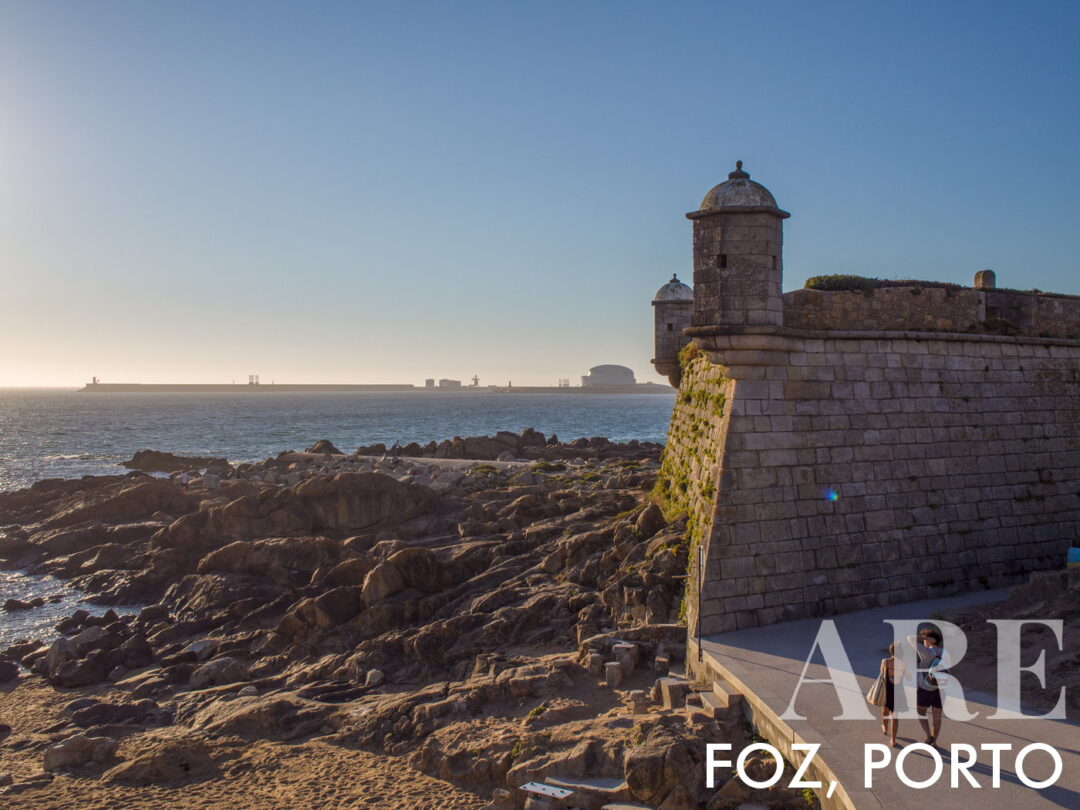
Fort of São Francisco Xavier, known as Fort of Cheese. Located at João Gonçalves Zarco Square
- Matosinhos: city with about 31 thousand inhabitants. Matosinhos is characterized by gastronomy, namely fish, seafood on the coast and meat in the interior. Matosinhos has a rich and varied heritage: the Boa Nova Tea House, the Tides Pool built between the rocks, the Casa de Santiago, the Fort of Nossa Senhora das Neves, the Church of Bom Jesus de Matosinhos. Matosinhos beaches are known all over the country for the blue flag and for being ideal for surfing: Angeiras beach, Memory beach, Cabo do Mundo beach, Boa Nova beach and Leça beach.
- Póvoa de Varzim: city with about 40 thousand inhabitants. Póvoa de Varzim has been linked to fishing since its foundation, since it has an Atlantic front of 13 km.
Póvoa de Varzim has several beaches: Barranha, Estela, Codixeira, Pedras Negras, Paimó, Esteiro, Coim, Quião, Santo André, Fragosa, Lagoa, Bridges and Fragosinho. Póvoa de Varzim has a place where you can see the whole region: Monte de São Félix in the Serra de Rates at an altitude of 202 meters.
- Santo Tirso: city with about 14 thousand inhabitants. The municipality of Santo Tirso is marked by the strong presence of nature, being crossed by the rivers Leça and Ave, where it is possible to stroll the Passeio das Margens do Ave. Santo Tirso is the land of convents and monasteries: Convento da Bela, Monastery of São Bento, Convent of the Poor Clares, Monastery of the Visitation, Convent of Santa Cruz Scholastic, Shrine of Our Lady of the Assumption.
- Vila do Conde: city with about 29 thousand inhabitants. Vila do Conde has 18 kms of beaches (Turismo beach, Srª da Guia beach, Lagrube beach and Mindelo beach) and a very strong contact with nature, which is visible in the city’s numerous gardens and parks: Praça José Régio , Praça da República Garden, Alameda dos Descobrimentos Garden, Júlio Graça Garden and João Paulo II Urban Park. Vila do Conde has a Protected Landscape, the Ornithological Reserve of Mindelo, the first protected area in Portugal. Vila do Conde is part of the Camino de Santiago.
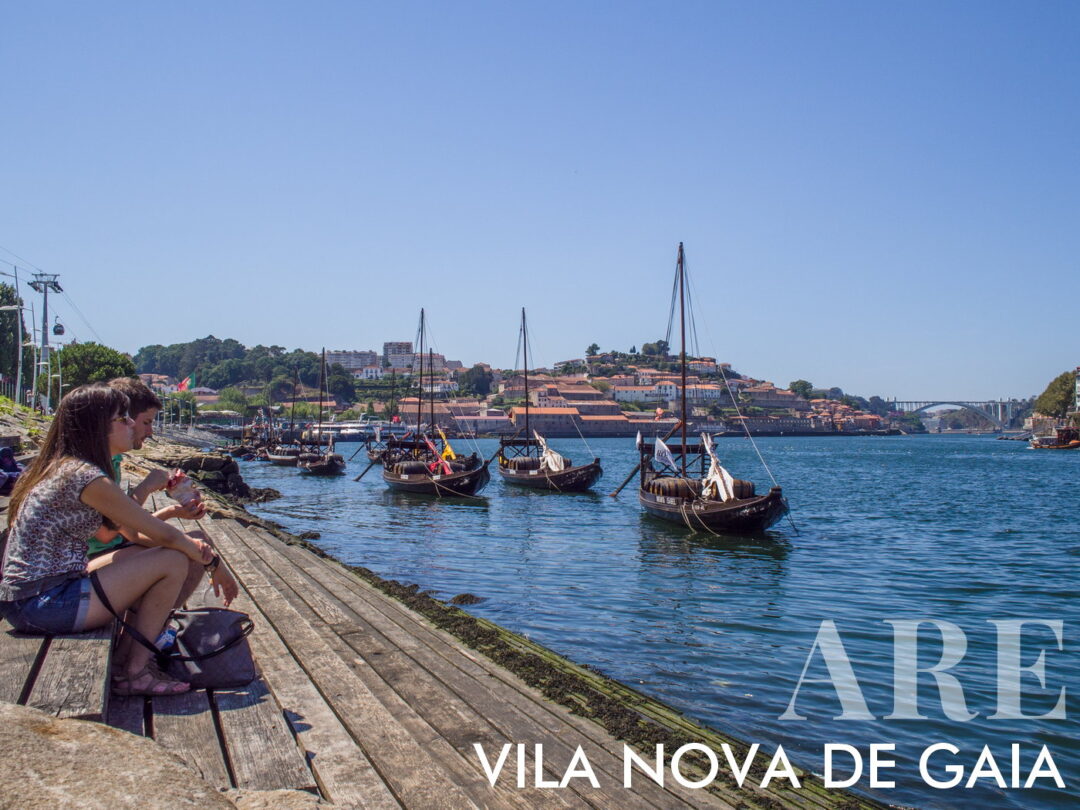
Coastline of Vila Nova de Gaia in front of the Port wine cellars area, the Rabelos boats on the Douro river, and the Arrábida bridge on the horizon
- Vila Nova de Gaia: third most populous municipality in Portugal with around 300 thousand inhabitants and the most populous in the North. Vila Nova de Gaia is known worldwide for port wine, the automobile industry and its artists. This city has a rich heritage, namely the Teixeira Lopes House-Museum, the Solar dos Condes de Resende, the Casa da Cultura, the Arcos de Sardão Aqueduct, the Amoreiras Aqueduct, the Serra do Pilar Monastery, the Grijó Monastery , the Pedroso Monastery, the Corpus Christi Convent, the Senhor da Pedra Chapel, the Bom Jesus Chapel, the Maria Pia Bridge, the Luís I Bridge, the Arrábida Bridge, the São João Bridge, the Freixo Bridge, the Ponte do Infante, the Crestuma / Lever dam and the numerous Port Wine Cellars. Vila Nova de Gaia has a strong connection to nature and activities practiced in the open, which is visible in the various structures that exist in the municipality, namely: Biological Park, Dunes Park, Castelo Botanical Park, Quinta das Devesas Park, Ponte Park Maria Pia, Local Nature Reserve of the Douro Estuary, Litoral da Aguda Station, Ribeiras de Gaia, Santo Inácio Zoo and Cantinho das Aromáticas, one of the few urban farms that practices organic farming across Western Europe. Vila Nova de Gaia is the municipality with the most blue flag beaches in the whole country: Lavadores beach, Salgueiros beach, Canide Norte beach, Canide Sul beach, Madalena Norte beach, Madalena Sul beach, Valadares Norte beach, Valadares beach South, Dunas Mar beach, Francemar beach, Francelos beach, Sãozinha beach, Senhor da Pedra beach, Miramar beach, Mar e Sol beach, Aguda beach, Granja beach and São Felix da Marinha beach.
Transport in Porto
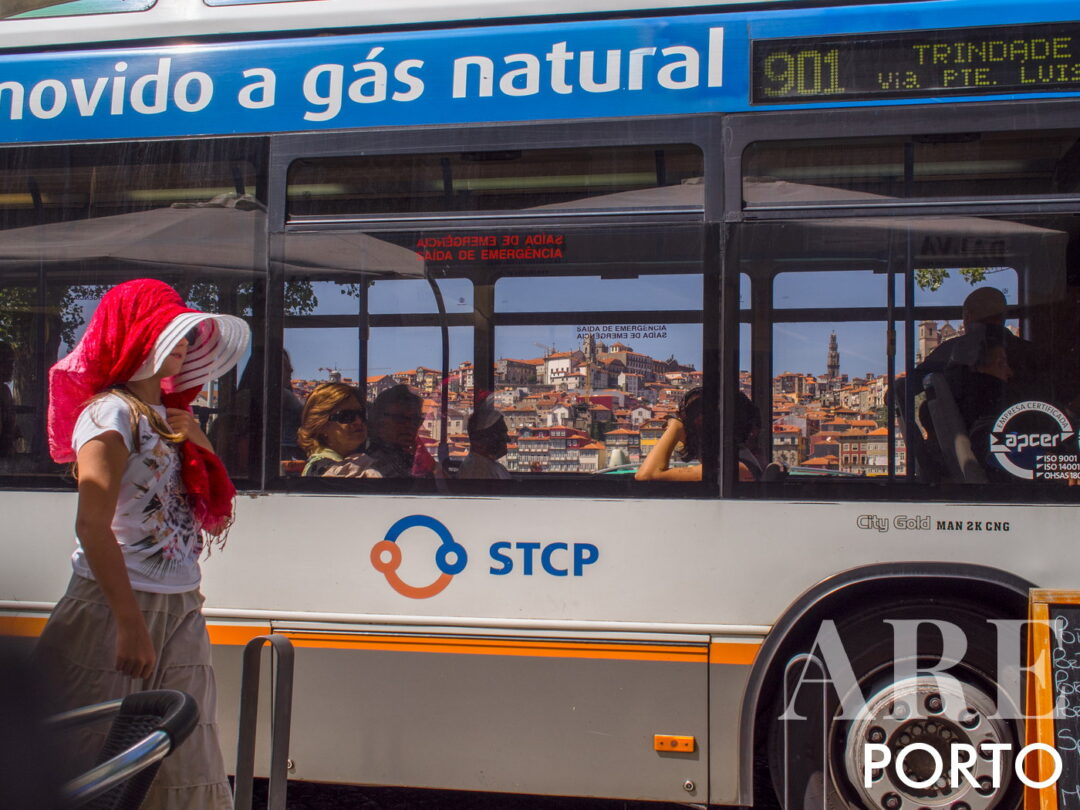
Porto transport, with the city on the horizon
The city of Porto has an access network that offers several means of transport: plane, bus, car, boat, train or metro.
Porto Airport
Francisco Sá Carneiro Airport, located about 11 kms from Porto, is modern and holds several awards, namely the third best airport in Europe in 2015, offering 64 destinations, among which are Barcelona, Milan, Manchester or Bilbao, and 14 airlines. You can reach the airport by bus and metro.
Driving in Porto
If you choose to use a private car, you have the national access roads to the city, which are free of charge, or the highways, which are tolled: A1 Lisbon with connection to the Algarve; A3 Valença (Minho) with connection to Galicia; A4 Amarante (Trás-os-Montes) with connection to Bragança; A28 (Porto-Cerveira) and A29 (Porto-Aveiro / Cantanhede). To travel on these toll roads, a more comfortable form of payment is available: EASYTOLL, TOOLCARD, TOOLSERVICE and temporary greenway rental. Porto is about two hours away from Galicia, approximately three hours from Lisbon and five hours from the Algarve.
Buses in Porto
Porto has an International Bus Transport Terminal that makes it possible to move to the city center.
The city of Porto has a network of international trains, Alfa Pendular, Intercidades, Inter-Regional, regional and urban trains that are the best in Europe. There are two main stations worth visiting:
- Campanhã Station: it is the busiest in the city
- São Bento Station: it is the most central of the city
Trains in Porto
Urban trains connect Porto to cities such as Vila Nova de Gaia, Espinho, Guimarães, Braga, Viana do Castelo and Aveiro.
It is possible to reach Porto by boat. There are two marinas in the city:
- Marina do Freixo: located on the right bank of the Douro River, it has room for 76 vessels up to 16 meters in length, berthing of vessels up to 100 meters, spas with hot water, cafeteria and restaurant open to the general public and technical support for all types of vessels
- Marina do Porto Atlântico: located in Leixões, on the Atlantic Ocean, this marina offers toilets, changing rooms, restaurant, customs, shipyard, 170 parking spaces up to 30 meters in length, four yacht clubs, mechanical service maintenance, supermarkets, banks, shops and post offices
The port of Leixões is the second largest artificial port in the country and is 4 km north of the mouth of the Douro River, close to the city of Porto. It is the largest port infrastructure in the North of Portugal with 5 km of wharf. The port of Leixões represents 25% of Portuguese international trade and around three thousand ships pass through here every year with all types of cargo. The port of Leixões saw the opening of a cruise terminal in 2015, with 111 cruise ship stopovers and about 127,000 passengers expected by 2018.
Metro do Porto
The Porto metro was considered the largest project in the European Union due to its length, about 60 km of lines. Today, the Porto metro runs between 6:00 am and 1:00 am every day and has six lines:
- Line A (Blue): Estádio do Dragão-Senhor de Matosinhos
- Line B (Red): Estádio do Dragão- Póvoa de Varzim
- Line C (Green): Campanhã-ISMAI
- Line D (Yellow): Hospital São João-D João II
- Line E (Violet): Estádio do Dragão-Aeroporto
- Line F (Orange): Senhora da Hora-Fânzeres
Porto has three tram lines:
- Line 1: Infante / Passeio Alegre
- Line 18: Massarelos / Carmo
- Line 22: Battle / Carmo
One of the city’s ex-libris is the Guindais funicular, an elevator that connects the area of Batalha to the area of Ribeira. Each ticket costs € 2.50.
Bicycle Port
In Porto we can travel through a large part of the city by bicycle, with six cycle paths that cover a large part of the urban area:
- Asprela Cycle Path: it has a length of 3.5 km and was built in 2012
- Prelada Bike Path: 1.24 km long and opened in 2011. Can be used as a way to get to the city center
- Marginal Cycle Path: starts at Parque da Cidade, next to Edifício Transparente and ends at Largo António Cálem. It has about 7 km and was inaugurated in 2007
- Parque da Pasteleira Bike Path: it is inserted in Parque da Pasteleira, has 0.7 km and was inaugurated in 2009
- Foz da Ribeira da Granja Bike Path: starts at Parque da Cidade and ends at Largo António Cálem, has a length of 3.8 km and was inaugurated in 2009
- Avenida da Boavista cycle path: goes from Praça de Gonçalves Zarco to Avenida do Parque, is 2.2 km long and was inaugurated in 2011
Porto Crafts
Porto handicrafts, namely Gondomar filigree, Vila do Conde bobbin earthen blankets, Felgueiras lace, painted tin toys from Maia, ceramics and wooden toys from Vila Nova de Gaia, palm hearts paper, feathers and straw, embroidered wax candles and the rabelo boat, traditional port wine transport, are an important tourist attraction.
A textile industry
Porto has always been a commercial city since its foundation. Porto’s economy bases its activity on three main sectors: agriculture, commerce and industry. Porto is the Portuguese capital of the textile and clothing industry (19% of companies), metallurgical industries (17%), wholesale and retail trade (27% of companies), real estate, rental and services provided to companies (24 %), health and social action (9%) and civil construction (7%) In addition to these industries, Porto develops activities in jewelery and graphic arts.
Porto growing …
From the 1990s, Porto became part of the main networks of cities in Europe, namely: Eurocities Association, Cities of the Atlantic Axis, Association of Riverside Municipalities of the Douro of Portugal and Spain and Clube das Eurometrópoles. Integration in organizations of this type has led to sustainable economic growth.
The success of this economic development policy was recognized in the study “European Cities and Regions of the Future 2014/15” published by the British daily Finantial Times by placing the city of Porto in third place in the list of the ten most attractive cities in Southern Europe for the foreign investment. In front of him were Lisbon, in second, and Barcelona, in first place. In this same study, the capital of the North appears in fifth place among the medium-sized cities in Europe with the best foreign direct investment strategy. This study is published twice a year in the Finantial Times.
Porto is the first Portuguese city to receive an award from the World Council on City Data in recognition of the policies it has implemented for a better sustainable development of the city and its citizens. The northern capital is even ahead, in certain indicators, of cities Barcelona, London, Milan, Paris and Rotterdam. This distinction means that Porto is a city that offers an excellent quality of life to its citizens.
Quick facts about Porto
- Population: about 238 thousand inhabitants
- Population of the Metropolitan Area of Porto: about 2 500 000 inhabitants
- Area: 41.42 km2
- Number of parishes: 7, namely: Union of Parishes of Aldoar, Foz do Douro and Nevogilde; Bonfim; Campaign; Union of Parishes of Cedofeita, Santo Ildefonso, Sé, Miragaia, São Nicolau and Vitória; Union of the Parishes of Lordelo do Ouro and Massarelos; Paranhos; and Ramalde.
- District: Porto
- Municipalities: 18, namely: Amarante; Baião; Felgueiras; Gondomar; Lousada; Maia; Marco de Canaveses; Matosinhos; Paços de Ferreira; Walls; Penafiel; Port; Póvoa de Varzim; Santo Tirso; Trofa; Valongo; Vila do Conde; and Vila Nova de Gaia.
- Former province: Douro Litoral
- Museums: 13
- Hospitals: 23
- Number of companies: 45276 with a turnover of around € 44.9 billion
- Main river: Douro
- Airport: 1
websites of interest related to Porto
- Porto Card: A free entry card and discounts at more than 150 points of interest. Valid for 1, 2, 3 or 4 days with or without free and unlimited access to public transport. Available from € 6.00!
https://visitportoandnorth.ecwid.com/ -
Porto City Council: The public entity responsible for the city of Porto


